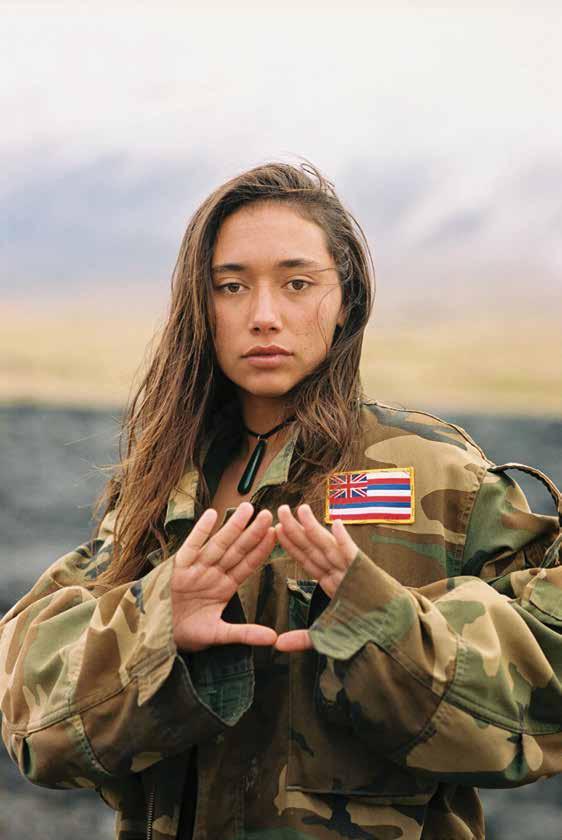
Special Section: Beauty Stylish interpretations of local fashions from the past, present, and near future.
Explore: Treasure Hunts Seeking riches at the islands’ largest swap meet, spiritual zen from a radical temple, and home away from home in Madeira.
Features: Costs of Prosperity Houseless families settle into experimental dwellings, faces lost to history resurface, and activists stand firm to protect a sacred mountain.
The CURRENT of HAWAI‘I Theme: Wealth Volume 9 Issue 3 0 03 > 0928 1 $14.95 US $14.95 CAN 2548 98

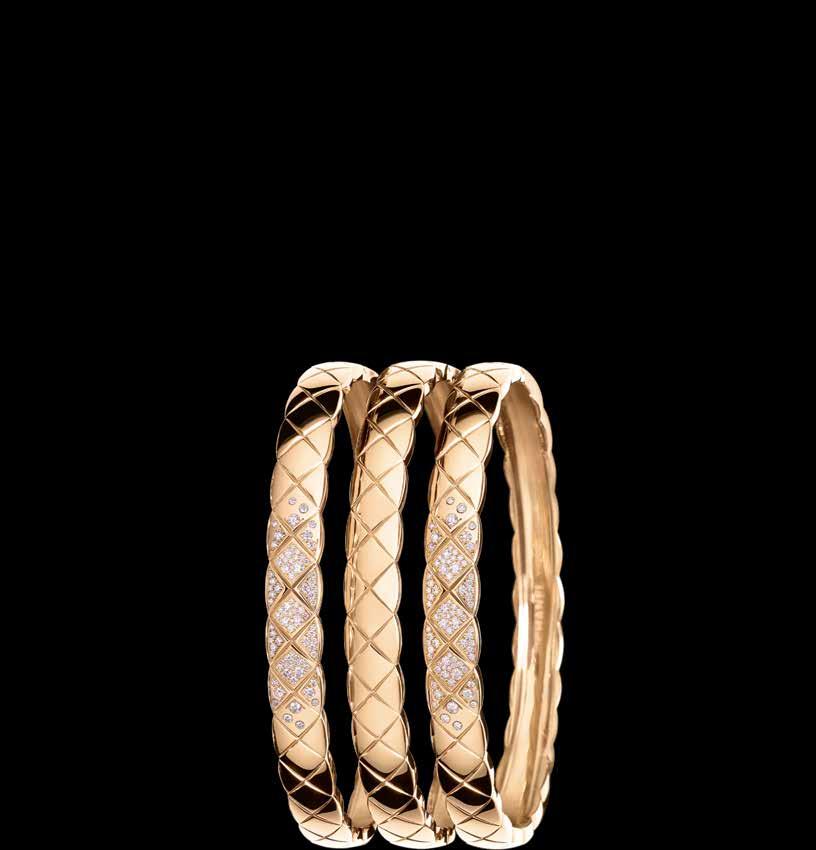

 KEIRA KNIGHTLEY WEARS A COCO CRUSH RING AND BRACELETS IN 18K WHITE GOLD* WITH DIAMONDS AND 18K BEIGE GOLD.
ALA MOANA CENTER LUXURY ROW ©2019 CHANEL ,® Inc.
*White gold plated with thin layer of Rhodium for color.
KEIRA KNIGHTLEY WEARS A COCO CRUSH RING AND BRACELETS IN 18K WHITE GOLD* WITH DIAMONDS AND 18K BEIGE GOLD.
ALA MOANA CENTER LUXURY ROW ©2019 CHANEL ,® Inc.
*White gold plated with thin layer of Rhodium for color.


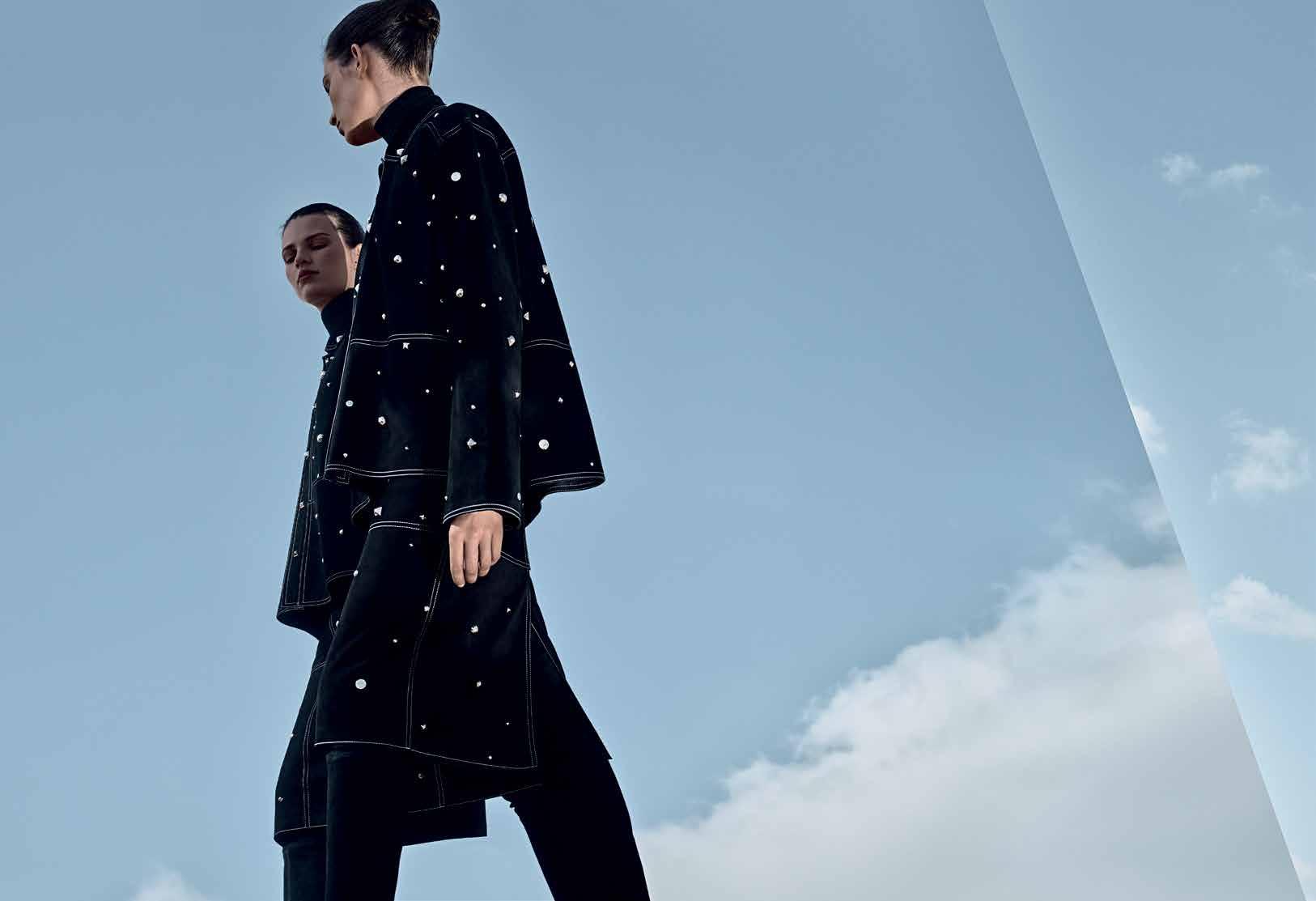

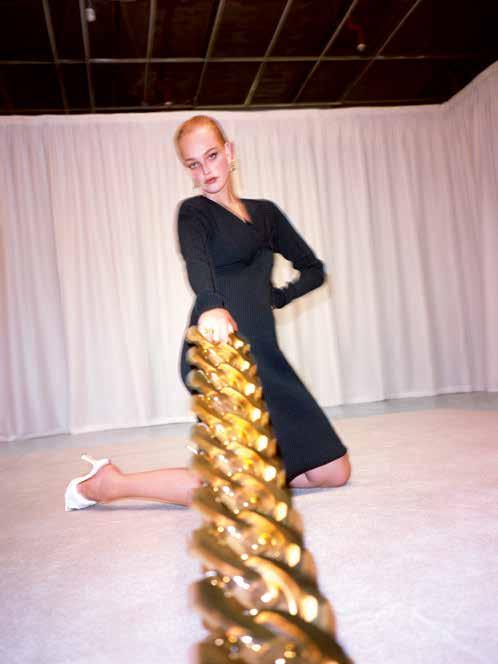
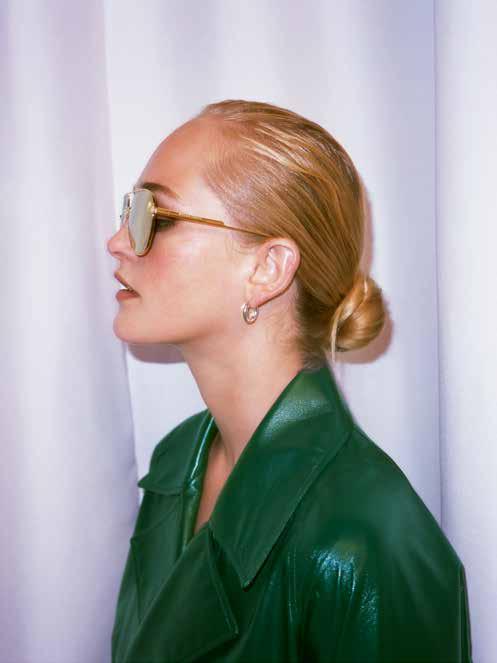
Editor’s Letter
Contributors
24 | Community Waihe‘e Valley Country Club
36 | Vintage @fotoaloha
42 | Finance Parental Leave A HUI HOU
184 | In the Wai
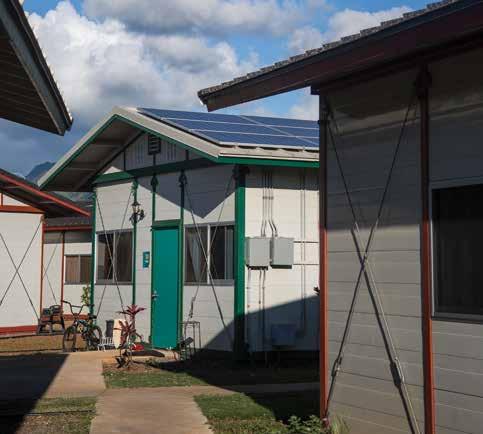
FEATURES
46 | Promised Land
Kahauiki Village has been heralded as a disruptive model for solving homelessness. But is it actually putting a vulnerable population at risk? Writer Timothy A. Schuler reports on the project’s path to completion and the potential hazards of its built environment to residents.
60 | The Hunt for George Gilley
The uncharted tale of history’s only Native Hawaiian whaling captain, culled from an archival abyss of explorer logs, scholarly mentions, and aging newsprint. Writer Travis Hancock pieces together Gilley’s historic and hidden biography.
74 | For the Love of Lāhui
At the base of Maunakea, the work of kia‘i, both old and young, are electrifying a new generation to reclaim their identities and culture. Writer and activist Jamaica Osorio shares an insider’s perspective tracking the growth of the movement, and original poetry inspired by the mauna.
92 | From the Rubble
Photographer Francis Haar documented parts of Chinatown and Pālama, known as ‘A‘ala in the 1960s, while they were being demolished. Writer Michelle Broder Van Dyke recontextualizes Haar’s final and lasting images of a Honolulu that has since disappeared.
TABLE
| FEATURES | 22
OF CONTENTS
WEALTH
FLUX
PHILES
Image by Marie Eriel Hobro.

TABLE OF CONTENTS
SPECIAL SECTION
BEAUTY
In these explorations of local fashions from our historic past and an imagined future, creatives across the spectrum prove that beauty truly is in the eye of the beholder.

Oakland-based artist Tiare Ribeaux draws on the biomorphic and natural shapes of her Hawaiian upbringing to fashion a living, breathing alternative to the single-use plastics polluting Pacific ecosystems. Image by Peter Prato.
106
|
DEPARTMENTS |
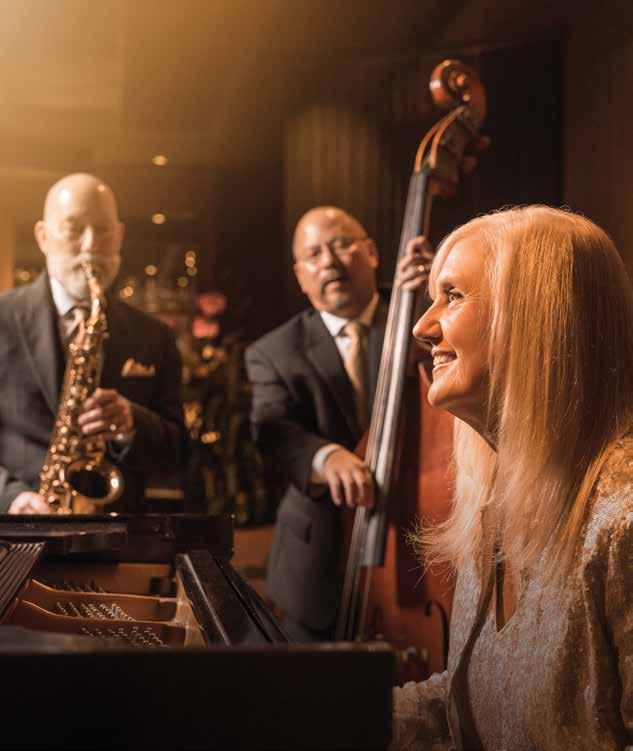

TREBLE AWAITS... Halekulani’s destination for live music, late night libations, designer cocktails and fine foods. COMPLIMENTARY PARKING | 855.738.4966 | 2199 KALIA ROAD, HONOLULU | WWW.HALEKULANI.COM

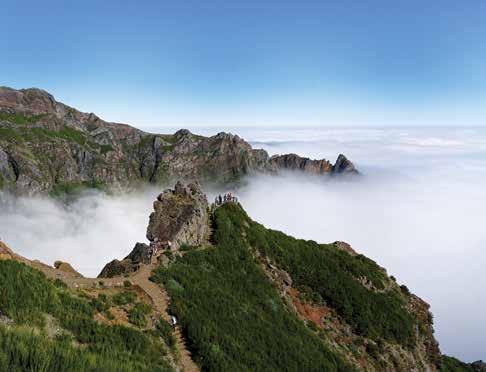
160 EXPLORE 162
174
134 LIVING WELL 136
| Madeira Funchal
| Swap Meet Aloha Stadium
| Design Charlot House
TABLE OF CONTENTS | DEPARTMENTS |
148 | Rinzai Chozen-ji
Image by Colin Watts.
Image by John Hook.
Walk to ownyourbeat.
Introducing the Huaka‘i Collection, designed for voyaging city currents.
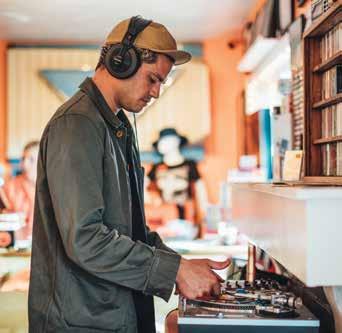
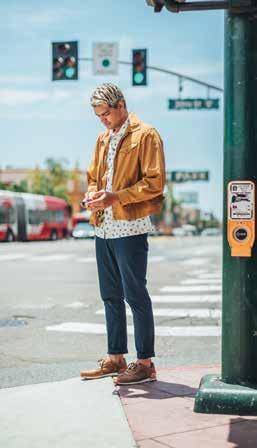



OLUKAI.COM / #ANYWHEREALOHA
HUAKA‘I LĪ
Visit us at Whalers Village on Maui and at Hilton Hawaiian Village on O‘ahu
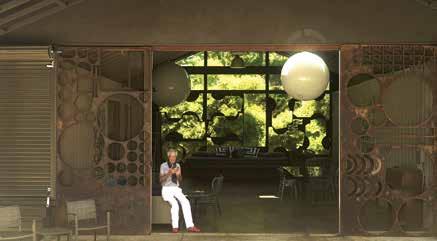
Heavy Metal
Multi-media artist Tom Sewell sees art where others see decay. In one of his most ambitious installations, he repurposed massive metal plates discarded by Maui’s last sugar mill and assembled them into large-scale sculptures that are sprinkled across his 17-acre estate in Ha‘ikū. This sprawling work of land art is “all about finding art in unexpected places,” Sewell says, and serve as a tribute to the “magnificence of the mundane and the art of industry.”
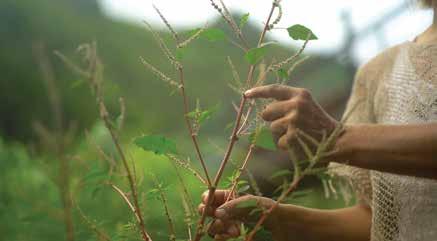
Where the Wild Foods Grow
Through education in foraging, harvesting, and cooking wild plants, Sunny Savage shares how to identify edible plants in one’s backyard, at the park, and around the planet. “Hawai‘i is magical in so many ways—it’s a foraging paradise,” Savage says. “There are so many beautiful ways of tasting the land.” Her philosophy around integrating weeds into one’s daily diet breaks down preconceived notions about invasive species and food nutrition.
fluxhawaii.com
/fluxhawaii
@fluxhawaii
@fluxhawaii
TABLE
| FLUX TV | FLUX TV
arts
culture
us at:
OF CONTENTS
Stay current on
and
with
HYATT REGE NCY WAIKIKI
ALA MOANA CE NTE R KO KO MARI NA WI NDWARD M ALL

GAT E WAY
WAIKELE
LocalMotion .com HAWAI
LAHAINA
It can often feel like the only time you truly own something is when you can’t put a price on it.
Perhaps it was the invigorating country-hopping travels you embarked on recently, or just a film you watched that was so illuminating it cracked open your world view. Of course you likely anteed up some dollars and cents for those flights, for the ticket of admission, but what it actually afforded you, and you alone, was the way in which it left a part of you transformed. It’s in that unquantifiable exchange which managed to shift something in your own personal chemistry where you might feel a sense of belonging.
To my fortune, I find myself careening a similar train of thought near the close of each issue of this very magazine: Editing it is a source of my income, but it’s in the lessons learned about the people and places they feature where I feel I’ve really profited. The process of production itself proves to be a personal and collective reward: When our team of writers and designers are entrenched in the process of shuffling through pages of revisions, debating photography and layouts, marrying copy to art, eventually a peculiar creative alchemy takes over, unannounced, where the content begins to resemble a shape and cohere—the relief in seeing something reflected back in relief!— and it is in those unsuspecting strokes of surprise and inspiration where putting this publication together always feels worth it.
In this issue on Wealth, we wanted to focus on those moments of fulfillment. To take a look at the motivating factors that produce them and their repercussions. These stories pinpoint crossroads in which new models contending with everything from economic inequity to political sovereignty are being tried and tested right here in our own backyards. In that spirit, this edition aims to reflect a commerce of ideas, peddled by writers with an unwavering allegiance to truth and art and the wellbeing of their greater communities. And for that we are all richer.
With aloha,
Matthew Dekneef EDITORIAL DIRECTOR @mattdknf

| WEALTH |
EDITOR’S LETTER

As physicians, Jon and Toni Narimasu enjoy peace of mind knowing their private banker is going above and beyond to help their family achieve their financial goals. For this generation and the next. Learn how our wealth management advisors can do the same for you. Call 544-3542. Investments are not insured by FDIC or any government agency. Not a deposit or obligation of or guaranteed by Central Pacific Bank. Subject to investment risks, including loss of principal invested. Looking ahead and going beyond. centralpacificbank .com 808-544-0500 1-800-342-8422 WEALTH MANAGEMENT
MASTHEAD
PUBLISHER
Jason Cutinella
CREATIVE DIRECTOR
Ara Laylo
EDITORIAL DIRECTOR
Matthew Dekneef
MANAGING EDITOR
Lauren McNally
SENIOR EDITORS
Anna Harmon
Rae Sojot
SENIOR PHOTOGRAPHER
John Hook
PHOTOGRAPHY EDITORS
Samantha Hook
Chris Rohrer
DESIGNERS
Michelle Ganeku
Skye Yonamine
EDITORIAL ASSISTANT
Eunica Escalante
CONTRIBUTORS
Michelle Broder Van Dyke
Alexis Cheung
Sonny Ganaden
Travis Hancock
Spencer Kealamakia
Brendan George Ko
Leilani Marie Labong
Jamaica Osorio
Natalie Schack
Timothy A. Schuler
Shannon Wianecki
IMAGES
Jonathan Canlas
Francis Haar
Marie Eriel Hobro
Cheyne Kalai
Nani Welch Keli‘iho‘omalu
Michelle Mishina
Dino Morrow
Josiah Patterson
Peter Prato
Melanie Tjoeng
Lauren Trangmar
Shar Tuiasoa
CREATIVE SERVICES
Tammy Uy VP CREATIVE DEVELOPMENT
Shannon Fujimoto CREATIVE SERVICES MANAGER
Gerard Elmore LEAD PRODUCER gerard@NMGnetwork.com
Aja Toscano CREATIVE PRODUCER
Shaneika Aguilar
Kyle Kosaki
Rena Shishido FILMMAKERS
Kimi Lung
WEB DESIGNER & DEVELOPER
Romina Escano
DIGITAL DESIGNER
Chloe Ma Tomy Takemura INTERNS
ADVERTISING
Mike Wiley VP SALES mike@NMGnetwork.com
Phil LeRoy NATIONAL SALES DIRECTOR
Chelsea Tsuchida KEY ACCOUNTS & MARKETING MANAGER
Helen Chang MARKETING & ADVERTISING EXECUTIVE
Kylee Takata SALES ASSISTANT
Hunter Rapoza
AD OPERATIONS & DIGITAL MARKETING COORDINATOR
OPERATIONS
Joe V. Bock CHIEF REVENUE OFFICER joe@NMGnetwork.com
Francine Beppu NETWORK STRATEGY DIRECTOR francine@NMGnetwork.com
Gary Payne VP ACCOUNTS RECEIVABLE
Courtney Miyashiro OPERATIONS ADMINISTRATOR
General Inquiries: contact@fluxhawaii.com
PUBLISHED BY:
Nella Media Group
36 N. Hotel St., Ste. A Honolulu, HI 96817
©2008-2019 by Nella Media Group, LLC. Contents of FLUX Hawaii are protected by copyright and may not be reproduced without the expressed written consent of the publisher. FLUX Hawaii assumes no liability for products or services advertised herein. FLUX Hawaii is a triannual lifestyle publication. ISSN 2578-2053
| WEALTH |
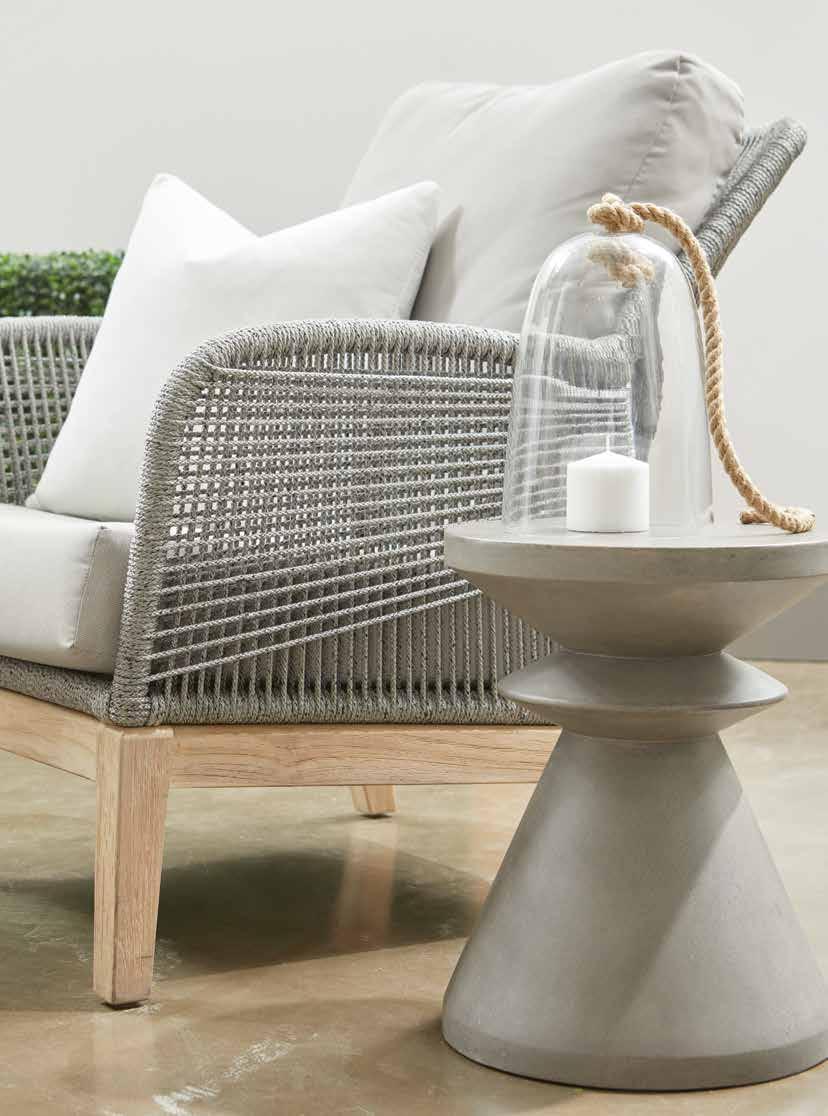
702 SOUTH BERETANIA STREET, HONOLULU, HI 808.543.5388 | CSWOANDSONS.COM
CONTRIBUTORS

On the Cover
Nineteen-year-old student Pumehana La, whose full name is Mekealohapumehanahemolele Howard, holds her hands in the shape of a triangle, a symbol of resistance and solidarity in the Protect Maunakea movement. Photographer Melanie Tjoeng took this portrait of La during a visit to Hawai‘i Island in October 2019. Through her love of music and land, La, a sophomore at the University of Hawai‘i at Mānoa in ethnic studies, political science, and Hawaiian studies, says she is driven to “finding solutions for our kānaka to ho‘i, or return, back to being on the ‘āina and with ‘ohana.” Like many others, she is spending several months at Pu‘uhonua o Pu‘uhuluhulu to preserve what Hawaiians consider to be the sacred piko of the islands.
 Travis Hancock
Travis Hancock
Originally from Paumalū, on Oʻahu's North Shore, Travis Hancock resides in Salt Lake City, where he is a doctoral student in history at the University of Utah. He has previously written for FLUX Hawai‘i about the decline of native bat populations due to wind turbines. For this issue, Hancock reconstructs the biography of George Gilley, a Native Hawaiian whaler, on page 60.
“Working on this story felt poignant, given the current climate in the islands. The opening image of 5,000 Hawaiian subjects gathered at the wharf for Kalākaua's birthday yacht race, proudly waving national flags, was duplicated this past October, when 10,000 hae-waving island protectors marched on Waikīkī,” Hancock says.
“What a role the media played in depictions of these events, past and present. And what a failing it was that Hawaiʻi’s newspapers failed to report Gilley’s death in 1900. I like to think, in a small way, this article brings his story home.”

Leilani Marie Labong
Based in San Francisco, Leilani Marie Labong writes about design, art, fashion, and travel for magazines and newspapers. Her featurelength work has appeared in Sunset, House Beautiful, San Francisco Chronicle, C Magazine, Coastal Living, Luxe Interiors + Design, 7x7 Magazine, and California Home + Design. Her travel memoirs have been published in such book anthologies as The Best Travel Writing 2005 and A Woman’s Asia. She received an MFA in Writing from the University of San Francisco in 2004 and is the former editor in chief of Habitat, the SF Chronicle's home and style magazine, and the Season 1 host of 7x7’s podcast, People Will Talk, featuring interviews with Bay Area mavericks. Labong’s first piece for the magazine, “Fabric of Life,” on page 128, profiles artist Tiare Ribeaux’s work with bioplastics.

Timothy A. Schuler
Timothy A. Schuler was born and raised in rural Kansas. An award-winning journalist whose work focuses on the built and natural environment, his writing has appeared in the Atlantic, Metropolis, Vox Media, and Places Journal. For this issue, he wrote about the experimental housing project Kahauiki Village, on page 46. “Housing is one of the biggest challenges Hawai‘i faces, and inseparable from issues of race, income inequality, and environmental justice. A key moment in reporting this piece came when I discovered that the word for air in the Hawaiian ‘ōlelo can also mean sovereignty. It was a reminder that language and culture are powerful frames through which to view contemporary issues.” Based in Honolulu, he is a contributing editor at Landscape Architecture Magazine and frequent contributor to NMG Network.
| WEALTH |
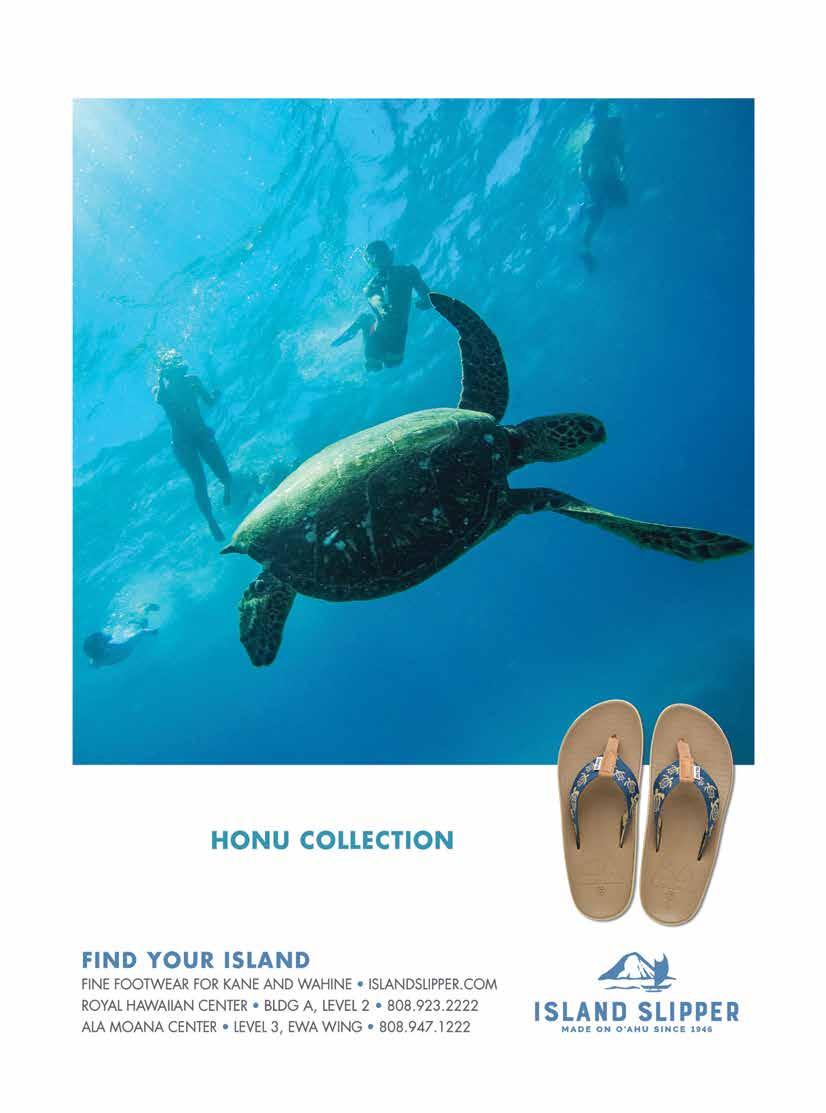
An offering of water at Pu‘uhonua o Pu‘uhuluhulu beneath the slopes of Maunakea. Image by Dino Morrow.
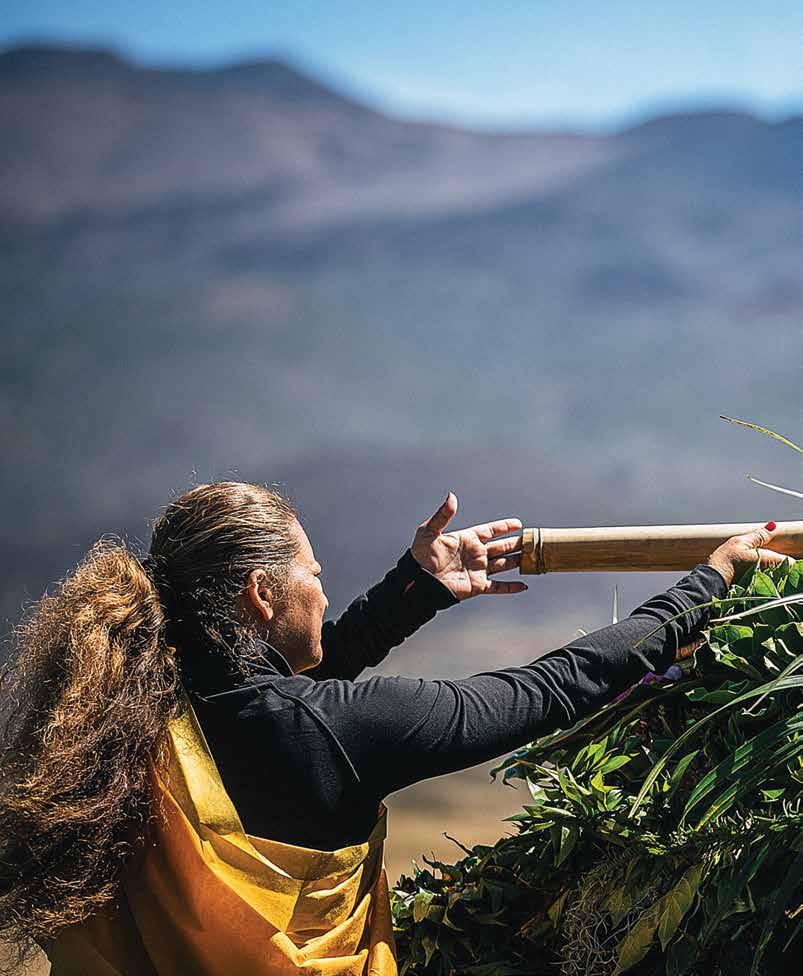
WEALTH
“Breakdown is our epistemic and experiential reality. What we really need to study is how the world gets put back together.”—Shannon
Mattern


The Journey Home
By returning to a backcountry lifestyle in Waihe‘e, Maui, a group of friends reconnect with their ancestors to further understand who they are.
TEXT AND IMAGES BY BRENDAN GEORGE KO
Legend and tradition grew up about the hills and valleys of Hawaii. The urge for deep-sea adventure decreased and interest narrowed to the coastal seas. Voyaging canoes ceased to sail out from the channel of Ke Ala-i-Kahiki (The Road-to-Tahiti) and trim their course for the Equator. The long sea voyages of the northern rovers had ended—Hawaii had become home.
– Te Rangi Hīroa, Vikings of the Sunrise, 1938
“We are trying in any way possible to get back to how our ancestors had lived and flourished,” Miki‘ala Pua‘a Freitas says one night in her valley home, the subtle sound of the river flowing in the background. In December 2018, she had moved from her farm into the valley where her father and kūpuna had lived and left behind a shack, lo‘i kalo, choke mosquitos, overgrown cane grass, and an ineffable peace. She jokingly calls it the Waihe‘e Valley Country Club, a place on Maui where friends of hers from throughout Hawai‘i gather to work, share, appreciate, learn, see, and value the world like those who understood this place better than anyone else. A sign from the defunct country club from which the name originated is nailed to the entrance of the shack.
Before arriving in Hawai‘i, Polynesians were largely defined by their oceanic courage and ingenuity. Their homes and cultures revolved around the ocean. The god of the ocean, Kanaloa, was one of the highest gods in the Polynesian pantheon, and canoes as well as paddles were dedicated to him. But after long voyages from Henua Enata (Marquesas), Samoa, Tahiti, and Ra‘iātea, the settlers in the Hawaiian archipelago found something that made them dig into the valleys and turn their eyes, once drawn to the ocean-lined horizon, to that of mountain ranges. The god of the land and forest, Kāne, and of peace and agriculture, Lono, grew in importance as the people’s roots grew deeper into this ‘āina. As a result, wa‘a moana (deep-sea ocean canoes) disappeared until the Hawaiian Renaissance inspired the construction of the Hōkūle‘a in 1975.
The life-nourishing promise of Hawai‘i heavily influenced the ancestors who decided to stay here. They introduced kalo, ‘ulu, and ‘uala, which grew plentifully in the rich volcanic soils. Individual tribes transitioned into families within districts, and entire islands came to be ruled by powerful chiefs. Nā maka‘āinana (the commoners) worked the land in exchange for free places to live and grow with the trees and change as the rivers slowly shaped the valleys. This pace of life existed for so long that, even with European contact and the rapid change in Hawai‘i Nei that followed, it was kept deep in the memory of nā maka‘āinana. Through the surviving stories and practices and the persistence of genetic memory, the ways of old survived.
After traveling across the world, the Polynesians who settled on Hawai‘i abandoned their deep-sea ocean canoes and began to cultivate the lush land of their new home.
FLUX PHILES | COMMUNITY | 24 | FLUXHAWAII.COM

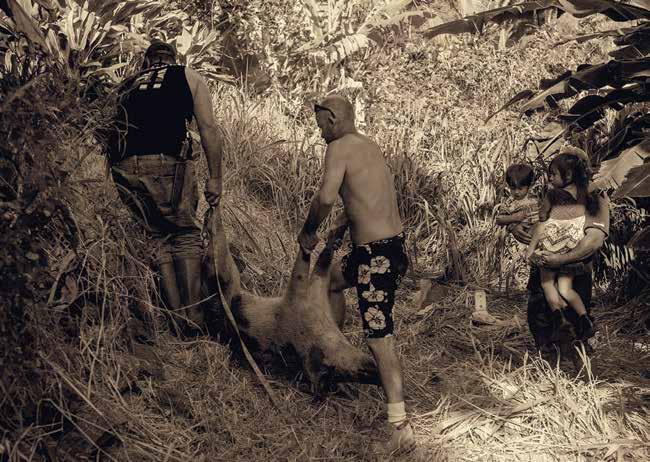
In the modern era, commoners were removed from their ancestral valleys from the results of The Great Māhele, and later by private development and the tourism industry. They worked the plantations, and then hotels, airports, and other Western occupations for monetary subsistence. Many moved off-island to places throughout North America due to housing shortages and an ever-increasing cost of living. Buried were the ways of old, in which no money was exchanged and the word mahalo didn’t exist (for to receive is to have earned already, no need to say thanks). Those who descended from Polynesian voyagers survived to see their way of life replaced by a system of capitalism and landownership completely foreign to these islands. Their population became the minority and their cultural identity was on the brink of extinction.
At Waihe‘e Valley Country Club, some of us are learning, and some of us are relearning, what is deeply ingrained in our DNA—that deep memory unbroken from the great change that has happened.
Many of us simply drop by to work or bring things for family dinners, or simply to say hi to Freitas and her dog, Mo‘o, the permanent fixtures of the club. One night, a friend of Freitas, a young fisherman named Mikey, came by with freshly caught fish and ‘opihi. We started a fire, drank some beers, and ate the fruits of the sea as the moon crept from makai to mauka. Holding an empty shell of an ‘opihi took Freitas back to her childhood, when she would find shells buried in the ground by previous generations. “When I was a little kid, cleaning the yard or planting a tree, we were so inland that whenever I would find ‘opihi shells, whether it was my grandparent, or my great-grandparent, or great-great-great-grandparent, whoever it was, somebody was enjoying them in this exact spot and chucked it out. That always made me giggle,” she said as she threw the shell into the fire.
Now in her 30s, Freitas is returning to her roots after living abroad and working as a personal trainer. By returning to that kua‘āina (backcountry) lifestyle
Freitas is returning to the kua‘āina lifestyle of her kūpuna and discovering her ancestral roots along the way.
26 | FLUXHAWAII.COM

FLUXHAWAII.COM | 27
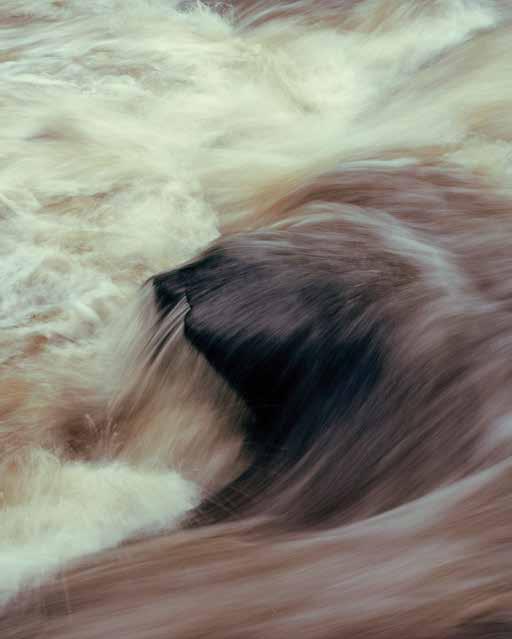
The life-nourishing promise of Hawai‘i heavily influenced the ancestors who decided to stay here.

“We are trying in any way possible to get back to how our ancestors lived and flourished,” Freitas says.
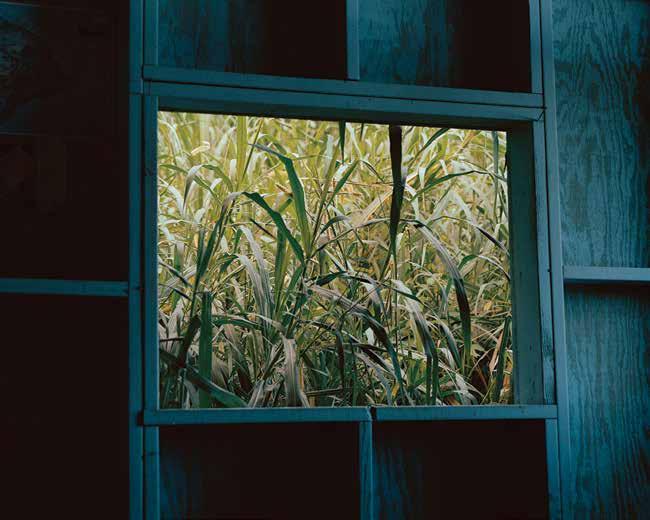 A window looking out to a field of sugarcane.
A window looking out to a field of sugarcane.
 Relaxing by the stream.
Relaxing by the stream.
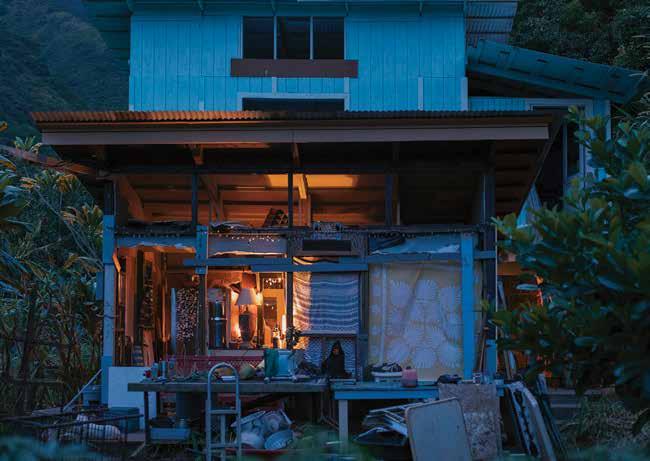
reminiscent of her kūpuna, she wants to further understand who she is. She wants to work with her hands in the very valleys they once worked. The spirit of those ancestors imbue their mana in the valley and look after her as she makes this journey. The signs of their presence are uncanny, as are the challenges they set forth to transform those who seek their ways of life and their perspectives. Those of us who come here from other occupations imagine maka‘āinana working the lo‘i kalo, cutting down the cane, and bathing in the cool rivers with a romance of a bygone era. When we visit, we get muddy and shed some blood and sweat. But to live this life daily is far from romantic.
What made those seafaring people find home here? To look back to those ancient times is to realize our ancestors never needed anything from the outside world, and so they ceased to voyage beyond the horizon. The fortunate few who still have land left to them can dig their roots in those backcountry lots and return to the ways of the old, acting as conduits to the past.
As Freitas gazes upon the ‘opihi shells among the glowing embers, she says, “I wanted to put them back into the ground, and maybe in 30, 40, 50, 80 years from now, someone will find them and say, ‘Oh, these are some nice-size ‘opihi, they were eating good!’”
Freitas moved from her farm into the valley to join the community she and friends have dubbed the Waihe‘e Valley Country Club.
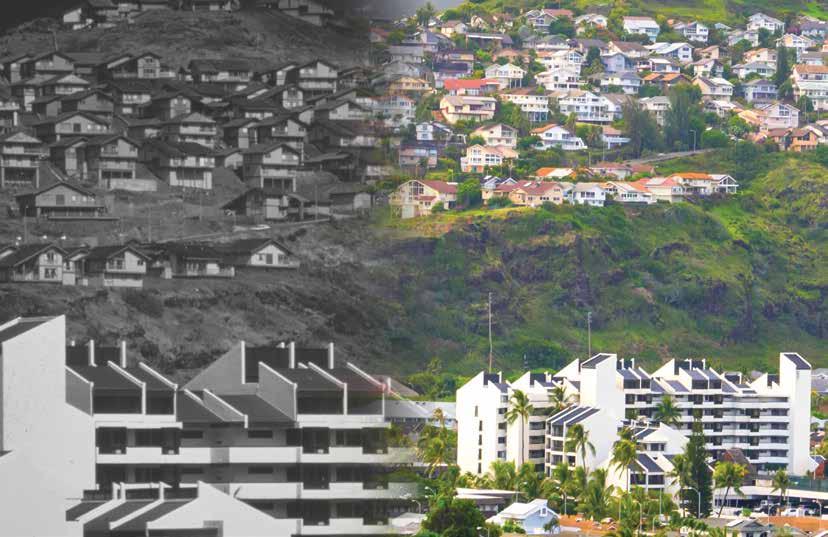
32 | FLUXHAWAII.COM


Your Trusted Neighborhood Expert RB-17095 At Locations we look beyond zip codes to give our clients one of a kind neighborhood insights to help them make the most informed real estate decisions. LocationsHawaii.com/50years
























































THIS IS NOT INTENDED TO BE AN OFFERING OR SOLICITATION OF SALE IN ANY JURISDICTION WHERE THE PROJECT IS NOT REGISTERED IN ACCORDANCE WITH APPLICABLE LAW OR WHERE SUCH OFFERING OR SOLICITATION WOULD OTHERWISE BE PROHIBITED BY LAW. WARD VILLAGE IS A PROPOSED MASTER PLANNED DEVELOPMENT IN HONOLULU, HAWAII THAT DOES NOT YET EXIST. PHOTOS AND DRAWINGS AND OTHER VISUAL DEPICTIONS IN THIS ADVERTISEMENT ARE FOR ILLUSTRATIVE PURPOSES ONLY AND DO NOT REPRESENT AMENITIES OR FACILITIES WHOLLY WITHIN WARD VILLAGE AND SHOULD NOT BE RELIED UPON IN DECIDING TO PURCHASE AN INTEREST IN THE DEVELOPMENT. FURTHER, ANY RENDERINGS, PHOTOS, DRAWINGS OR OTHER REPRESENTATIONS AS TO UNITS OR OTHER ELEMENTS OF THE PROJECT THAT ARE DELIVERED OR SHOWN TO PROSPECTIVE PURCHASERS MAY NOT ACCURATELY PORTRAY SUCH UNITS AND OTHER ELEMENTS, AND DO NOT CONSTITUTE A REPRESENTATION BY THE DEVELOPER. THE DEVELOPER MAKES NO GUARANTEE, REPRESENTATION OR WARRANTY WHATSOEVER THAT THE DEVELOPMENTS, FACILITIES OR IMPROVEMENTS DEPICTED WILL ULTIMATELY APPEAR AS SHOWN. THIS IS NOT INTENDED TO BE AN OFFERING OR SOLICITATION OF SALE. EXCLUSIVE PROJECT BROKER WARD VILLAGE PROPERTIES, LLC. COPYRIGHT ©2019. EQUAL HOUSING OPPORTUNITY.




























Curated design inside. Ocean views outside.







In the center of Ward Village.
Kō‘ula seamlessly blends an innovative, indoor design with spacious, private lanais that connect you to the outdoors. Designed by the award-winning Studio Gang Architects, every tower floor plan has been oriented to enhance views of the ocean.





Kō‘ula also offers curated interior design solutions by acclaimed, global design firm, Yabu Pushelberg. Outside, Kō‘ula is the fi rst Ward Village residence located next to Victoria Ward Park. This unique, central location puts you in the heart of Ward Village, making everything the neighborhood has to off er within walking distance. This holistically designed, master-planned community is home to Hawaii’s best restaurants, local boutiques and events, all right outside your door.

















1, 2 & 3 bedroom homes available. Contact the Ward Village Residential Sales Gallery to schedule a private tour.




808.824.4857 | koulaward.com 1240 Ala Moana Blvd. Honolulu, Hawaii 96814 Ward Village Properties, LLC | RB-21701








Picture-Perfect Paradise
Through postcards and hotel brochures, a collector endlessly pursues the golden age of Hawai‘i travel.
TEXT BY SPENCER KEALAMAKIA
IMAGES BY JOSIAH PATTERSON
There’s always something the collector wants but doesn’t have, never mind all the things the collector would want but hasn’t yet seen. In the case of Spencer Tolley, he began searching out vintage Hawai‘i ephemera in 2012, when work as a travel agent brought him from Miami to the Wai‘anae coast of O‘ahu. “I’ve been a collector of things all my life,” says Tolley, whose pursuits include first-edition books, midcentury housewares and furniture, and postcards of New York City’s Rockefeller Center. “Collecting postcards has been a constant.”
Postcards also played a part in shaping Hawai‘i’s reputation as a paradise of the Pacific. Local companies like Hawai‘i and South Seas Curio Co.; Wall, Nichols and Co.; and Island Curio Co. produced lithographic postcards that played up Hawai‘i’s sensuousness, its traditional and regal cultures, its landmarks and landscapes.
Tolley is especially interested in locally produced cards from between 1901 and 1907, the first time in U.S. Postal Service history that private companies could print postcards. Sites like eBay, where Tolley’s watchlist is maxed out at 100 items, make finding these antiques much easier, though collectors are more educated now.
Hunting down postcards has also helped Tolley learn about his new home and entertain folks online. As his collection grew, he began sharing his finds on Instagram under the name @fotoaloha. Through the account, Tolley has cultivated a vision of the islands he refers to as the golden age of Hawai‘i travel, between the turn of the 20th century and late 1941, when the United States entered World War II. In this phase of its tourism history, Hawai‘i was a hard-to-reach and expensive destination. Seats aboard Matson luxury liners and propeller planes headed to the islands were reserved for the well-heeled and adventurous. According to Tolley, ’60s jet travel and mass-marketed tourism brought that era to a close, though Hawai‘i continued to attract visitors looking for an exclusive place of retreat, isolatation, and freedom through the 1950s.
A mid-’50s Hotel Hana Maui brochure posted by Tolley sneaks us a glance, through hala and naupaka leaves, of a Hāmoa Beach scene with bathers, umbrellas, and a pink longboard arranged just so. “Every day of your stay at Hana Maui,” the copy promises, “will be pleasure-filled and exciting ... The full facilities are yours to enjoy exactly as you wish.”
For the sophisticated traveler, @fotoaloha is a time machine, a return ticket to what many consider to be the golden age of Hawai‘i tourism.
FLUX PHILES | VINTAGE | 36 | FLUXHAWAII.COM



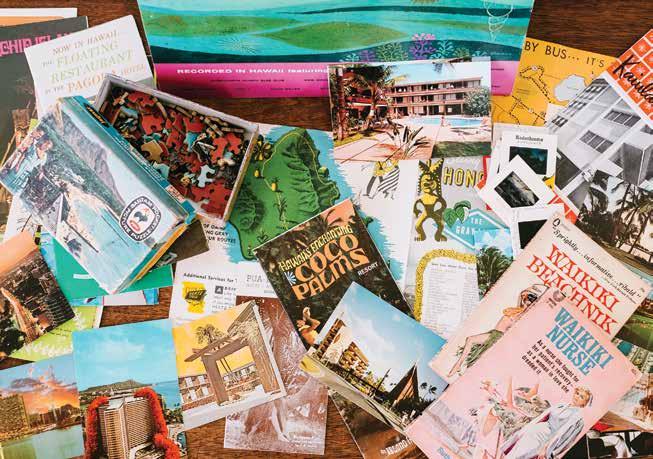
Lately, Tolley has been posting images of of Hawai‘i’s unique architecture, past and present. A postcard of the Waikikian, “Hawaii’s Most Beautiful Hotel,” shows off its wild architecture. The shape of the hotel’s “hyperbolic paraboloid” lobby roof and the ornamentation of its adjacent suites conjure the seduction and dread of attending a Skull Island sacrifice, but with cocktails shortly to follow.
“I try to think about what will be most meaningful and exciting and focus on the places that are mostly gone,” Tolley says about how he curates the Instagram account. He strives to strike a balance in what is presented rather than focusing solely on the hospitality industrial complex. “It’s not only about places tourists care about,” he says. “It’s about the lives of people who live here now, or were stationed here during
World War II, or during Korea—anyone who’s crossed paths with Hawai‘i.” Tolley is always adding to his collection and posting new items to @fotoaloha on Instagram as he gets things in the mail. And, as he says, it’s never ending.
For more than 150 years, Hawai‘i has been marketed as a vacation getaway, a fantasy, and an isolated locale, producing endless memorabilia for collectors.
Follow Tolley’s account @fotoaloha to add a dash of vintage Hawai‘i to your Instagram feed.
40 | FLUXHAWAII.COM
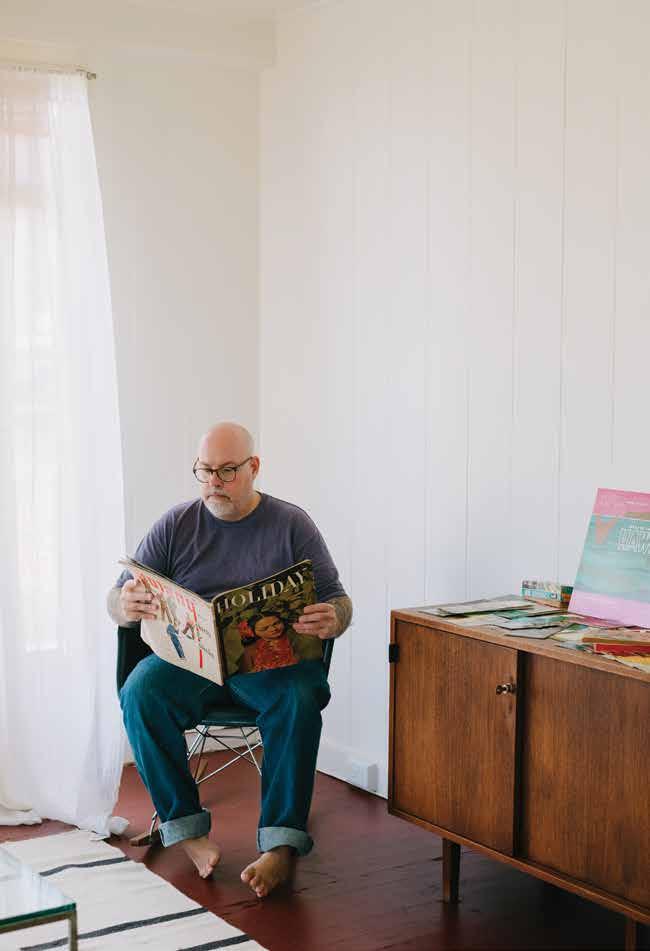
The Parent Trap
Hawai‘i is often considered the most progressive state in the country. But the state’s parental-leave policies and their overwhelming checklists and loopholes lead to little support for those considering welcoming new life.
TEXT BY ANNA HARMON
As a child, I loved Choose Your Own Adventure books, though I quickly tired of the starting sections and skipped ahead to the middle, where adventures really picked up speed. As soon as I saw where one choice would lead, I would flip back to where the path diverted and try the other direction. What decision got characters to which endings? The plotline mattered less to me than knowing how choices impacted the rest of the story, and what ending followed.
As an adult, parental-leave policies have begun to read like the footers of those Choose Your Own Adventure books, only based on past decisions. I had always wondered how parents made it work. But when I began to consider having a baby as I approached turning 31, the paths ahead began to look foggy and foreboding. Does your employer have a statutory plan? Have you had at least 14 weeks of employment in Hawai‘i during which you were paid at least $400 each week? Did you complete Part A of the claim form and have disability certified by a doctor in Part C? Are you a domestic worker or insurance agent? Did you reside in two states in the last two years? Are you a contracted employee? Can you truly afford to have a child? How can you measure a child’s life in dollars, see their future through the lens of lost opportunity? A child is a blessing, no matter the cost, right?
In the United States, there is no federal paid parental leave policy. There is only an unpaid one, the Family and Medical Leave Act of 1993, for parents who work for a public agency such as federal or state government, a private company with at least 50 employees (within 75 miles), or an elementary or secondary school. The lucky souls who have followed this path of employment for at least 1,250 hours in the past year and at least 12 months
overall are given 12 weeks of job security in the form of time off without pay to nourish their newborns or bond with their adopted or fostered child, to begin to heal their bodies and adjust to new sleep schedules and lives. Can you take this path? Add up your fellow employees, measure their distances from you, calculate hours and months worked in the past, cross your fingers that your stockpiles of paid sick and vacation leave add up to the money otherwise lost by taking that time off. Toss the policy out the window if you just graduated, work in the gig economy, or have only a handful of coworkers.
For the sake of alternative life adventures, take Australia and Japan. In Australia, paid maternity leave policy pays women minimum wage for up to 18 weeks and men for up to 2 weeks as long as they earn under $150,000 annually and have been doing the same work for 10 months of the 13 months prior to birth or adoption. In Japan, mothers get time off before and after birth, and receive their salary through social insurance for 8 weeks; after that period, labor insurance covers two-thirds of the salaries of both parents for around 1 year after (with minor variation).
In Hawai‘i, often deemed the most progressive state in the country, federal policy is paralleled by the Hawaii Family Leave Law and the Hawaii Temporary Disability Law. The first mandates four weeks of unpaid leave for employees who have worked for six consecutive months for the state government or a Hawai‘i-based company with more than 100 employees. (This may only be used once in
42 | FLUXHAWAII.COM FLUX PHILES | FINANCE |
“My Soul It Is Mine” by Jene Ballentine. Oil painting, 1972. Courtesy of Hawai‘i State Foundation on Culture and the Arts.

a calendar year, so don’t have back-to-back babies.) In place of this time off, employees can use up to 10 days of accrued sick leave as well as paid vacation or personal leave—if their employers even offer any. Are you still following the footers? What if you would prefer to save paid leave for when your baby catches a fever at the new daycare? Time to do some savings account math. The second law, which applies only to biological mothers, views pregnancy as a disability and requires employers (with exceptions) to pay accordingly, though this depends on the insurance plan the employer chooses and the wages the employee was earning. Footer: The woman must have worked more than part-time for at least 14 of the past 52 weeks, must immediately notify her employer, and must file the appropriate form within 90 days. Postpartum recovery is defined by what the woman’s doctor signs off on, usually six weeks for a vaginal birth and eight weeks for a C-section, though doctors can decide this should be shorter.
In early 2019, my spouse and I were wrapping up two years in Arizona, where we had moved so I could get a master’s degree in sustainability, and were debating returning to Hawai‘i, where he was born and raised and we had lived prior. Tentative about having a child, I had decided I wanted to do it soon or not at all. When we added up the cost of living on O‘ahu, the complete absence of parental leave at the University of Hawai‘i, where he would be getting a PhD, and my truncated work history in the islands, we couldn’t justify the sacrifices—like my health or our time with a newborn—a move back would require. I wondered how anyone afforded being a parent, from the single moms I had waited tables with to my former boss. We stayed on the continent, moving to a different state instead. Yet we haven’t yet
ventured into the world of parenthood. As societal expectations loom, and I work contract-to-contract, I still can’t fathom how we can afford to bring a child into this world. People make it work, I’m told. It will all be fine. But will it?
In 2019, the ki‘ai at Maunakea briefly demonstrated a different model when they offered free childcare to those protecting the mountain. It was surely informal, a volunteer basis kind of thing. But in tightknit communities, people often pitch in, and those connections are turned to when formalized structures fall short. For those without strong communities or inherited wealth, in a patriarchal society in which social support has been institutionalized, the struggle is real. Not all is lost—in 2018, Hawai‘i’s legislature passed a bill recognizing that “Hawaii’s working families are not adequately supported during times of caregiving and illness” and dedicating funds to producing a report and proposed legislation on paid family leave by September 2019. Then it passed a measure to extend the deadline to November 2019. What will it do when it finally has that report?
Paid parental leave is important. It has been found to promote gender equity and improve the health of children. It helps new parents survive financially, emotionally, and physically during an upheaval in their lives. But by tying it to employment, its underlying message is still this: Your bonding time with your child, your body’s recovery, is only worth funding if you’re economically viable; if you’ve adequately paid into the system; if leaders say so. You can only have as much as your provider can afford, regardless of your needs as a single parent. It is only worth what retaining you is worth. If you do not meet all the qualifiers or have chosen a different path, you are on your own.
Tying parental leave to employment sends the message that bonding with your newborn is only worth funding if you’re economocially viable.
44 | FLUXHAWAII.COM

174 lahainaluna road lahaina , maui , hi 96761 www . theplantationinn . com 1-808-667-9225
 FLUX FEATURE
FLUX FEATURE
Prom ised
L and
Kahauiki Village has been heralded as a disruptive model for solving homelessness. But is it putting a vulnerable population at risk?
TEXT BY TIMOTHY A. SCHULER
IMAGES BY MARIE ERIEL HOBRO

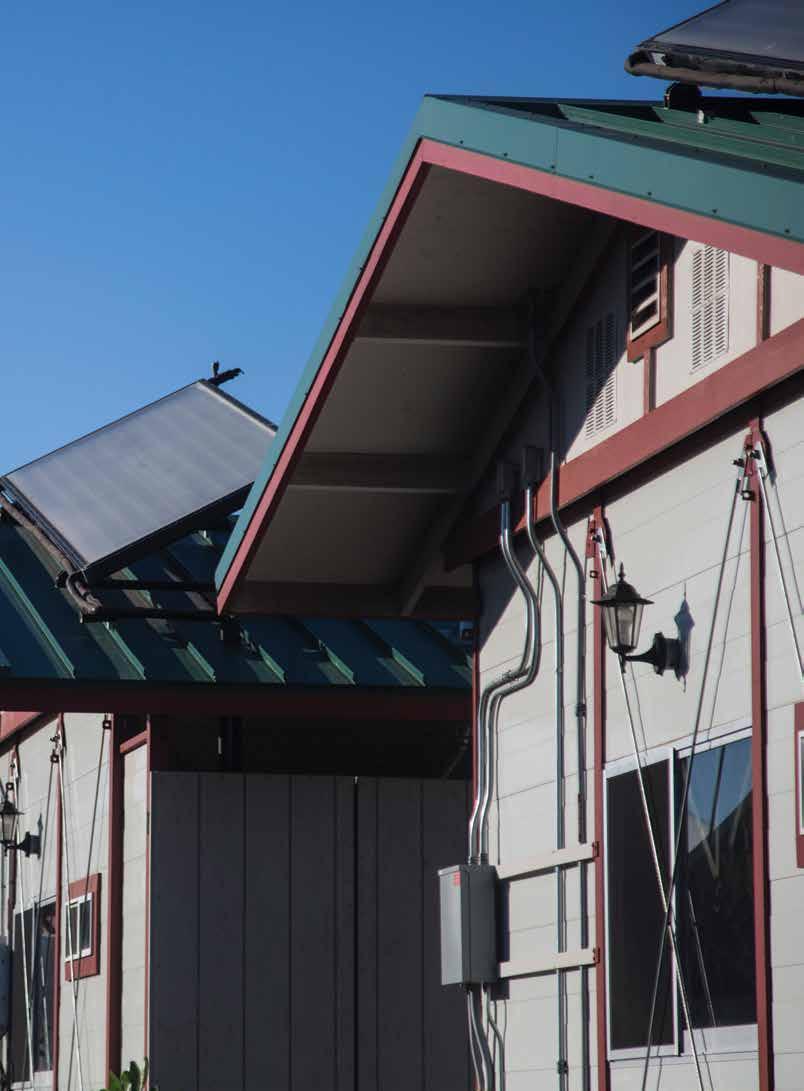
A MODEL COMMUNITY
Every so often, a person will pull into Kahauiki Village off Nimitz Highway in Honolulu and ask if any of the cheery, solar-powered houses are for rent. Each time, employees have to explain that the residential development is only available to formerly homeless families. “That happens weekly,” said Kimo Carvalho, the director of community relations and development at the nonprofit Institute for Human Services, one of Hawai‘i’s largest homeless service providers and a partner at Kahauiki Village, as he toured me around the development.
Kahauiki Village, which everyone calls KV, is a novel approach to alleviating homelessness in Hawai‘i, which in 2018 had the largest homeless population per capita in the nation, tying with New York. Since it opened in January 2018, KV has been called a “dynamic community,” the “first of its kind in the country,” an “unprecedented affordable housing project for previously homeless families.” In June 2018, Duane Kurisu, a local real estate investor and KV’s originator, published an essay on Zócalo Public Square, a nonprofit media outlet, under the headline, “The New Kahauiki Village Is Rekindling the Communal Values of Old Plantation Towns.” “At Kahauiki,” he wrote, “we believe that a sense of community should be the starting point in addressing the day-to-day needs of those seeking comfort and shelter, and for providing long-term solutions for homelessness.”
Spearheaded by the Aio Foundation—the charitable arm of Kurisu’s family of companies, which includes PacificBasin Communications—and supported by the City and County of Honolulu and the State of Hawai‘i, the 11acre, multiphase development along Honolulu’s industrial waterfront will eventually house 144 families who previously had nowhere to go but one of O‘ahu’s handful of family shelters. For IHS, it was a unique opportunity to collaborate with the private sector. “Housing developers rarely come to us and ask what a population needs,” Carvalho says.
The community is located on a peninsula built from soil, sand, and rock leftover from the construction of Interstate H-1 that, prior to KV, housed a paintball course. That the property became what it is today was something of a fluke. The way Kurisu tells it, he was flying to Honolulu from Hawai‘i Island when he and his friend, Lloyd Sueda, a local architect, spotted the peninsula from the air. The two already had been discussing plans for a housing project for formerly homeless families, so Kurisu decided to look into who owned the property. As it happened, the paintball course was closing, and the parcel was public land owned by the state. After months of discussion, the state gave Kurisu the green light and

Shown above is Dolores, a resident of Kahauiki Village, with her two youngest children. The housing construction is a public-private partnership that began with a community of 30 formerly homeless families.
transferred the land to the city, which leased it to the Aio Foundation for $1 per year. From a developer’s perspective, a person couldn’t have asked for a better deal.
The project is being built in five phases, two of which are now open. It’s made up of what look like small, singlefamily houses but in fact are prefabricated, modular disaster-relief units that previously housed Japanese families left homeless by 2011’s catastrophic earthquake and tsunami. The units were purchased by the Aio Foundation, deconstructed, refurbished, and stacked into piles of constituent parts—steel trusses, insulated wall panels, plywood ceilings—and shipped to Hawai‘i to again house families who have nowhere else to go. Except this time, the catastrophe wasn’t grinding tectonic plates, but the grinding forces of a global economy: record-high rents, stagnant wages, a fraying social safety net.
Structurally, KV is a hybrid, occupying a rare zone between homeless shelter, public housing, and marketbased “affordable” housing. Residents at KV can stay as long as they want, as long as they pay rent. Those rents
48 | FLUXHAWAII.COM
I.

FLUXHAWAII.COM | 49
are subsidized, but not in the same way as federal programs like Section 8 in which monthly rents are often income-based. At KV, rents are fixed at $725 for a one-bedroom unit, including utilities, and $900 for a two-bedroom unit, less than half of what a family would pay on the open market. (Although an income-based system seems more equitable—a person making minimum wage would pay less in rent than a person making $20 per hour—Carvalho says it can disincentivize residents from pursuing better-paying jobs.)
From the beginning, KV was designed to create a base level of stability as well as an incentive to work. November Morris, IHS’s employment program manager, says childcare and transportation are often listed by homeless families as two of the biggest barriers to steady employment. KV is located within walking distance of several major employers, including United Laundry, Love’s Bakery, and Honolulu International Airport, and along a major bus route that connects the village to downtown Honolulu and Waikīkī. The community offers onsite daycare for just $100 a month, with a free half-day program, a major financial relief in a state where childcare can cost anywhere from an average of $640 a month to more than $2,000.
KV gets several things right when it comes to livable environments. Inspired by Kurisu’s childhood, which was spent in a plantation town on Hawai‘i Island’s Hāmākua coast, the homes in KV’s first phase are painted brick red or teal green, their colorful metal roofs (a custom add-on designed by Kurisu’s team) pitched to rid the buildings of their cheap boxiness. Although one could accuse the project of romanticizing plantation culture— Hawai‘i’s sugar plantations were structured around a ghastly system of segregation and oppression—from a design perspective, these details
elevate the secondhand housing units to photogenic cottages, complete with Victorian-style wall lights mounted above the front doors. The result is a feeling of quaintness.
The village’s first phase is also planned to encourage interactions among its neighbors. The 30 houses are tightly grouped, with landscaped paths winding between them rather than roads. There is a post office and a communal laundromat, and Palama Market recently opened a Palama Express not far from the daycare center. Residents have organized a parent hui to address community concerns, and on Saturdays, Ken Miyasato, the director of strategic planning and human resources at Aio Foundation, runs a pop-up dojo in the IHS office behind the Palama Express. KV even has its own micro-grid and is a zero-net-energy community, meaning it produces more energy than it consumes.
Most importantly, though, KV seems to be succeeding in giving formerly homeless families a genuine stepping stone to increased housing security and higher-wage jobs. IHS partners with various Hawai‘i companies to identify job openings before they are posted and prescreens candidates. “Companies are always approaching us, and one of the conversations I have with them is, ‘What do you pay?’” Morris said. “That’s important because our people are at risk. We need to place them in employment that pays a higher rate than minimum wage.” Within one year of KV’s operation, two families transitioned to more traditional housing.
Still, KV is far from edenic. Although technically it’s built on a peninsula, it’s actually more of an island. The property is cut off from the rest of the city by an imposing tangle of concrete onramps, offramps, viaducts, and surface roads, making it accessible by car only from the west— hardly a place a person would choose to live. I visited the village
several times in September 2019, shortly after it welcomed another 30 families to the community. On one visit, I met a woman named Althea, who was working as the cashier at the Palama Express. (She requested that her last name not be used.) Althea had grown up in the Marshall Islands but attended high school in ‘Aiea. She eventually worked at Pu‘uhale Elementary School as an aide to students for whom English was a second (or third) language. About four years ago, after her father died, Althea found herself physically and emotionally incapable of working. Unable to pay their rent in Kalihi, Althea, her husband, and their three kids, two of whom are grown, moved into the Holomua Na ‘Ohana family shelter in Waimānalo. Shortly after, they moved into KV.
I asked Althea how KV compared to other places she had lived. She said the rent was affordable, and that she appreciated KV’s sense of community—the parent hui, the monthly tenant meetings. The twobedroom house that she and her family shared was smaller than the one they had lived in in Waimānalo. It was hotter, too. KV’s housing units have fans but not air-conditioning. But the main difference, Althea said, was the noise. The family’s house sits fewer than 100 feet from Nimitz Highway. The traffic barreling past is constant. Trucks and tour buses tumble from the H-1 onto Nimitz Highway in an unceasing riot of clanging, humming, grinding noise. This was one of the first things I noticed too. On my first visit, the village reverberated with the persistent clamor of construction. KV’s third and fourth phases were under construction, and the property was also being used by the Honolulu Authority for Rapid Transit to store construction materials. The result was a cacophony of voices, beeping trucks, and grumbling machinery. Woven through it was the deep yet shrill
50 | FLUXHAWAII.COM

FLUXHAWAII.COM | 51
roar of commercial airliners taking off from the airport. In 2018, Time Magazine published a report on the dangers of noise pollution, citing a connection between noise pollution and cardiovascular disease.
“High decibel levels from road traffic and airplanes, for example, has been linked to high blood pressure, coronary artery disease, stroke and heart failure—even after controlling for other factors like air pollution and socioeconomic status,” wrote Amanda MacMillan.
Carvalho is aware of the dangers that high decibel levels pose to human health. As an undergraduate student at Tulane University in New Orleans, he studied the relationship between heart disease and excess noise. “It’s a real thing,” he said, adding that noise was the number-one complaint at KV.
With the noise, I knew, came other dangers: the possibility of being struck by a vehicle, and poor air quality, which increasingly is linked to serious respiratory problems, particularly in children. The more time I spent at KV, the more concerned I became. Yes, the village provided immediate relief to O‘ahu’s network of overcrowded shelters as well as a potential a stepping stone out of homelessness. But it also exposed residents to environmental dangers that we are only now fully understanding.
A MATTER OF SOVEREIGNTY
There was a reason, besides being a design writer, that I was sensitive to the quality of the built environment at Kahauiki Village. I had written about the project before, when it was still under construction. In that article—published in Next City, a nonprofit publication focusing on urban issues—I had tried to paint a picture of the less-thanideal environment KV occupied, cut off from even the industrial parts of Honolulu by overpasses and on-ramps. But I didn’t explicitly explore the potential dangers that the location posed to soon-to-be residents, and so a commenter wrote, “No mention of the pollution from the highway and the airport—pollution those banana trees and vegetable gardens will absorb, & that will
cause that community’s children and elderly & adults too health problems … This seems to be the perfect example of environmental discrimination becoming entrenched.”
The comment was merited. Despite technological advancements that have produced cleaner automobile emissions, air quality concerns have ratcheted up in recent years as researchers have learned more about the dangers posed by fine and ultrafine particulate matter—the technical term for much of the air pollution associated with traffic. According to the American Lung Association, exposure to particulate matter can cause or exacerbate respiratory illnesses such as asthma and pneumonia and put individuals at greater risk for cardiovascular disease. Because these particles can enter our bloodstream, they can also lead to increased cell loss in the brain, resulting in neurodegeneration and enhancing the risk of dementia and Alzheimer’s disease. Even autism has been linked to air quality. A 2014 study published by researchers at Harvard University’s School of Public Health found that the risk of a child developing autism doubles if the mother is exposed to fine particulate pollution late in her pregnancy.
Scientists used to think that particulate matter came strictly from a car’s exhaust pipe. But it turns out our vehicles are perpetually shedding bits and pieces of themselves. Disc brakes release a steady stream of metals such as iron, copper, and manganese into the atmosphere, which can mingle with sulfate to become soluble before entering our lungs. Rubber tires release microparticles of potentially harmful compounds, such as carbon black, a possible carcinogen. We’re only now realizing how dangerous these sources may be, and these aspects of car manufacturing are not regulated the way emissions are, which means even electric vehicles will not solve all our air-pollution problems.
The most dangerous places, when it comes to air pollution and traffic, are areas within 1,500 feet of busy roadways, which is the case for all of Kahauiki Village. It’s easy to write off air quality as a secondary concern, but Hawai‘i’s homeless population is disproportionately Native Hawaiian or Pacific Islander, and Native Hawaiians in turn are disproportionately afflicted with heart disease, diabetes, and obstructive
Kahauiki Village is being built in five phases. It’s made up of what look like small, singlefamily houses, but in fact are prefab disasterrelief units.
By the time the first phase opened, more than 200 local businesses, nonprofit organizations, and government agencies had donated time to help realize the project.
52 | FLUXHAWAII.COM
II.
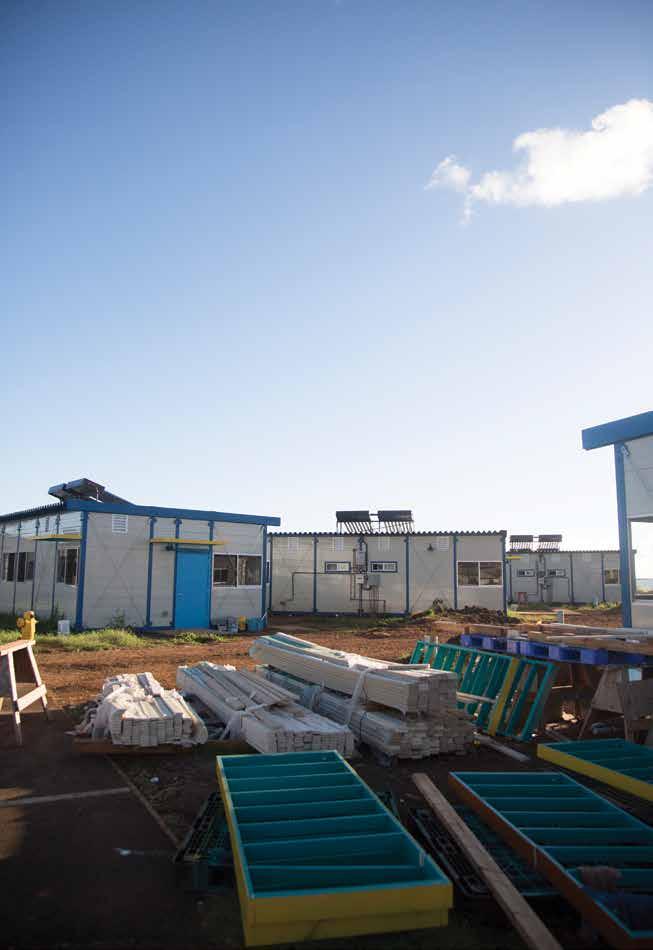
lung conditions such as asthma, bronchitis, and emphysema. Quite frequently, it is a health issue that puts a family on the streets in the first place. One of the other residents I met at KV is Dolores (who also requested her last name not be used). Dolores is middle-aged, Chuukese, a mother of three. Two years ago, she was living in Kansas City, Kansas, when she became severely ill. She couldn’t work. She could barely move. Doctors had no idea what was ailing her; tests revealed high blood pressure but little else. “I was sick for eight months,” she told me. She moved to Hawai‘i for treatment on the recommendation of a cousin, who knew a woman who practiced nontraditional medicine. Her two youngest children, who are 13 and 12, came with her. But without a job or savings, she couldn’t afford her own apartment, so she went to IHS, which found her a house in KV.
After several months of treatment, Dolores recovered enough to be able to work again—she recently got a job in security at the airport—but her story is a common one. Unexpected health problems, and the resulting medical bills, are one of the main reasons Americans lose their jobs or file bankruptcy. Once a person becomes homeless, sufficient healthcare can be even more difficult to acquire.
Unfortunately, putting our most vulnerable populations in harm’s way is a common thread in American history. In 1970, Congress passed the Clean Air Act, which, like the Clean Water Act before it, made a healthful environment a civil right, regardless of ethnicity or income level. Beginning in the 1980s, however, a series of protests and reports made clear that many communities in the United States still lacked clean air or water and that, worse, the level of toxicity strongly correlated with race. Minority communities, often low-income, were far more likely to be exposed to various forms of environmental pollution, leading to the term
“environmental racism” and birthing the environmental justice movement. I find it striking that in the Hawaiian language, the word for air, “ea,” is also the word for sovereignty. Ea refers to breath and respiration, as in the phrase “ho‘opuka ea,” which means “exhaust fumes.” But it also connotes sovereignty, whether of a nation or of a person’s mind or body.
Elizabeth Kapu‘uwailani Lindsey, a Hawaiian voyager and National Geographic Society fellow, has described ea as her favorite word in the Hawaiian language. “Ea means a personal sovereignty, a sovereignty where no one can hold you back or keep you down,” she once said. This etymological link between sovereignty and the physical, earthly environment suggests an innate relationship between our wellbeing and the health of the planet—our air and water. An environment that endangers us is another form of subjugation. If we want to free families from the burdens created by poverty and homelessness, the environments we create are essential to that project.
The dangers posed by the knotted roadways near KV are not limited to noise or air pollution. I’ve taken the number 19 bus from Waikīkī to Kahauiki Village. Although the city added a bus stop in front of the community, it only serves eastbound traffic. Coming from the other direction, I had to get off at Pu‘u Hale Street and walk the remaining halfmile to KV. It’s a harrowing journey, even for an able-bodied 33-year-old. There’s no shade and no buffer between pedestrians and the speeding cars. Where Sand Island Access Road intersects Nimitz Highway, drivers are given a wide, curving right-turn lane so that they don’t have to stop. The only way to reach KV is to dash across, keeping your eyes on the road to ensure a semi-truck doesn’t barrel around the turn and crush you.
At one point during my trek, a dump truck going at least 45 miles per hour hit a steel plate in the road
as it passed me, causing a bang so loud that I flinched. Several minutes later, my ears were still ringing. Loud noises trigger our bodies’ natural “fight or flight” response, flooding our bodies with stress hormones like adrenaline and cortisol. In these situations, our bodies are doing what they’re designed to do. But repeated or chronic exposure to stress-inducing environments, such as overly noisy ones, can lead to unhealthy cortisol levels, which can put people at risk for increased blood pressure, cholesterol, and heart disease.
The scariest moment came just after crossing Kalihi Stream. By this point, the sidewalk had disappeared, so I was forced to walk along Nimitz with not so much as a curb to protect me from the speeding traffic. Eventually, I found my way blocked by a huge, diamond-shaped traffic sign warning drivers of a steel plate ahead. With a ditch full of debris falling steeply away from the other side of the sign, I had no choice but to scurry around it when there was a slight break in traffic. By the time I reached KV, I was soaked in sweat—mostly from the sun and the way it bounced off the metal buildings that lined the road, but also from the stress of the noise and navigating so many hazards.
KV’s developers highlight the community’s proximity to jobs and schools. And it’s true that some of IHS’s partners, including Love’s Bakery and United Laundry, are within walking distance, as are public elementary, middle, and high schools. But the routes to many of these places are downright hostile, lacking shade or sidewalks or both, and, in the case of the walk to Farrington High School, passing directly by O‘ahu Community Correctional Center, a three-block-long stretch of chain-link fencing and razor wire. In general, pedestrian safety in the U.S. seems to be trending in a troubling direction: 2018 saw the highest number of pedestrian deaths since 1990, and Hawai‘i consistently ranks among the deadliest states for elderly persons.
54 | FLUXHAWAII.COM
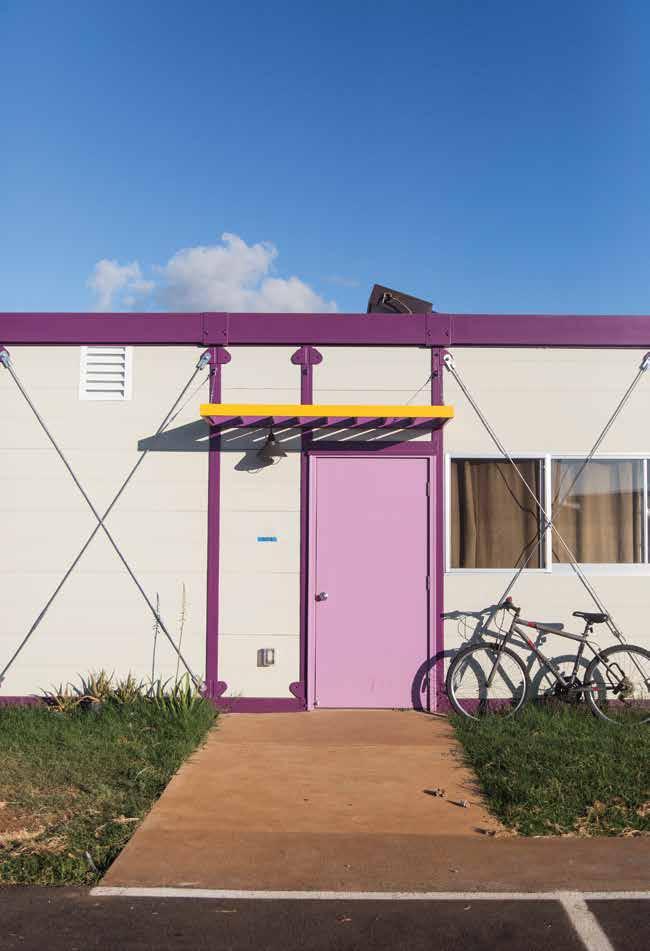
One afternoon, I saw a couple and their young son walking along Nimitz Highway. I recognized the boy from KV’s afterschool program, where kids had worked on homework or colored pictures of Naruto characters. Framed by a seemingly endless expanse of asphalt, this family seemed small, vulnerable, as if they didn’t belong in this alien environment of roaring, smog-spewing machines. In that moment, Nimitz seemed like a death trap, designed to maim.
Were there quieter, better protected locations to build Kahauiki Village? It’s hard to say. Communities often resist supportive housing projects in their neighborhoods. The reality is that our reliance on—or rather addiction to—cars affects all of us. Many O‘ahu residents are forced to make the same tradeoff: To escape the everyday assault of noise and smog is to be trapped in the everyday assault of bumper-to-bumper traffic— that is, if they can afford a car in the first place. If we’re serious about protecting people’s health, we have to think bigger than housing, bigger than jobs. Those are important. But so is clean air. So is ea.
III.
AN ETHIC OF EA
One of the big storylines of Kahauiki Village is the leading role played by the private sector. “We’re just a bunch of guys who wanted to give back,” Lloyd Sueda, the architect who designed the plantationstyle embellishments on KV’s houses, told Midweek in April 2019. “Obviously, this wasn’t something any of us had to do, but it was a passion of ours and it came from the heart.” By the time the first phase of KV opened, more than 200 local businesses, nonprofit organizations, and government agencies had donated time to help realize the project.
Kahauiki Village was built in record time. This was possible in part because of private-sector collaboration but mainly because of a proclamation made by Governor David Ige, which declared the state’s homelessness crisis a state of emergency. An emergency proclamation
allows the government to bypass certain regulations in the actions it takes to respond to a crisis. In the case of KV, it meant Aio Foundation and its primary government partner, the City and County of Honolulu, could forego certain bureaucratic processes—such as zoning and permitting—that typically add months to construction schedules. It also allowed them to experiment with prefab structures that otherwise wouldn’t meet local building codes. KV, in other words, was disruptive.
To what extent was this revolutionary process responsible for the largely invisible dangers residents face on a daily basis?
When I interviewed Duane Kurisu two years ago, he told me that Aio Foundation went through all the regular steps when it came to assessing the environmental impact of the project; they simply didn’t have to wait for building permits. I’m not sure which would be worse: if the assessment was never completed, or if it was and the potential noise and air quality impacts to residents somehow were deemed insignificant.
The problem with treating the private sector as a benevolent hero that swoops in to save the day is that such a story relies on an imbalance of power, on public institutions so emaciated that when private money is on the table they are all but forced to leap through whatever hoops are placed before them. But private money can be fickle. Cities around the world got a taste of this in April 2019 when the Rockefeller Foundation, a tax-exempt organization with assets exceeding $4 billion, announced the termination of its 100 Resilient Cities program, which since its launch in 2013 had invested $164 million in helping city governments, including Honolulu’s, undertake long-term climate resilience planning.
The foundation’s decision to pivot away from the program stemmed, in part, from a change in leadership. “As it existed, 100RC had grown too costly, and its model no longer aligned with Rockefeller’s goals,” Laura Bliss wrote in CityLab. Josh Stanbro, Honolulu’s chief resilience officer, said the dissolution of the program won’t impede his office’s work. From the outset, Stanbro said he and his staff worked to ensure that the office was supported by the city and
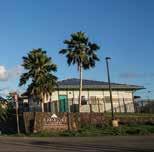
Housing alone cannot address the larger forces that left families homeless in the first place.
Minority communities, often low-income, are far more likely to be exposed to various forms of environmental pollution.
56 | FLUXHAWAII.COM

had financial support from outside the Rockefeller Foundation. They did this, he said, precisely because private funding can be unpredictable. “That’s the nature of philanthropy,” he said.
On my last visit to Kahauiki Village, I noticed what seemed to be a sign of this sort of slow, financial evaporation. Tucked behind the first group of homes, KV’s second phase looked different. The homes were still painted cheery colors, but they lacked the pitched roofs that the Aio Foundation proudly points to in its marketing materials and that did the heavy lifting in making the first-phase homes feel less like factory-built boxes and more like plantation-style homes. Comparing the two, the second-phase houses felt cheaper, more temporary, more like the emergency housing units they were.
The Aio Foundation nixed the custom roofs because they accounted for nearly 40 percent of the cost of each unit. I wasn’t surprised. Maintaining support for nonprofit endeavors is notoriously hard. Capital projects such as new museum wings garner millions of dollars in one-time gifts, while the upkeep for those spaces must be funded from a fixed and often meager budget. “In philanthropy, it’s the die-off effect,” Carvalho said. In the lead up to opening Kahauiki Village, he said the project reached “peak momentum and contributions and assistance. That has definitely tapered. But I wouldn’t say it’s completely lost.”
Kahauiki Village is designed to be self-sustaining. Revenue from tenants’ rents support daily operations and long-term maintenance. But because maintenance has little to no value, its actual cost is often underestimated. It’s not hard to imagine returning to the community 15 years from now to find paint chipping, trees spindly and undernourished, public spaces spoiled by years of neglect. For projects like KV, under the current paradigm, entropy is the rule, not the exception.
We need a new paradigm, just as we need new stories. In her essay, “Maintenance and Care,” Shannon Mattern writes, “Values like innovation and newness hold mass appeal—or at least they did until disruption became a winning campaign platform and a normalized governance strategy. Now breakdown is our epistemic and experiential reality.” Maintenance, meanwhile, is overlooked, deferred, or relegated to the domestic realm (traditionally the jurisdiction of housewives, whose everyday labor has no market value). What we need, Mattern says, is to better understand “how the world gets put back together” through the “everyday work of maintenance, caretaking, and repair.”
In any situation, it’s worth asking what exactly is being disrupted. Housing alone cannot address the larger forces that left families homeless in the first place, or the entrenched car culture that pollutes our islands and disproportionately harms low-income families. Will the business leaders who helped build KV also push Hawai‘i’s lawmakers to pass legislation raising the minimum wage or expand their companies’ family leave policies and benefits packages to decrease housing insecurity? In April 2019, while KV’s second phase was getting its final coat of paint, a bill that would have raised the minimum wage to $15 per hour by 2023 died on the House floor.
A lot of people say KV is a model for addressing homelessness in Hawai‘i, maybe even around the world. But Kahauiki Village is still an experiment. And like all experiments, we should track the results closely, not only the standard metrics—number of families housed or average household income—but also the health and wellbeing of those families, their longterm financial stability, the strength and longevity of social ties established while part of the community. We should not shy away from the project’s
failings or its imperfections, but rather hold them up in the spirit of improving the lives of those it is meant to serve.
While writing this, I’ve been worried that in critiquing Kahauiki Village I am implicitly setting myself against the welfare of the families who call it home, or invalidating the tireless labor of the hundreds of workers and volunteers who sustain it: the case managers, daycare providers, landscapers, and construction crews; the security guards and the students who volunteer after school; the residents who serve on KV’s parent hui.
More than that, I worry that by reporting on the potential health impacts of living there, I am adding an undue burden on the shoulders of mothers, fathers, and children who already have experienced various traumas. But to look the other way feels unjust. We all deserve the best information we can get about our health. And we, the public, need to examine the results of social endeavors with humility and an eye toward our own biases and blind spots.
Kahauiki Village is an attempt to prioritize the dignity and autonomy of people who so often are deprived of both. But we rob people of their personal sovereignty when we infringe on their rights to clean air and safe streets and a quiet refuge to call their own. To continue to build cities with insufficient regard to human health and wellbeing is to rob ourselves of the ea we need to survive. We need alternatives that prioritize maintenance and care, that are imbued with an ethic of environmental sovereignty. A clean and safe community should be a right, not a privilege.
58 | FLUXHAWAII.COM
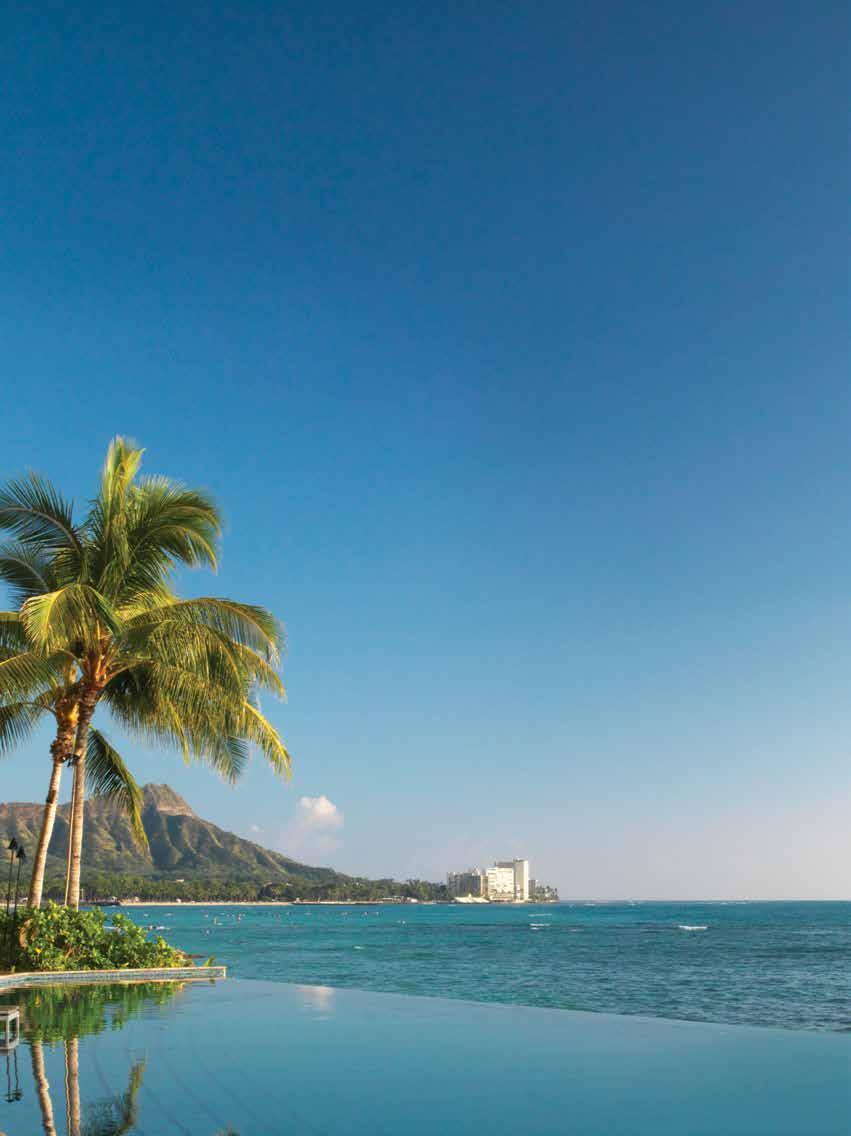

©2019 MARRIOTT INTERNATIONAL, INC. ALL RIGHTS RESERVED. MARRIOTT BONVOY™ AND ALL OTHER NAMES, MARKS AND LOGOS ARE THE TRADEMARKS OF MARRIOTT INTERNATIONAL, INC., OR ITS AFFILIATES, UNLESS OTHERWISE NOTED.
Waikiki ALOHA ANYWHERE Discover your piece of paradise in Hawaii. Immerse yourself in the rich cultures, traditions and stunning natural beauty of these tropical islands. We invite you to explore Marriott International’s collection of distinctive hotels and resorts, where family getaways, romantic escapes and unforgettable adventures await. BOOK NOW AT MARRIOTTHAWAII.COM
Sheraton
FLUX FEATURE
T he Hunt for Geor ge Gil ley
The uncharted tale of history’s only Native Hawaiian whaling captain, culled from an archival abyss of explorer logs, scholarly mentions, and aging newsprint.
TEXT BY TRAVIS HANCOCK
ILLUSTRATIONS BY LAUREN
TRANGMAR
 The only existing portrait of George Gilley, a Native Hawaiian whaler, in 1887. Photograph by Herbert L. Aldrich. Courtesy of the New Bedford Whaling Museum.
The only existing portrait of George Gilley, a Native Hawaiian whaler, in 1887. Photograph by Herbert L. Aldrich. Courtesy of the New Bedford Whaling Museum.
Nā pe‘a i ka makani THE SAILS IN THE WIND
With the wind freshening toward morning’s end, George Gilley’s little whaleboat held its lead. The sharpset prows of the larger ships Sarah, Kapiolani, and Mokuola nipped at his wake as he rounded the flag-boat at Waikīkī, sprinted westward to a buoy near the Pearl River mouth, and then beat back through the early afternoon to the finish line at Honolulu Harbor. There at the wharf, where Aloha Tower would stand half a century later, a crowd of 5,000 revelers thronged the esplanade, cheering as Gilley sailed first through the flagfestooned channel.
The race launched the sporting festivities for King Kalākaua’s 44th birthday, November 16, 1880. Reporting on the celebration, the Pacific Commercial Advertiser described a collective “spontaneity of spirit, an enthusiasm, and at the same time, a peacefulness of demeanor; proving a widespread loyalty ... prevails among all races of our population.” But it is hard to say if such feelings were stirred in George Gilley. The whaleboat that he had rigged with a sail likely came from the schooner Julia A. Long, which had just completed the final whaling expedition undertaken by any Hawaiian-registered ship. As its captain—the only known Native Hawaiian whaling captain in history— Gilley was out of work. Was he driven to win the race for king and country? Or was it for the $50 prize, a hefty payday for a whaleman without prospects?
Gilley’s life story, which has never been told in full, is rife with such questions. But one thing we might reasonably infer, after weaving together the scattered mentions of his name—spelled Gilley, Gilly, Gillie, Gelley, or Kele—in newspapers, letters, and explorer accounts, is that a festive day spent riding island breezes around buoys was much easier than his average foray. In the years well before
and after that day, Gilley navigated Arctic storms and treacherous fields of coral, ice, and thrashing leviathans that shivered the timbers of all who braved the North Pacific in the great blubber rush of the 19th century. Propelled by a jetstream of sheer talent, Gilley was an exemplar of the Native Hawaiian initiative, skill, and fearlessness that rendered a small island kingdom a player in the global economy.
When 18th-century Kānaka Maoli, or “real people” in Hawaiian, applied the word for their islands, moku, to the foreign ships arriving at their birth sands, they implicitly continued a deep-routed tradition of Polynesian migration and island colonization. This semantic act soon translated into real Kānaka seamen making gains throughout the floating archipelago of ships built by nations seeking economic footholds in their islands. Navigating his way to the top of this movement, and furthest beyond the West’s maritime color lines, George Gilley led his predominantly Pacific Islander crews into a novel form of sovereignty in the post-contact era.
Yet when a moth-eaten memory of Gilley is occasionally brought forth in whaling histories, it rarely highlights his dynamism. Most often, writers cite the so-called “Gilley Affair” that transpired just three years before Kalākaua’s birthday race, when a close shave with the westernmost tip of North America resulted in Gilley’s crew swabbing the decks clean of blood that belonged not to whales but to Iñupiat—“real people” in the Iñupiaq language. But taking a brief, telescopic view of that gruesome picture denies Gilley the full scope of his unrivaled life, which began decades earlier, several seas away.
E komo ʻĀkia GONE TO ASIA
In 1830, a British ship captained by Samuel Dowsett carried 13 pioneering Kānaka Maoli from Hawai‘i nearly 4,000 miles westward to the uninhabited Bonin Islands, 600 miles
south of Tokyo. Accompanying them were five white men—their indenturers and in a few cases husbands—who intended to colonize the island group for England. They settled on Peel Island, now known as Chichijima. By 1835, their grass-hut settlement attracted at least six more enterprising wāhine and several other disaffected Westerners, including Englishman William Gilley. One of the colony’s 16 wāhine bore children who took his name—among them William Jr., Michael, Lizzie, and around 1840, George.
Growing up in this distant microcosm of colonial Hawai‘i, young George thrived on Hawaiian staples, from fresh fish and wild pig to sweet potatoes and sugarcane. His life was defined by the sea. He learned to sail on outrigger canoes made for interisland travel and, at first, likely hunted turtles. In 1837, visiting British captain Michael Quin observed the settlers’ efficient use of island resources, including its many sharks, which he saw “the dogs frequently chase in shoal water, capture and drag high and dry on the sandy beach.” Other supplies came by way of roving whalers that occasionally appeared on the eastern horizon. As a teenager, George Gilley jumped at the first opportunity to leave on one, arriving in Hawai‘i via a whaling ship and sticking around. An 1855 letter, sent to the Bonin Islands from a family friend in Honolulu, mentioned that “George has been here 2 or 3 times but I could not persuade him to go home and see his mother. He seems to like this place so much.”
Through the mid-19th century, Honolulu and Lahaina were the de facto dispatch hubs for ships en route to the cold, whale-rich waters off Japan. Most of these ships hailed from Nantucket and New Bedford, Massachusetts, and brought to the islands everything from bricks to syphilis to Christian missionaries. They also presented opportunities for Kānaka Maoli. In 1840, Richard Henry Dana Jr.’s bestselling sailing memoir Two Years Before the Mast

62 | FLUXHAWAII.COM

broadcast the enviable talents of “Sandwich-Islanders” who made their way from whaling into the fur trade on California’s coast. “Ready and active in the rigging,” wrote Dana, these “complete water-dogs” schooled their New England counterparts in the art of landing small boats through the Santa Barbara surf.
Small-craft skills were vital to the whaling industry, which partly explains for the quick rise of Pacific Islanders to the coveted, harpoonwielding position of boatsteerer—a trend caricatured by Herman Melville’s Queequeg in Moby-Dick. However, Hawaiians ascended well beyond token status on board, and often manned the full span of positions available on a single ship. Even as outsourced laborers, they gleaned competitive seasonal wages ranging from $5 to $200. Between the roughly 5,000 Kānaka Maoli who signed onto whaleships between 1842 and 1867 alone, the profits Hawai‘i skimmed off the American market stacked up. The real booty, however, lay in selling oil to the burgeoning empire, which needed it to light and lubricate its industrial revolutions. As early as 1832, Hawai‘i’s financiers began flipping used ships and assembling a local whaling fleet. Fitted with high-flying Hawaiian flags proclaiming the monarchy’s might, the budding flotilla was loaded with homegrown talent and launched into the wind.
Ke kōā o Pēlina THE BERING STRAIT
According to one newspaper, young George Gilley was on the scent of Arctic whales by 1862, aboard the Hawaiian-registered Kohola under Captain Brummerhop. This could have included his first “wintering over” in the Bering Strait, at eastern Siberia’s St. Lawrence Bay. If he was there, locked in sea ice awaiting the spring hunt, he surely marveled when Siberian Yupik traders emerged from the white landscape to deliver vital deer meat to the crew. The favor,
however, backfired on one such visitor, Capatchou, who became trapped on the ship during a gale. Desperate to see his family, Capatchou futilely begged Brummerhop for help ashore, jumped overboard to attempt the frigid swim, and disappeared.
Later, Gilley would have heard gunshots echo across the ice as the captain tried to defend himself from the vengeful arrows and spears of Capatchou’s relatives at their village. The crew were only returned Brummerhop’s clothing, but never his body. When the Kohola resumed its methodical decimation of the Yupiks’ source of whale meat and muktuk (a skin and blubber dish) in the spring, five of Gilley’s fellow Kānaka died of scurvy, followed by three more from other diseases. Sailed by first mate Bernard Cogan, the Kohola returned to Honolulu in the fall of 1863 with 600 barrels of bowhead whale oil and 10,000 pounds of baleen, which equates to about six kills. Between 1847 and 1867, whalers would remove more than 18,000 bowheads from the Arctic—more than the entire population in the region today.
In 1863, Gilley’s father (or possibly brother), William, was reportedly murdered, which might explain why an 1870 letter written by Lizzie suggests that Gilley had returned to the Bonin Islands. But by February 14, 1872, the Hawaiian Gazette listed a sailor named “Gillie” on the Honolulu yacht Henrietta who is “counted among the most expert whalemen that belong here.” Although the Henrietta was slated for a two-month shark hunt, the Advertiser reported on February 24 that “the crew of the Henrietta have struck three whales since leaving here; one sunk and was lost; one they secured and tried out at Ukumehame, to the westward of Lahaina, and they were fast to another when last seen, on Monday, in the channel between Molokai and Lanai.” But was this our Gilley? The Advertiser confusingly identified this whaler as “R. Gillie,” a name found nowhere else in Hawai‘i’s
whale-related press. By contrast, misinformation and misspellings abound in these papers— Brummerhop’s name, for example, was rarely spelled the same way twice. In any case, Gilley would have needed exactly the kinds of experiences gained on the Kohola and Henrietta to explain how by 1875 the approximately 35-year-old was listed as captain of the brig Onward, becoming the only known Kanaka Maoli to achieve that title on a whaleship. Owned by Honolulu businessman James Dowsett, son of the Captain Dowsett who ferried the first settlers to the Bonin Islands, the Onward was a force in the kingdom’s whaling fleet. In Gilley’s first recorded season as a captain, he proved his worth. Following a successful spring hunt, the Advertiser reported in November that the brig Onward sailed into port with her casks brimming with oil, thanks to Gilley’s winning gamble on a once-popular whaling ground near Alaska’s Kodiak Island.
Ke liolio nei ke kaula likini THE RIGGING LINES TIGHTEN
In December 1876, Dowsett hired Gilley again, to captain the William H. Allen for a short hunt along the equator—a late-season trip likely intended to recoup some of the year’s Arctic losses. That summer, at least 12 ships, including the Honolulu barks Arctic and Desmond, had been lost to rogue ice floes off Nuvuk, or Point Barrow, on the north coast of Alaska. It seems that delays in fitting out the William H. Allen spared Gilley the hardship faced by the 300 seamen stranded on the ice, though there is a chance he had been present for the even greater disaster of 1871, five years prior, which had claimed 33 ships, including the Kohola and three other Hawaiian-registered vessels. When not listed as a captain, a whaler’s story is difficult to track—unless they wrote it down.
Such was the case for Kanaka seaman Charles Edward Kealoha,
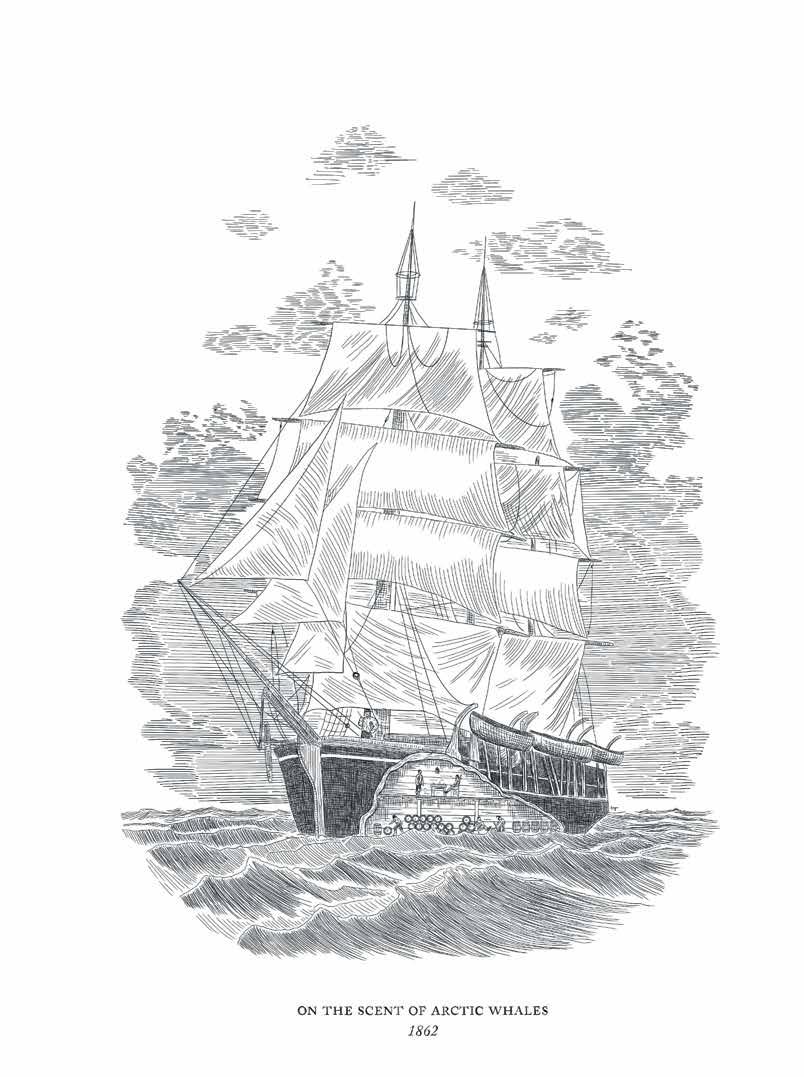
64 | FLUXHAWAII.COM





whom Gilley saw hurtling toward him over the ice dunes near Tangent Point, Alaska in early August 1877. Gilley was again at the helm of the William H. Allen, having embarked from Honolulu on April 21. Kealoha, on the other hand, had been on Alaska’s north slope for almost a year. He and a Mā’ohi whaler named Kenela, both of the Desmond, were the last survivors of at least 50 men who had stayed behind in Alaska when others took their chances on a few crowded ships that escaped the ice. These two Pacific Islanders persevered by the grace of Iñupiat who brought them to their warm caves and fed them fatty fish and orca meat.
Kealoha’s firsthand account of this harrowing winter was published in the Hawaiian newspaper Ka Lahui Hawaii, and was recently brought to light by Susan Lebo in the Journal of Hawaiian History. Lebo highlights the warm reception Kealoha received from Gilley, whom he referred to as “he keiki Hawaii Ponoi,” or one of Hawai‘i’s own children, and whose moku provided a feeling of being “i ka aina hanau,” in the birth land. Lebo’s article, which features translations by Bryan Kuwada and Puakea Nogelmeier, also includes an account by J. Polapola, one of Gilley’s Kanaka crew. Lebo imagines Kealoha likely spent many hours sharing stories with Polapola in the crew’s quarters, though we can only guess what horrors swept through Kealoha’s mind as Polapola described the massacre that occurred on the decks above them two months before.
E niniu i ka makani SPINNING IN THE WIND
In his initial report to the Advertiser recapping the 1877 whaling and walrusing season, Captain Gilley, who was rarely quoted in the press, mentioned briefly that on “June 5th, while becalmed between Cape East and Cape Prince of Wales, three canoes approached the vessel, for
the purpose of obtaining liquor, but were refused, on account of their being drunk, in consequence thereof a row ensued on board, and we were compelled to drive them off as soon as possible, resulting in killing of one of the crew (Hawaiian) and wounding two.” In the same paper, Captain Owen of the Three Brothers offered “a heartfelt thanks to Capt Gilley” for rescuing him after his ship was frozen in pack-ice near Nuvuk.
Only one of these leads interested the sensationalist journalists of the day. A correspondent for the San Francisco Chronicle quickly penned “A Whaleship’s Escape” about Gilley’s tragic encounter with the Iñupiat, in which he claimed to dispel the “wildest rumors” by presenting facts gained through an interview with the captain. Yet the writer went on to describe how “the vessel was overpowered” by “seventy five warriors,” led by a 6-foot-6-inch tall chief who seized Gilley by the throat and signaled his determination “to take charge of the vessel, run her ashore, and murder the officers and crew.” With dramatic flair, the writer flipped this fate, one dead “redskin” at a time. The Chronicle’s version was soon reprinted as far east as Chicago, feeding American readers images of a cowboys-and-Indians-style shootout at sea.
In time, Gilley’s account took on a racialized Rashomon effect. Where the Chronicle noted an Iñupiaq committed the first murder, journalist Herbert L. Aldrich, in his 1889 book Arctic Alaska and Siberia, quoted Gilley saying that one of his own men initially killed a chief by tapping him on the head with a wooden handspike. In 1890, the U.S. Bureau of Education’s first English-Eskimo and EskimoEnglish Vocabularies included a rendition in which Gilley shot the chief immediately after “the natives drove the crew below, killing one man.” Here, Gilley’s crew, which included two Yupik men, was implicitly white. Later still, in his 1942 memoir Fifty Years Below Zero, Arctic resident Charles Brower
recalled Gilley placing first blood on the hands of his hotheaded Irish first mate, Finnigan. A variation of this man had appeared in the Chronicle story too, when Gilley first saw that “a Sandwich Islander lay murdered on the deck,” and shouted, “It’s life or death with us, Murphy; are you ready for action?”
All accounts considered, around 15 Iñupiat were killed. Most concluded, in patently racist terms, that Gilley had taught the wily natives better than to interfere with the white man’s industry—concealing the ill-kept secret that whalers, including Gilley, were illegally trading liquor for Iñupiat furs. Brower went so far as to describe Gilley himself as a white man, and quoted him saying, “No, sir, they don’t like whites much around Cape Prince of Wales.” While we might wonder if Gilley, being hapa, occasionally engaged in racial passing, it seems more likely that writers like Brower simply preferred drawing within set color lines.
But one account spurs us to believe that for Gilley, the incident was not so black and white. Huddled in the William H. Allen’s forecastle in the fall of 1877, J. Polapola didn’t just write down another play-by-play; he wrote a confession. Unlike all the secondhand reporters, he was there, on the deck, and the aforementioned handspike was actually in his hands when the chief took Gilley by the throat. Before he knew what he was doing, Polapola had hurled the heavy rod at the chief’s brother, striking him in the neck. “Ke kaikaina alii a haule make aku la iluna o ka oneki,” Polapola wrote— the chief’s younger brother dropped dead onto the deck. But rather than calling the first mate to action, as the Chronicle wished, Gilley shouted just one thing, in Polapola’s account: “Don’t kill him yet.” It seems Gilley had tried to cut short the violence by sparing the chief. And when Kanaka seaman Honuailealea was stabbed in retribution, it doesn’t appear that all the “Kanakas went crazy ... grabbed
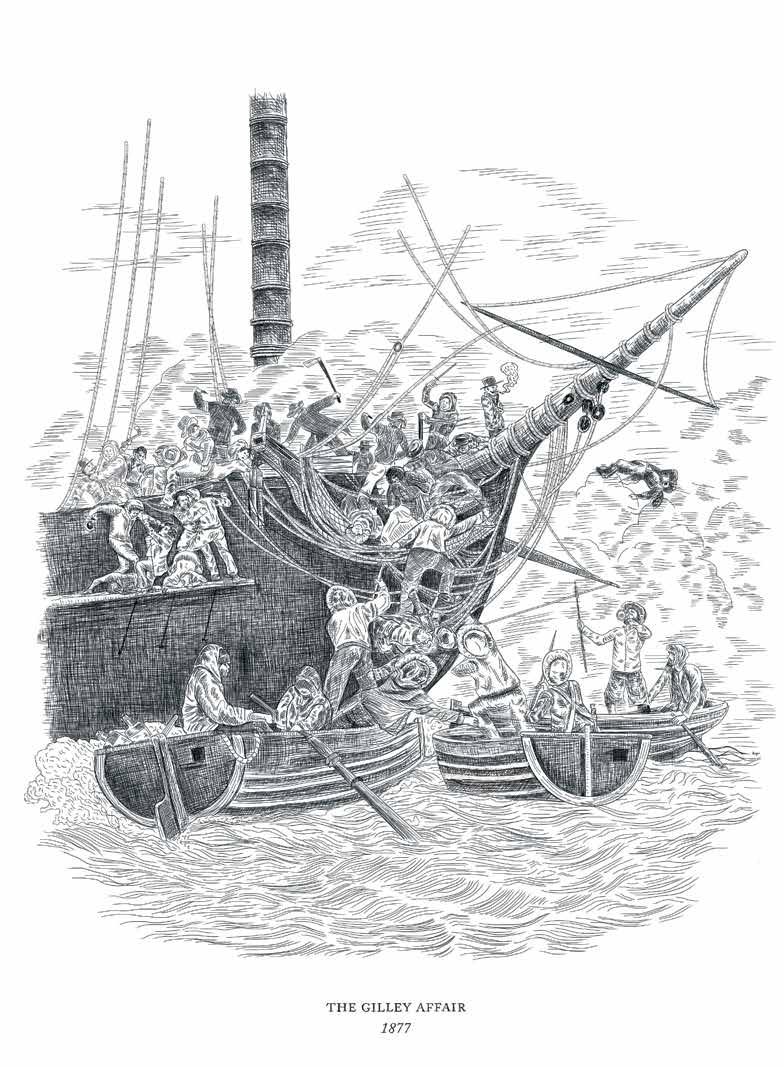
68 | FLUXHAWAII.COM

axes and spades and lit into those damned Eskimos” as Brower claimed. At least two Kānaka, named Paia and Kahele, and presumably both of the Yupik crewmembers, abstained from violence. But others in the fight, including Gilley, knew Hawai‘i’s whaling fleet was down to just four ships, and that theirs contained about $36,000 worth of cargo, according to Polapola. Losing it was not an option. Only after laying out this rationale did Polapola state, without a rhetorical flourish or flinch, “The captain seized the chief by the neck, gave him a bullet in the face and threw him into the sea.”
‘ A‘ole i kau pono UNFIXED
This is where nearly all accounts of Gilley’s life leave him: standing amidship in the full sun of an Alaskan summer night, smoking gun in hand. He serves as a slick, disposable anecdote, used historically to reinforce racism toward Iñupiat and later to distill the social friction at whaling’s periphery. But Gilley’s career, his own racial struggles, and his relations with the Arctic’s indigenous people extended far beyond 1877.
By contrast, the bloodsoaked William H. Allen did not last long. The ship resumed its hunt after the affair in June, but the sea served up few whales. On October 25, the ship belched forth only 200 barrels of walrus oil, 6,000 pounds of ivory, and 5,000 pounds of bone upon its return to Honolulu. Seven months later, Gilley again steered the William H. Allen north— fearlessly, or foolishly, north—back to Nuvuk, the northernmost point of North America. On August 2, Captain Dexter of the Loleta reported, “brig W H Allen was stove by ice, near Point Barrow; crew all saved; Captain Gilley on board the Onward.” Gilley remained on the familiar ship until it returned to Honolulu in November. With the subsequent loss of the
Florence, Hawai‘i’s fleet, which had grown by two ships that year, was again down to four.
Unphased by Gilley’s loss of the ship, and the single liquified whale that had been in its belly, Honolulu’s investors placed him at the helm of the Giovanni Apiani in 1879. But the Arctic he encountered that year had changed. He reported to the Advertiser that he found no whales, just plenty of starving people, such that he “killed two schooner loads of walruses and carried them along the settlements and gave to the natives.” Contrary to popular belief, Gilley had no interest in exterminating his trading partners. He gave them his entire haul. On October 27, he returned to Honolulu with just 1,218 pounds of tobacco, 5.5 barrels of rum, and other trade goods. The Giovanni Apiani was sold the next year, and Gilley landed on the last Hawaiian ship to feed in the Arctic, the Julia A. Long. In many senses, it was a classic whaling season: He cruised the reliably stormy seas around St. Lawrence Island, south of the Bering Strait, caught half a dozen bowheads, and performed a routine rescue when Captain Dexter ran aground in the Loleta. He even had an encounter with ichthyologist Tarleton H. Bean, then curator of fishes for U.S. National Museum, and told him about a favorite walrus-hunting spot on Hall Island further south. In spite of these high notes, Hawai‘i’s local whaling industry folded when he returned to port on October 10, 1880.
Ka‘a ‘ē ka huila
THE WHEEL TURNS ELSEWHERE
Sometime around Kalākaua’s birthday race in 1880, Gilley registered a home address in Pauoa, O‘ahu, but he did not stay there long. He followed the whaling industry to San Francisco, where he became captain of the bark Eliza until at least 1884, touching at Honolulu occasionally. By 1886, the middle-aged whaler
downgraded station but upgraded technology, becoming first mate on the steam-powered Grampus. No longer captain, Gilley lost regular listing in whaleship reports. In 1887, however, he had his encounter with Herbert L. Aldrich, who took his picture, standing on the decks of what could be the Grampus. In this only known photograph of Gilley, the man appears entirely self-possessed, suited up in a thick, greasy furs, smoking a pipe, bare hands tucked in at the waist, serious eyes half-squinting through the Arctic light. Behind him are two other men, possibly Iñupiat or Yupik, one of whom is crossing the deck with a blubber spade while the other looks on.
In December 1890, Gilley, then first mate of the steam-whaler Thrasher, was the subject of a leprosy scare. Although a health officer in San Francisco initially declared his symptoms to be “a severe case of eczema,” his shipmates apparently insisted he be taken to the “pest house” for further monitoring, claiming that “his wife, who was formerly a resident of this city, but who now lives at Yokohama, is also a leper.” These intriguing details about his wife are difficult to corroborate, but one has to wonder whether Gilley’s ethnicity and associations with Hawai‘i, and maybe Japan, played into the false assumption that he was “also a leper.” In November 1897, the San Francisco Call ran a feature on Gilley, then boatsteerer of the Thrasher, complete with an illustrated portrait of him in a threepiece suit. The headline was familiar: “Captain George Gilly: Forty Years an Arctic Whale-Hunter, Who Has Killed a Few Esquimaux.” Besides a rehashed telling of the “Gilley Affair,” the article claimed that Gilley “has gone to the Arctic Ocean every year for forty years past.” If true, that placed him in the Arctic even before Brummerhop’s mishap, most likely when he was a teenager.
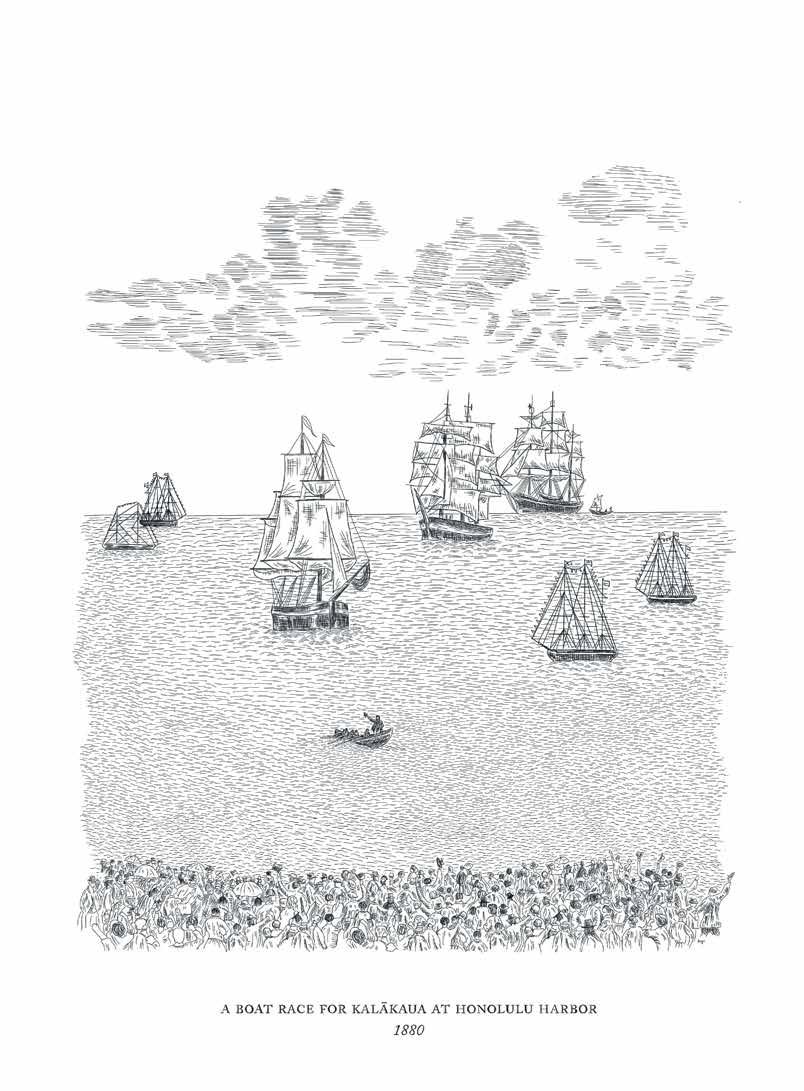
70 | FLUXHAWAII.COM

In 1898, Gilley blew onto yet another ship, the Andrew Hicks, becoming first mate to none other than Captain William Shorey, aka Black Ahab, the first and only black whaling captain in the Pacific. In April, the two sailed from San Francisco, stopping in Honolulu for provisions. The Pacific Commercial Advertiser hailed their arrival, calling Gilley “a half-caste of this Island.” When in Hawaiian waters, any chance or need for racial passing vanished. The same went for Shorey’s ship. The captain deliberately sought out Kānaka Maoli to improve his odds in the increasingly difficult industry. “Hawaiians are fearless on the water,” he told a reporter during the visit. “They will chase a whale when they know they are in the greatest danger and think it is the greatest fun. If a boat is capsized it makes no difference to them for they can swim like fishes. I do not know of any people who are better suited for our business. They are absolutely fearless.” Perhaps this is why Gilley kept at it so long, kept risking the ice, the disease, the skirmishes, and thrashing tails of leviathans—it was the greatest fun. Or maybe he relished having sovereign power over his moku, or at least his own whaleboat. For even after finding such comradery with Shorey, and returning to the suddenly American city of Honolulu, he again sought the Arctic, one last time.
mysterious, fatal bullet fired from the beach, forcing them to sail for Alaska at daybreak.
As the ship approached Sledge Island, about 20 miles offshore, Gilley took a seat on the ship’s rail and looked across the blue at the coast of stone gray and green. Then the wind shifted, and for once in his life, he did not rise to meet its force. The boom swung around and knocked George Gilley into the frigid sea. His men raced astern as the ship grazed onward, only to watch him drown. The crew worked like whalers, and not without difficulty, to hoist Gilley’s lifeless body out of the water, back into the crisp morning air. They took him on to Nome.
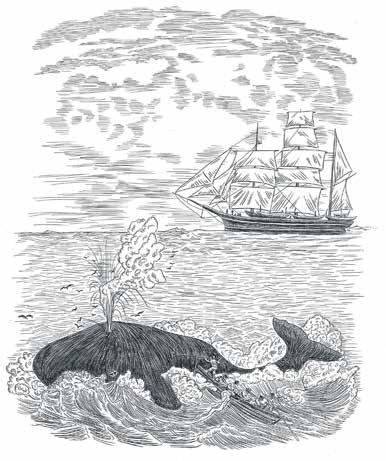
A few days later, a small newspaper in Oregon recorded the loss of a 60-year-old “native of the Island of Borneo,” “whose good or bad fortune it was to have killed five Northern Indians some years ago.” Later in the same article, this number is raised to 10. A few other West Coast papers ran similar accounts. His death was not evidently reported in Hawai‘i.
Aia i ʻĀlika ka ihu o ka moku THERE IN THE ARCTIC, THE PROW OF THE SHIP
In 1899, gold was discovered at the coastal settlement of Nome, Alaska, drawing thousands of prospectors and, apparently, George Gilley, who arrived via the bark Alaska in the spring of 1900. He floated into the captainship of the schooner Edith, and began trading from Nome around the Bering Sea. In August, he sailed over to the Siberian coast, and anchored near the shore. Trading with locals went peaceably until one night, when Gilley’s first mate caught a
Ha‘ina ‘ia mai ana ka puana SING THE SUMMARY REFRAIN
While Gilley’s iwi rest somewhere unknown, his name lives on in the Bonin Islands, known as the Ogasawara Islands since Japan claimed them in 1875. Due to this political and cultural shift, modern Gilleys are nearly as difficult to track as their historic relative. “Gilley” has been transliterated to “Gērē.” Family members have decided to choose entirely new names, a phenomenon studied by linguist Daniel Long, who stated that some of “the Gilleys, proud of the ‘South Sea Islander’ part of their roots, chose the name Minami,” meaning “south.” One such person, born in 1961, is named George. According to a 2018 article in the Asahi Shimbun newspaper, George (Gilley) Minami works on whaling and fishing ships, “continuing the family tradition.”
72 | FLUXHAWAII.COM
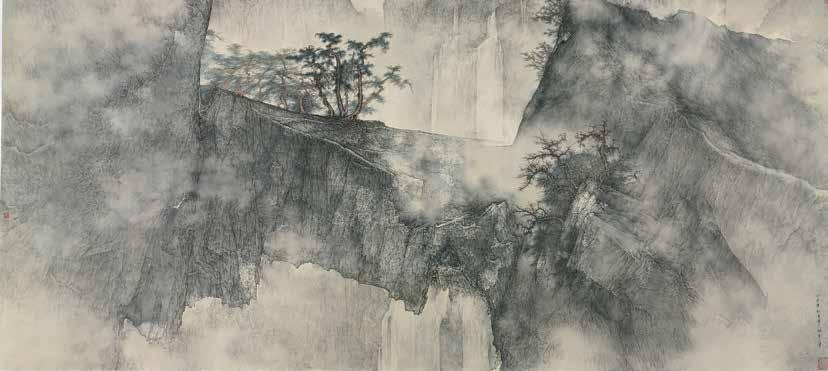
MUSEUMS • CAFÉS • THEATER • SHOPS
900 S Beretania St • 808.532.8700 honolulumuseum.org ON VIEW THROUGH JAN 5, 2020
THIS EXHIBITION IS MADE POSSIBLE WITH GENEROUS SUPPORT BY the E. Rhodes and Leona B. Carpenter Foundation, Maurice and Joanna Sullivan Family Foundation, Dr. Diane Chen Koch-Weser, Dr. Gene and Cecilia
Doo, Donald and Laura Goo, Drs. Ernest and Letah Lee, Fred Sheng and Robert Oaks, Drs. William and Margaret Won and two anonymous donors.
Li Huayi, Autumn Mountain /At the Edge of the Sky, 2007 Ink and color on paper. Yiqingzhai Collection (L2016-67.01)
MEDIA SPONSOR HOTEL SPONSOR
Contemporary. Cool.
Classical.
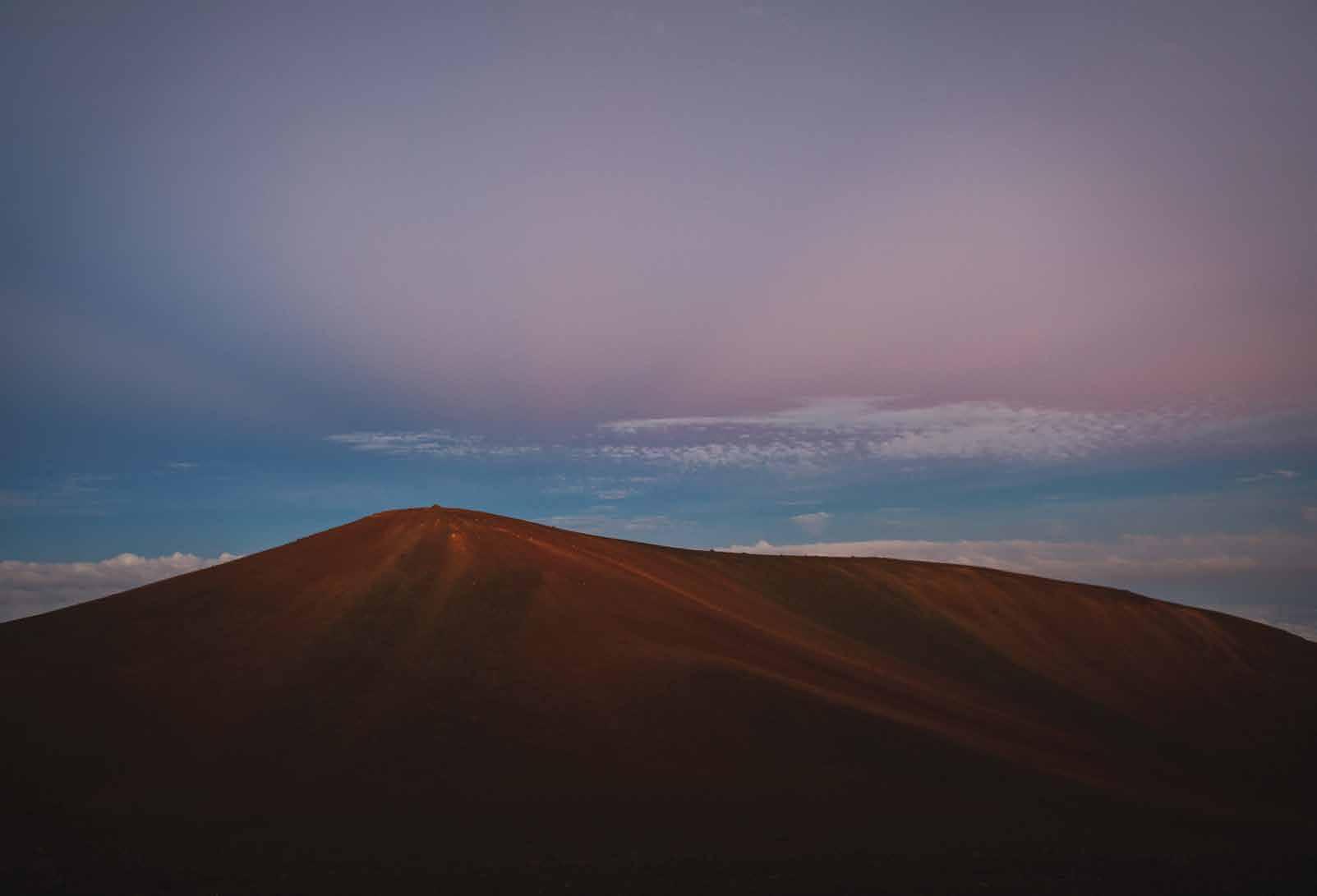

FLUX FEATURE
For t he L ove of L āhu i
Maunakea has inspired a mighty wave of protectors to save a sacred mountain.
Within the movement, new songs, chants, and stories are being birthed.
TEXT BY JAMAICA HEOLIMELEIKALANI OSORIO
Ask me about the mauna
And I will tell you
How every morning I woke to a lāhui growing
As if we were watching Maui fish us
One by one
From the sea …
How on the third morning I watched
As 30 became 100
Then 100 became 1000
Then 1000 became us all
Each and every one of our Akua standing beside us
— Jamaica Heolimeleikalani Osorio, excerpt from “Ask me about the Mauna”
On July 17, 2019, I watched alongside my Lāhui as 38 of our beloved kūpuna stood fiercely in their aloha for our ʻāina and were hauled away by State and Hawaiʻi County law enforcement officers. The Kūpuna had staged themselves in the center of the Maunakea Access road to block the transport of construction equipment up the mountain. Hundreds of thousands of people clung to their Facebook and Instagram live feeds while nearly a thousand kiaʻi, a sea of protectors, lined the Ala Hulu Kūpuna and flooded the pāhoehoe with our tears.
Just two days earlier, eight kiaʻi, myself included, had chained ourselves to the cattle guard on the access road to prevent the delivery of construction equipment. At 2 a.m I pulled on my cargo pants, my longsleeve paddling jersey, and my hoodie with the words “See You on the Mauna” printed across it. In my pockets I carried only the essentials: lip balm, sunscreen, a vial of salt water from Kailua Bay, and a small bag of homemade cookies from my sister. Like most of my hoa aloha ʻāina I was severely underdressed for the cold. I worried that the midday heat would be too much to bear in my thermal gear, so underdressing was the choice many of us made.
The eight of us ascended the access road together; we were joined by Kahala Johnson and Mahea Ahia who were our primary kōkua (supporters) and protectors. While we crawled upon the guard and locked ourselves into place we looked up in fear as a patrol vehicle sped recklessly
down the mountain towards us. Malia Hulleman and I had just chained ourselves to each other and the grate when the bright lights began to approach us with alarm. Kahala and Mahea bravely put their bodies between us and the oncoming officer just as we put our bodies between the mauna and any construction vehicles. Without their protection any one of us could have been easily killed or severely injured. These were the first moments of what would be our 12-hour standoff with Hawaiʻi enforcement agencies.
The steel cattle guard pressed against our thin clothing and brought our temperatures down at a dangerous rate. I remember shivering so hard that my muscles began to ache. I looked in awe at the mana of Malia, the wahine who laid before me. When we walked up the access road that morning we were strangers, but by the power of aloha ʻāina we quickly became partners and eventually each other’s family. So I channeled all of the warmth I found in her eyes into steadying my pulse. I wanted there to be no mistaking my convulsing body for fear.
We were not afraid.
We were resolved.
We were honored to be chosen to take this stand for our ʻāina.
We were just simply freezing in the cold. Then, by midday, we traded the threat of hyperthermia for extreme heat exposure. Many of us resorted to cutting off pieces of our clothes to endure the climbing temperatures. The only thing we were unwilling to do was to stand down.
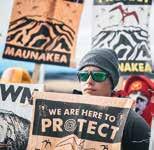
As kiaʻi, we knew that it was both our responsibility and privilege to lay our bodies down in the protection of our ʻāina.
Above, the writer Jamaica Osorio. Image by Dino Morrow. Right, protector Shaydan Racoma at Maunakea. Image by Michelle Mishina. Previous spread, the mauna. Image by John Hook.
76 | FLUXHAWAII.COM


Hāwane Rios with kia‘i during the day’s cultural protocol. The mountain, referred to as Mauna Kea, Maunakea, and Mauna a Wākea, is considered a sacred piko connecting the land to the heavens.
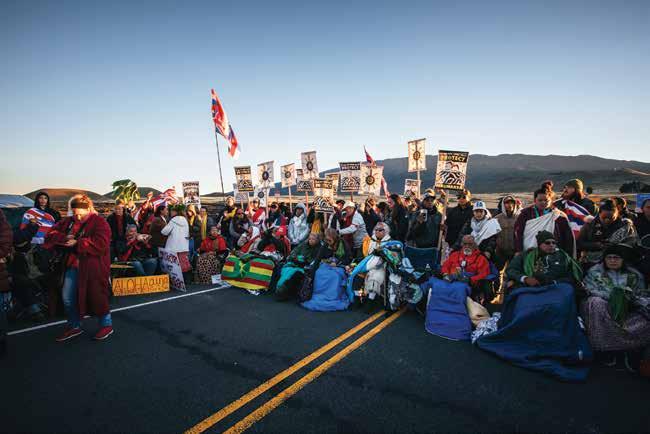
The kūpuna line of elders prior to their arrests. After they were detained by state officers, the number of protectors at the site grew to the thousands. Images by DIno Morrow.


Image by Marie Eriel Hobro.
Image by Marie Eriel Hobro.
Frontline pilina in the malu of the mauna by Jamaica Osorio
It’s Wednesday
And I find myself standing
In the shadow of a mauna that loves me like islands emerging from the sea
Like a sky scattering Herself in stars
Like a lāhui kanaka growing
I’m standing in the Malu of a movement That’s captured an generations heart and attention I find myself
Here
My body
A kīpuka expanding Into pele’s pāhoehoe grip
Holding holding holding my quiet
It’s Wednesday and I find myself
Without searching
Arms linked with a line of women
I barely know
But was destined to love
A line of women stretching back for thousands of generations
Pō, turned light, turned puko‘a turned slime turned gods in a time of mere men
Who more fierce then these bodies of islands
They bodies of women
These moku turned ‘āina Spilling into our sea of islands
These hands stretched out Feeding a generation Accustomed to starvation
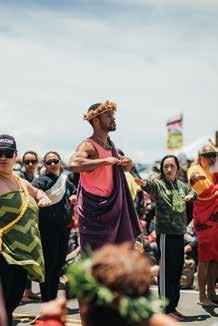
And then Aunty tells me
We are the generation they always dreamed of So it’s Wednesday and now I am weeping
And every kūpuna that ever fought, ever cried, ever died so that we would know for sure how to stand Is singing through me
And somehow
Somehow i am still standing
Arms linked in a line of women
Holding me
And all I have to offer them
Is this story
That is incomplete

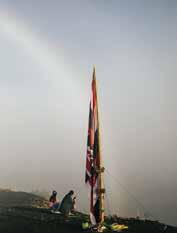
 Images by Nani Welch Keli‘iho‘omalu.
Images by Nani Welch Keli‘iho‘omalu.
The Thirty-Eight
Names of the peaceful protestors, many of them kūpuna, arrested by state law enforcement officials on July 17, 2019 for blocking construction materials for the Thirty-Meter Telescope from being delivered via Mauna Kea Access Road.
James Albertini
Sharol Ku‘ualoha Awai
Tomas Belsky
Marie Alohalani Brown
Gene Burke
Daycia-Dee Chun
Richard L. Deleon
Alika Desha
William K. Freitas
Patricia Green
Desmond Haumea
Flora Hookano
Kelii Ioane
Maxine Kahåuelio
Ana Kaho‘opi‘i
Mahea Kalima
Kaliko Lehua Kanaele
Pualani Kanaka‘ole Kanahele
Deborah Lee
Donna Leong
Daniel Li
Carmen Lindsey
Linda Leilani Lindsey-Ka‘apuni
Abel Lui
Likookalani Martin
James Nani‘ole
Luana Neff
Deena Oana-Hurwitz
Edleen Peleiholani
Renee Price
Haloley Reese
Loretta Ritte
Walter Ritte
Raynette Robinson
Damian Trask
Mililani Trask
John Turalde
Noe Noe Wong-Wilson
Faces of the kia‘i. Images by Jonathan Canlas.
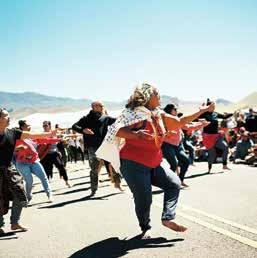

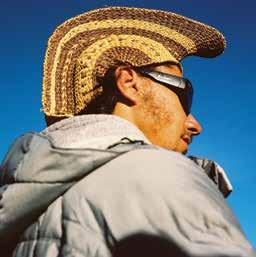



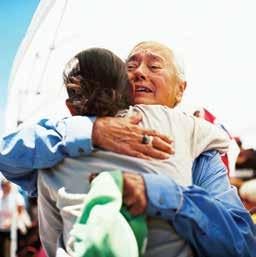
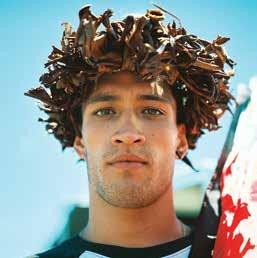
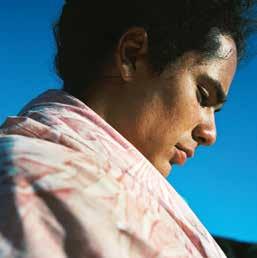
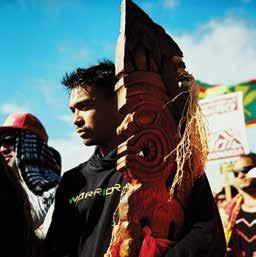
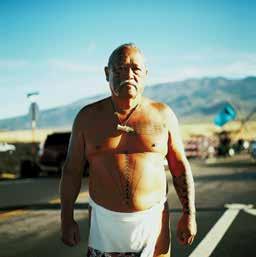
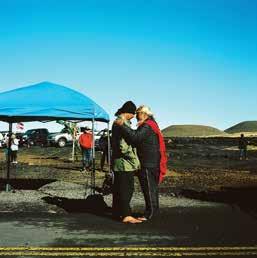
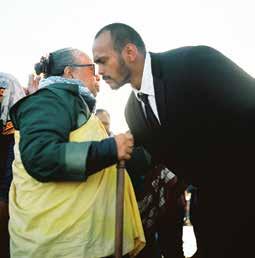


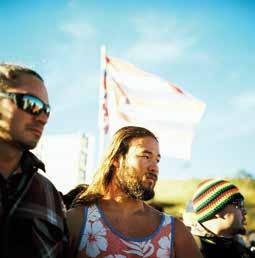
As kiaʻi, we knew that it was both our responsibility and privilege to lay our bodies down in the protection of our ʻāina. With the guidance of our moʻolelo and kūpuna, we also knew that as kānaka we had the right to lie in the streets without fear of harm, invoking Ke Kānawai Māmalahoe, the Law of the Splintered Paddle. When we asserted ourselves upon that right, we challenged not only the Thirty Meter Telescope’s transport of construction vehicles, but the State of Hawaiʻi’s marriage to its colonial vision of law and order. We lodged this challenge not in chaos but rather within the organized adherence to our kānāwai, our Hawaiian governing norms, that have existed hundreds of years before the State took its first stolen breath.
After we had laid there in the malu, the shade and protection, of our mauna and our lāhui for over 12 hours, the police retreated in defeat. Aloha ʻĀina had won the day; we committed to each other and ourselves that we would be back for as many days as we are needed to until the TMT corporation leaves our islands.
On that day our commitment and aloha for each other and the mauna sent a call from Puʻuhonua o Puʻuhuluhulu to our lāhui across the world to join in the protection of our sacred Mauna a Wākea in the face of the proposed desecration from the development of a massive telescope on its peak.
The next morning, our numbers had increased from a couple hundred to nearly a thousand kiaʻi ready to stand and put their bodies between our mauna and any acts of desecration. We stood proud, basking in the wealth and brilliance of our people. We also stood anxious, because as our numbers grew, so did the numbers of officers, and their weaponry and machinery. As we grew to possibly the greatest activation of our people since the Kūʻē Petitions in 1897, a mass petition drive established by Hui Aloha ʻĀina (Hawaiian Patriotic League) against the annexation of Hawaiʻi to the United States, we wondered if we would be met with force that we, contemporary kānaka, had never before encountered.
In the wake of our rising wave, the State had assembled officers from at least six agencies. And while these officers collected their weapons—riot gear, sound cannons, mace, tear gas, and wooden batons—our kumu, masters of ceremony, lead us in the kāhea, the call, of our akua.
So when July 17 arrived, our lāhui was prepared. As police detained our kūpuna one by one, each empty seat was quickly filled by another kupuna, until all 38 elders there had been arrested. The rest of us, their moʻopuna, gave the officers only our silence. Not even the satisfaction of our wailing grief would surround them. And as our silence grew, so did our mana. I watched as our collective pain quickly and intentionally turned to action. And when the final kūpuna were hauled away, their places were flooded with hundreds of mana wāhine supported by our kāne at our backs. And again, our people controlled the road, controlled our destiny, and continued to protect our ʻāina.
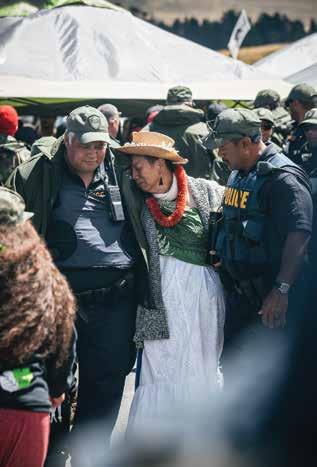
Emotions ran high when the kūpuna, some in wheelchairs and with canes, blocking Mauna Kea Access Road from the delivery of equiment for the Thirty Meter Telescope were arrested on July 17, 2019. Image by Dino Morrow.
When the mana wāhine took the road, we remembered the teachings of our kupuna. We sang our mele, chanted our oli, some even danced our hula. We offered aloha and care to each other and the police officers who stood in opposition to us. We reminded them that we stood there for our children and their children. When the police brought out the LRAD / Sound cannon we passed around ear plugs and pule. We leaned into women we had just met sharing words of aloha and protection. We held tightly onto each other. We insisted that we would protect our lāhui as fiercely as we would protect our mauna. In that moment, we understood how the need to protect our people and our mauna were the same.
The next morning, the number of kiaʻi who gathered at Puʻuhuluhulu and Ala Hulu Kūpuna had tripled. Day by day, we continued to grow. Three to five thousand kānaka and allies answered the call to kiaʻi our mauna. The wealth of our mana resounded across the pae ʻāina while the State spent more than $10 million on its threat to remove us from our ancestral lands.
 Kia‘i are answering the call of their lāhui. Above, protector Tee Seminavage. Image by Michelle Mishina.
Kia‘i are answering the call of their lāhui. Above, protector Tee Seminavage. Image by Michelle Mishina.

For the Lāhui
By Josh Tatofi
Lyrics by Hinaleimoana Wong-Kalu
E welo mau loa ku‘u hae aloha
I ka nu‘u o ka lewa lani lā
A e maluhia no nā kau a kau
Eō Hawai‘i ku‘u ‘āina aloha
E ku‘u lāhui e
Wiwo ‘ole e
Kū kānaka e ‘Onipa‘a mau
Ua mau ke ea o ka ‘āina i ka pono
Ua mau ke ea o ka ‘āina i ka pono


My beloved flag waves ever more in the last year‘s heights of the sky
Always and forever more in peace and tranquility Hail your name, oh Hawai‘i, my beloved motherland
To you my nation
Be bold and fearless
Stand as kānaka And be steadfast in your place
For the freedom of our land remains Always in the truth of our people
Image by Nani Welch Keli‘iho‘omalu.
And today our movements continue to grow. Our kiaʻi continue to govern the Ala Hulu Kūpuna with aloha ʻāina, in strict kapu aloha. Our people are rising like a mighty wave, and what we have accomplished cannot be cast aside. In less than three months, our movement brought thousands of people to the mauna physically (and hundreds of thousands virtually). Most of these kiaʻi had never stood in the Mauna a Wākea’s malu prior. That’s thousands of people who had never had the opportunity to develop an intimate pilina, a closeness, to one of our most sacred ʻāina.
Through our collective ea, our independence, our breath, and our commitment to aloha ʻāina, we brought these kānaka home. And in doing so, we have cultivated in our people an intimacy with a part of our ʻāina we had been strategically estranged from. We should celebrate the many ways our people are returning to an aloha ʻāina that are not simply political but are also deeply intimate and emotional. The growing intimacies between each other and our ʻāina is our greatest wealth because it is what makes us Kanaka Maoli in the first place.
And as we continue to assert ourselves as kanaka we do so through the greatest creative outpouring of our collective lifetime. Song writers, poets, kumu hula, filmmakers, and playwrights are all taking part in telling and protecting this moʻolelo. We are writing the histories of our time in our own voices, with our own melodies and dancing them with our own bodies, just as our kūpuna did for us when they composed mele like “Waika,” “Kaulana Nā Pua,” “Ka Mamakakaua,” and “All Hawaiʻi Stand Together.” Our creativity both describes and expands our current movement. Because of our commitment to the moʻolelo of our rise, our moʻopuna will sing, dance, and speak of the brilliance of our movement to protect Mauna a Wākea long after we have passed into the realm of pō.
Kānaka living around the world are also taking these lessons of aloha and pilina to their home communities. And so, as we continue to grow together in aloha for each other and our home, we must remember that it was this very intimacy of aloha ʻāina that pulled islands out of the depths of the sea, that called upon the great koa (warriors) of our history to fight against a variety of oppressive forces, and that mobilized kānaka opposition to U.S. imperialism and annexation. The intimacy of aloha ʻāina carried 15,000 Native Hawaiians to march to the ʻIolani Palace in 1993 in recognition of 100 years of being a stolen kingdom. In 2018, aloha ʻāina called another 20,000 to return to that march to celebrate the vibrancy of our resilience and resurgence. Putting this intimate aloha ʻāina to action today has resulted in similar uprisings in our communities in Waimānalo, Kalaeloa, and Kahuku and will surely empower the continued rising of our kiaʻi on Maui and Kauaʻi.
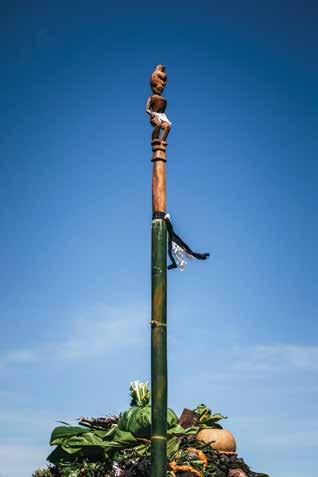
Above, the ahu and ki‘i at Pu‘uhonua o Pu‘uhuluhulu. Image by Dino Morrow. Right, a growing number of Hawai‘i’s youth are standing firm in solidarity with the Maunakea movement. Image by Michelle Mishina.
I believe it is only a matter of time until the Thirty Meter Telescope corporation packs up its bags and departs our beautiful home. But we must always remind ourselves and our opponents that we are not simply standing in opposition to desecration; rather, we are fearlessly committed to protecting our humanity and our ability to live, breathe, think, and act as our kūpuna have for generations. This movement reminds us that protecting ʻāina is what makes us Kānaka in the first place. From where I stand, that is the wealth of our ʻike kūpuna that we surely cannot afford to lose.
90 | FLUXHAWAII.COM

FLUXHAWAII.COM | 91
FLUX FEATURE
From t he Rubble
Photographer Francis Haar documented parts of Chinatown and Pālama—known as ‘A‘ala in the 1960s—while they were being demolished, capturing some of the final images of a Honolulu that has since disappeared.
TEXT BY MICHELLE BRODER VAN DYKE
BY FRANCIS HAAR
IMAGES
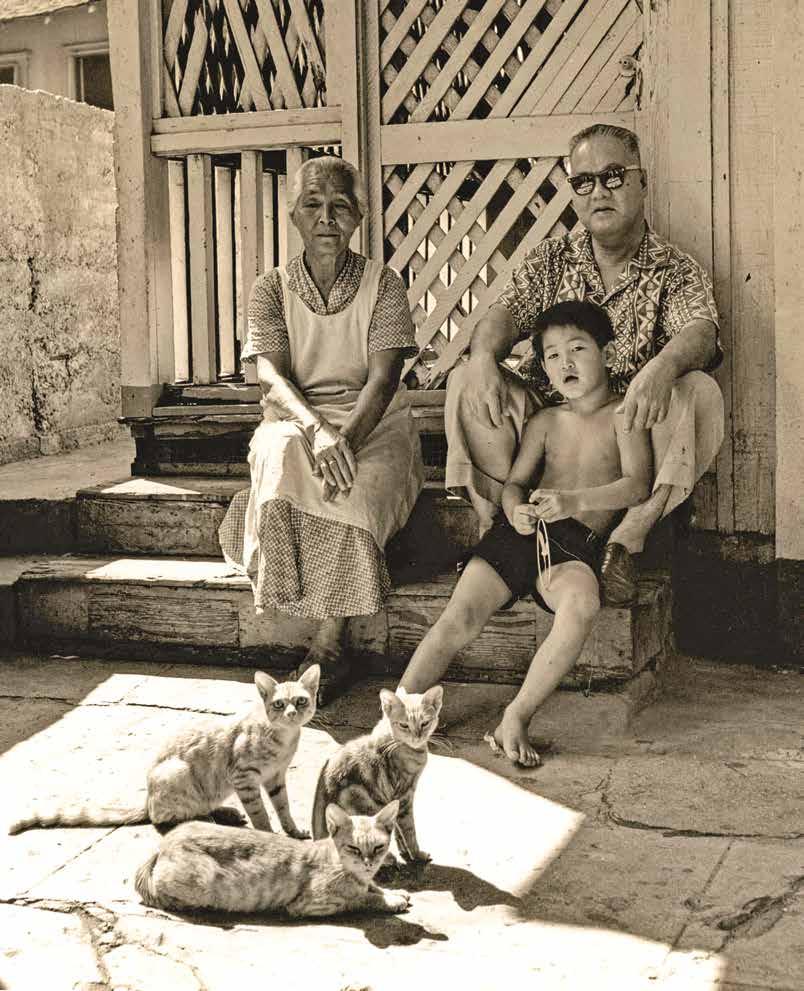
AForemost milk carton. A wrecking ball. A woman wearing a mu‘umu‘u and slippers. A demolition claw obliterating a building. Signs for the Glory Inn, Uptown Cafe, and Paradise Pool Room. Shards of wood piled up by structures getting razed. Families washing dishes on the lānai surrounding a tenement. The exposed edge of a stone building being torn down. People standing in the streets strumming ‘ukulele and a guitar.
These stark images photographed by Francis Haar are of a Honolulu disappearing. He shot them in the 1960s at the convergence of Chinatown and Pālama along Nu‘uanu Stream, though they could have been taken in Kaka‘ako or Mō‘ili‘ili in 2019. Haar used a medium-format camera, a Mamiya C33 twin-lens reflex, which allowed for intimacy with the subject. (The viewfinder is on top of the camera, so the lenses are at his waist.) While he focused on the spaces that were about to be destroyed, he also looked at the people who frequented them, documenting the neighborhood’s humanity. Images show kids running on a lānai, a man leaning on a car while smoking a cigar, a woman with a sly smile crossing the street.
Haar, was born in 1908 in Hungary and lived in Paris, Tokyo, and Chicago before moving to Honolulu in 1960 with his wife, Irene, who was also a photographer, subject, and assistant. He became interested in ‘A‘ala while working as a photography professor at the University of Hawai‘i at Mānoa when Kenneth Bushnell, a friend and painter who had a studio in the neighborhood, told him it was
going to be razed. Haar captured more than 300 pictures in ‘A‘ala and the surrounding area while it was torn down, and he collaborated with Bushnell and writer Stephen Bartlett to make a documentary titled Aala — Life and Death of a Community. The film and 40 of Haar’s photos are on display until December 6, 2019 at UH Mānoa’s John Young Museum of Art.
“Every picture that you have taken—that moment is gone,” said Gaye Chan, the UH art history professor who curated the show, titled Disappearing Honolulu. “What I love about seeing old photographs is not really nostalgia, but it allows my body to occupy a different time and space momentarily.”
Growing up on O‘ahu, my early memories of ‘A‘ala Park are from the 1990s, when Mayor Frank Fasi declared it a homeless “safe zone.” Then in 2002, an old roller-skating rink was renovated and turned into a skate park. In 2019, the city added a fenced dog park, and the 11-story, $100-million headquarters for American Savings Bank was completed across the street. This block is a microcosm of what I have witnessed across Honolulu— everything changing around me as I change too. When I’m at the park, these memories are layered on top of the landscape, and it can be easy to assume this was the way it always was. But Haar’s photos capture a nearly forgotten history of a place I thought I knew.
Between 1900 and 1940, ‘A‘ala Triangle (now the northern half of the park) was the center of a bustling community of Japanese-owned markets, movie theatres, dance
halls, and hotels. Commonly known today as Pālama, ‘A‘ala came to be called Japantown as many Japanese immigrants moved off plantations into the area. But the neighborhood began to struggle in 1941 with World War II, when some of the business owners and community leaders were sent to internment camps, forcing shops and social clubs to shutter.
The region evolved as U.S. military personnel frequented the area, demanding bars, billiard rooms, and brothels. After the war, some Chinese and Japanese residents left, and single plantation workers, often Filipino men, came to hang out. By the 1950s, ‘A‘ala and neighboring Chinatown were densely populated, multi-cultural residential and commercial neighborhoods.
Then, in the ’60s, the Honolulu Redevelopment Agency used federal grants to clear more than 150 acres between School and King streets. Most of ‘A‘ala and parts of Chinatown were condemned as slums with their decaying single-occupancy apartments and makeshift homes, many of which had been built before plumbing and fire codes.
It won’t be long before the last people who grew up shopping or living in the old ‘A‘ala will be gone, along with their memories of this time and place. While Waikīkī’s fancy hotels and idyllic beaches are featured on postcards of the era, Haar aimed his camera at unconventional details, capturing what Hawai‘i was like for many hard-working locals. We often think of our cement city as an immutable monolith, but its layered history runs the risk of being forgotten without photographers like Haar.
94 | FLUXHAWAII.COM
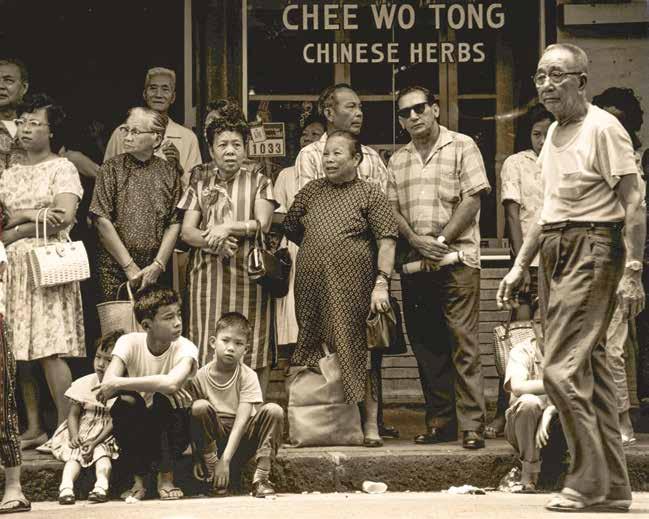
From 1900 to 1940, ‘A‘ala Triangle was the center of a bustling community of Asian-owned markets, movie theatres, dance halls, and hotels.
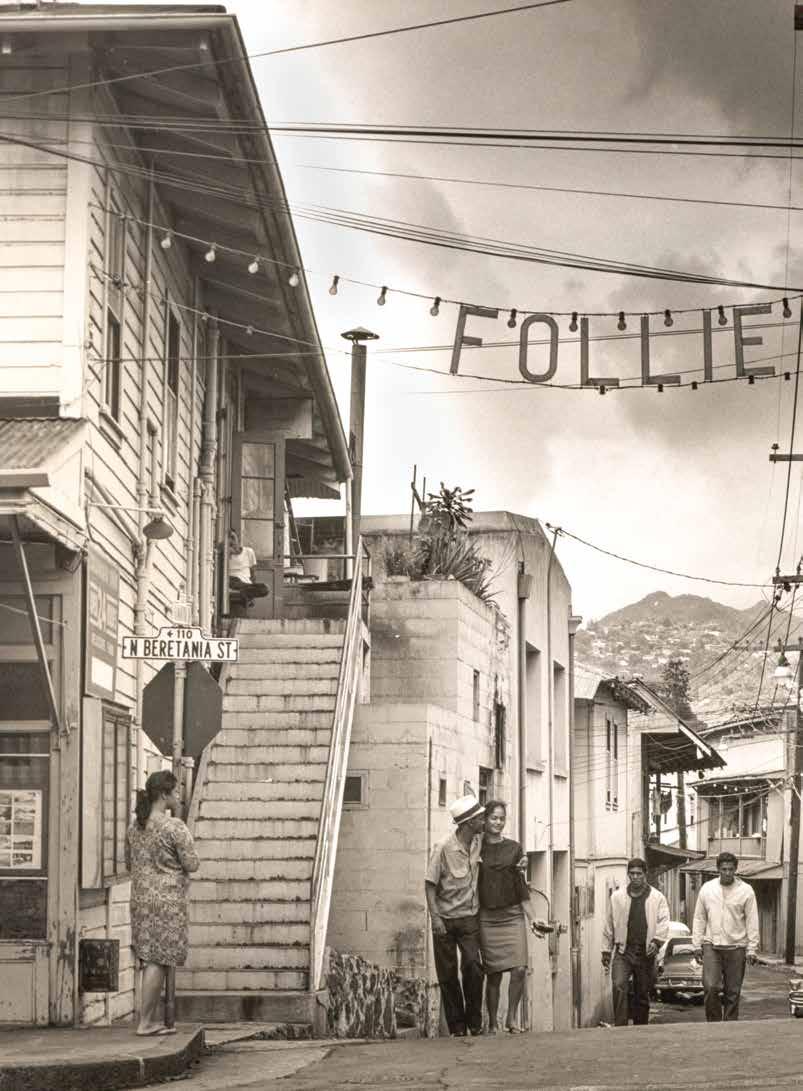


Haar’s body of work offers a rare glimpse into the street life and architecture of historic Honolulu.

Haar was an accomplished black-and-white photographer, best recognized for his portfolio of art and cultural practitioners. The more than 300 medium-format photographs of Honolulu’s changing landscape he shot during the 1960s are lesser known.
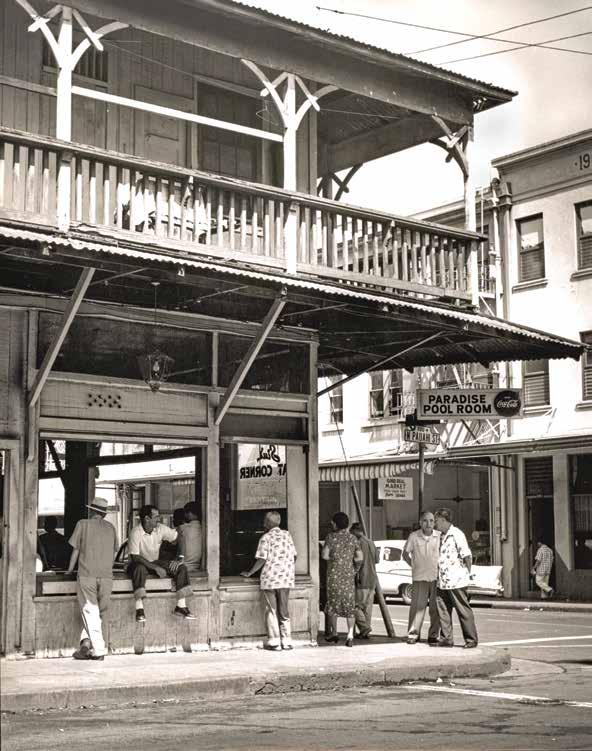
The complicated subject of top-down gentrification echoes throughout this particular body of work.

Though he focused on the architectural character of the city’s buildings, Haar gave special attention to the people inhabiting them.

In 1963, Haar first exhibited these photos at George Hall, the former home to the Department of Art, at the University of Hawai‘i at Mānoa.
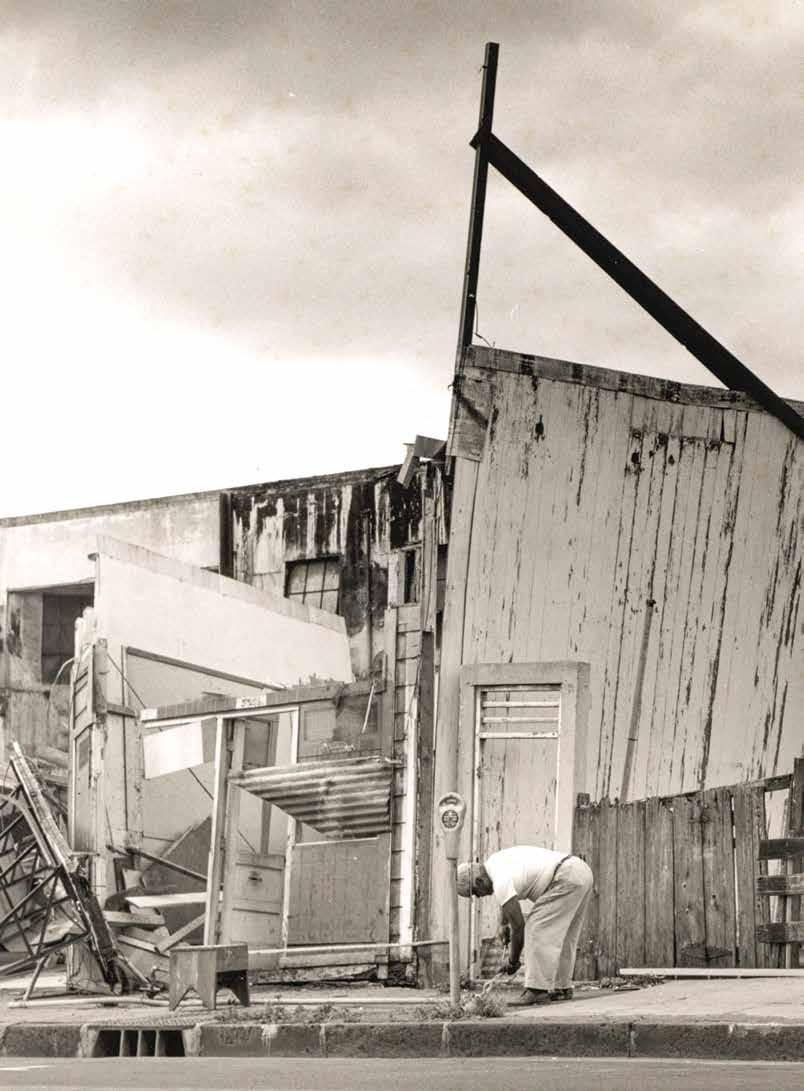


Urban redevelopment from the street level, mid-1960s.
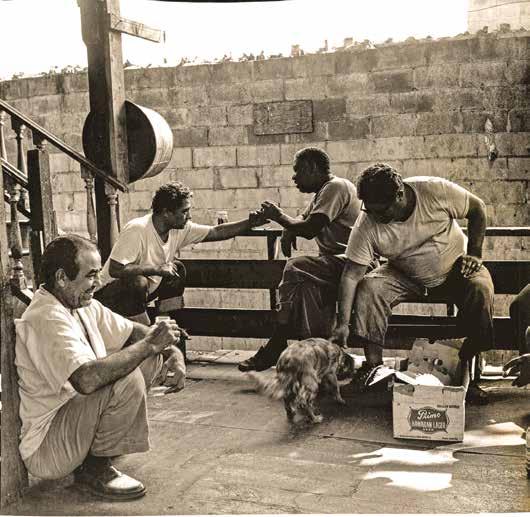
On his own initiative, Haar set out to document what would become a period of transition for the community.

Soon after he photographed the neighborhood, it was razed to create ‘A‘ala Park.
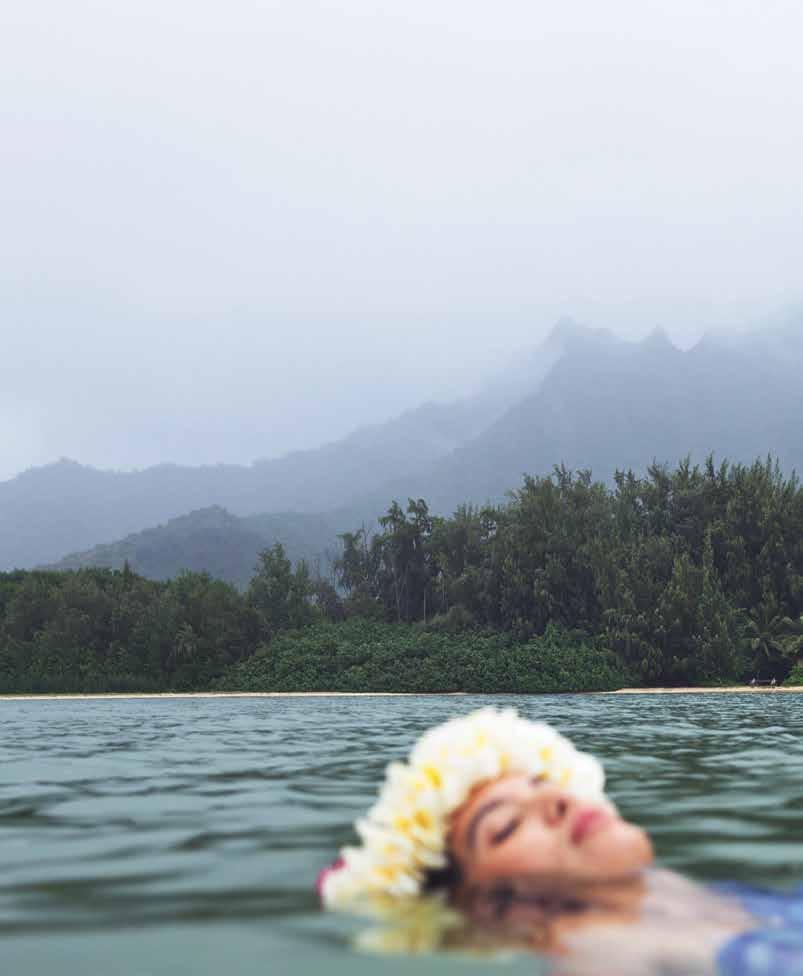 Model and muse Haumea. Image by Cheyne Kalai.
Model and muse Haumea. Image by Cheyne Kalai.

SPECIAL SECTION: BEAUTY
“To take a photograph is to participate in another person’s mortality, vulnerability, mutabilty.”—Susan Sontag

In these explorations of local fashions across eras, from the iconic to the imagined, Hawai‘i style shows that what we deem beautiful springs from a special connection to people and place.
Beauty
Past
Present
Future
Palaka
Holoholo
Bioplastics
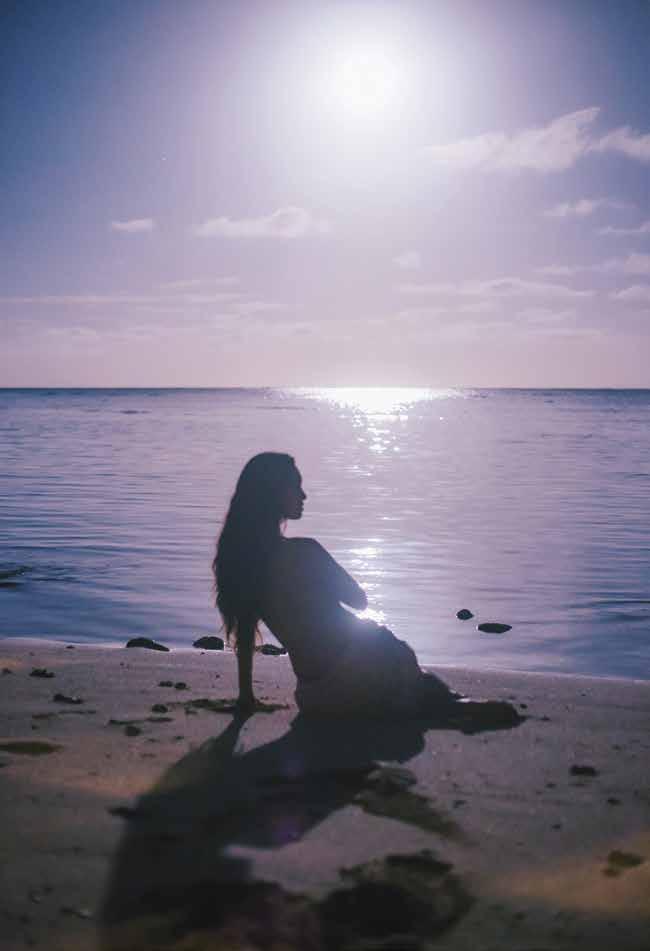
Image by Cheyne Kalai.
Image by Cheyne Kalai.
A Checkered Icon
It’s believed to be more local than the aloha shirt: the checked woven button-up known as palaka.
Plantation workers first embraced the garment for its sturdiness in the fields. Later, it was donned for its reputation as “the traditional ‘Pattern of the Islands,’” as explained by scholar Alfons L. Korn.
While the garment’s name refers to its inimitable pattern, the word palaka is actually a Hawaiian transliteration of the English word “frock.” It comes from the loose-fitting, long-sleeved work shirts that Western sailors wore when they first appeared in the islands, starting with Captain Cook in 1778. Apparently, when the Hawaiians asked about the shirt’s fabric, sailors told them about the style of shirt, and the name stuck.
Simple in silhouette, the palaka stands out for its pattern. The fabric hails from Germany, where it was first imported from in the 1800s to create hardy clothing for plantation workers. According to Barbara Kawakami, author of Japanese Immigrant Clothing in Hawaii, 1885-1941, “During the 1920s and 1930s, palaka was woven of 100 percent cotton and was very thick, very strong, and rough in texture.”
The sturdy twill was occasionally called “Hawaiian denim.” Japanese immigrants who worked the fields referred to the print as gobanji (the Japanese term for plaid, or checkered, design). “[They] were
particularly fond of the palaka because it reminded them of the plaid prints in the yukata (unlined kimono made of printed cotton) they had worn in the summer months in their villages back home,” Kawakami wrote.
Most commonly recognized today as a shirt, the palaka began as a jacket. Its longsleeved style became popular in the 1920s with plantation workers in the pineapple and sugarcane fields. The only color choice available was navy, likely because the material was imported. Plantation workers appreciated that the durable fabric protected them in the fields, dried quickly in the rain, and was easy to mend; stevedores and paniolo (Hawaiian cowboys) adopted the palaka for laboring under the hot Hawaiian sun. Workers wore the palaka with denim trousers, creating a signature Hawai‘i ensemble.
The palaka’s popularity spurred a cottage industry, particularly for Okinawan immigrant Zempan Arakawa. In 1904, Arakawa came to Hawai‘i to work, becoming a water boy on a sugar plantation in Waipahu. After obtaining a foot-pedal sewing machine, he started a makeshift tailor shop. Alongside kau kau bags (made for carrying food) and tabi (Japanese splittoe socks), he sold palaka work shirts for
PAST
110 | FLUXHAWAII.COM
Text by Alexis Cheung Images by Josiah Patterson
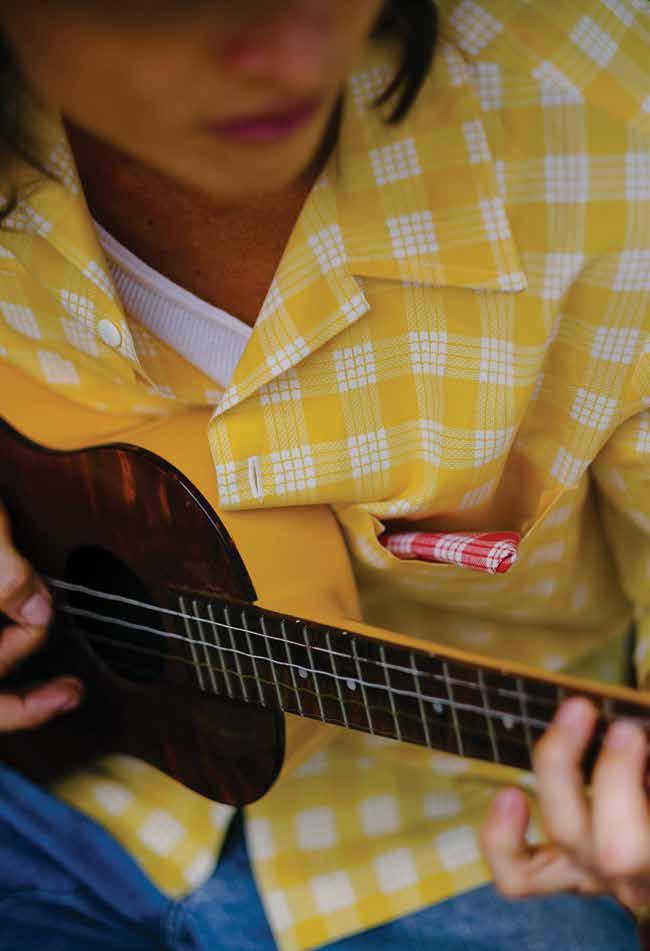



According to the Hawaiian-English dictionary, Mary Kawena Pukui defines palaka as: “A checkered shirt, usually blue and white, of block-print cloth; in the 19th century, a coarse work shirt worn by males, known then in English as a “frock,” mentioned frequently in the literature and especially in Peter Ka‘eo’s letters in 1873–4 to his cousin, Queen Emma, and hence probably from English ‘frock’ rather than from ‘block.’”

75 cents each. This venture grew into Hawai‘i’s largest rural department store, Arakawa’s of Waipahu, which lasted from 1909 to 1995.
By the late 1930s, the palaka had been adopted by the social set. As a result, apparel manufacturers “started cutting off the sleeves and using a lighter-weight fabric,” explains Linda Arthur Bradley, professor emerita at Washington State University and author of Aloha Attire: Hawaiian Dress in the Twentieth Century. “The shirt went from being a kind of jacket to what we recognize today as an aloha shirt.”
Eventually, the palaka pattern was used for other attire: bikinis, board shorts, table linens. Young people had palaka garments made for play clothes, according to Bishop Museum historian DeSoto Brown. He even recalls an image of a Kahala home draped in palaka curtains and table cloths. Everyone wore these shortsleeve palaka shirts, and the classic
pattern expanded into more colorful hues, ranging from red and pink to green and orange.
While the palaka had its moment with tourists, the shirt mostly resonated with the local crowd. “It really was the kama‘āina shirt,” says Dale Hope, author of The Aloha Shirt: Spirit of the Islands . He remembers how Goro Arakawa (Zempan’s son who took over Arakawa’s with his five siblings) told him that wearing the palaka “was more aloha than the aloha shirt, with its history and all those years it has been worn by so many diverse people.” Goro even claimed, “It was the most important shirt that Hawai‘i’s ever had.”
By the 1950s and 1960s, Bradley explains, “The palaka shirt became a badge of local identity.” From the 1960s through the 1980s, while O‘ahu underwent rapid urbanization, palaka emerged as a sartorial symbol in local politics. But unlike the aloha
shirt, the palaka’s popularity has waned, especially since the original reason for the palaka’s existence—the plantations—are gone.
Yet glimmers of resurgence exist. Patagonia created palaka board shorts in 2008, and local designers Matt Bruening and Kini Zamora both created collections including the fabric. Today, brands including the Hawai‘i Island-based Western Aloha and Los Angeles-based Gordon promote palaka-patterned garments. Given the palaka’s storied past, the pattern inherently communicates a special connection to Hawai‘i. According to Hope, wearing palaka demonstrated that you were rooted to the islands, “and that you appreciated this wonderful Hawaiian, kama‘āina lifestyle,” he says. “It was probably the loudest print Hawai‘i’s ever done.”

114 | FLUXHAWAII.COM


Mon–Sat 9:30am to 9pm Sun 10am to 7pm • 808.955.9517 • 1450 Ala Moana Blvd., Honolulu, HI 96814 • FREE WI-FI AlaMoanaCenter.com • Download the Ala Moana Center App from the App Store for iPhone MORE THAN 350 STORES, INCLUDING OVER 160 DINING OPTIONS ALOHA LANE • BIG ISLAND CANDIES • BLOOMINGDALE’S • CHUBBIES • GILLY HICKS • GREENROOM GALLERY INC. HAPPY WAHINE BOUTIQUE • HIC SURF • HOPE & HENRY • MACY’S • NA HOKU • NATURE REPUBLIC • NEIMAN MARCUS NORDSTROM • OAKLEY • SHABUYA • SHIROKIYA JAPAN VILLAGE WALK • TARGET • UNIQLO • & MANY MORE
Modern Holoholo
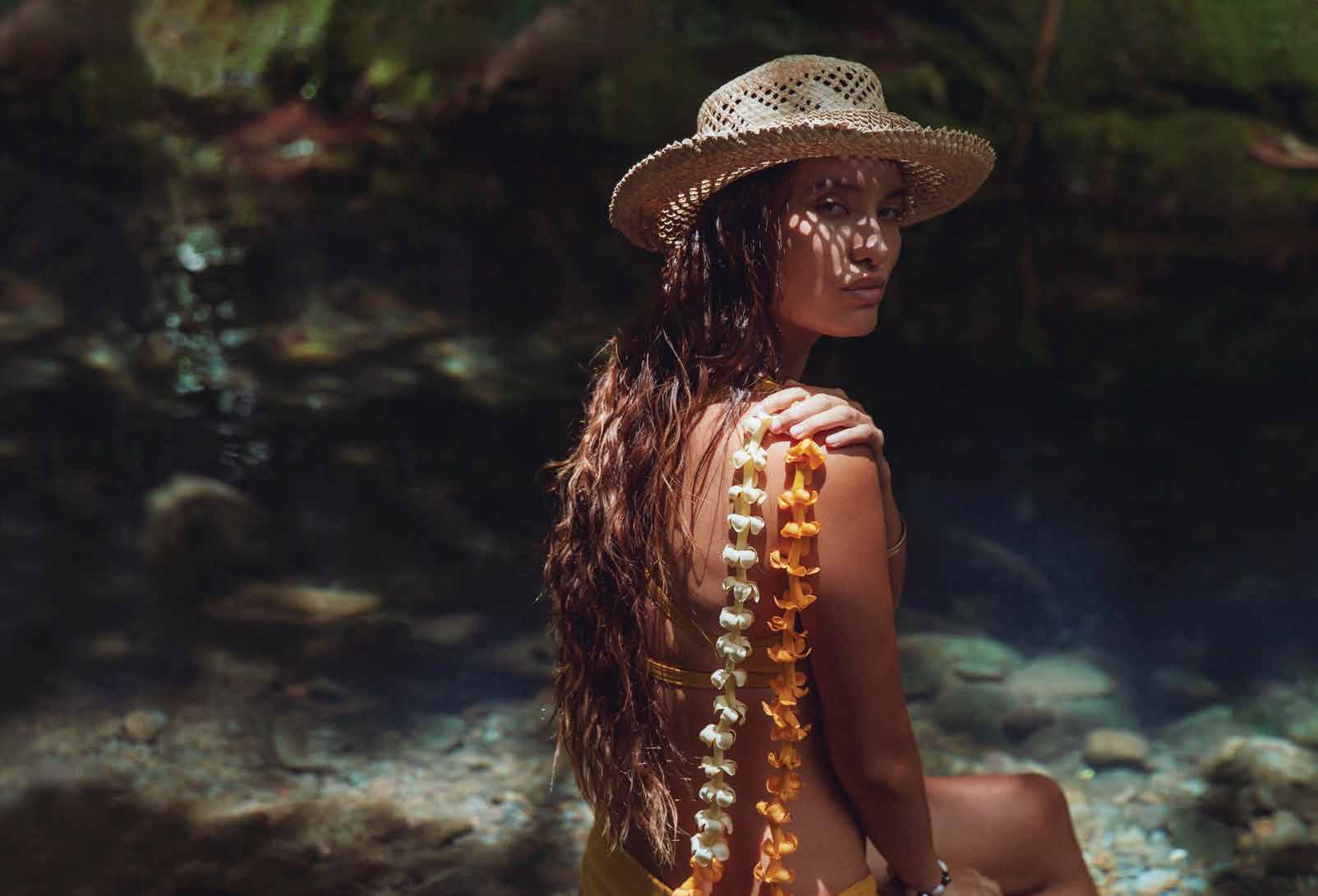
From pareu to slip dresses, lounging around O‘ahu in lilting silhouettes synonymous with a certain island laissez faire.
116 | FLUXHAWAII.COM PRESENT
Modeled by Haumea
Images by Cheyne Kalai

 Swimsuit by Mikoh Lei by Haumea
Swimsuit by Mikoh Lei by Haumea
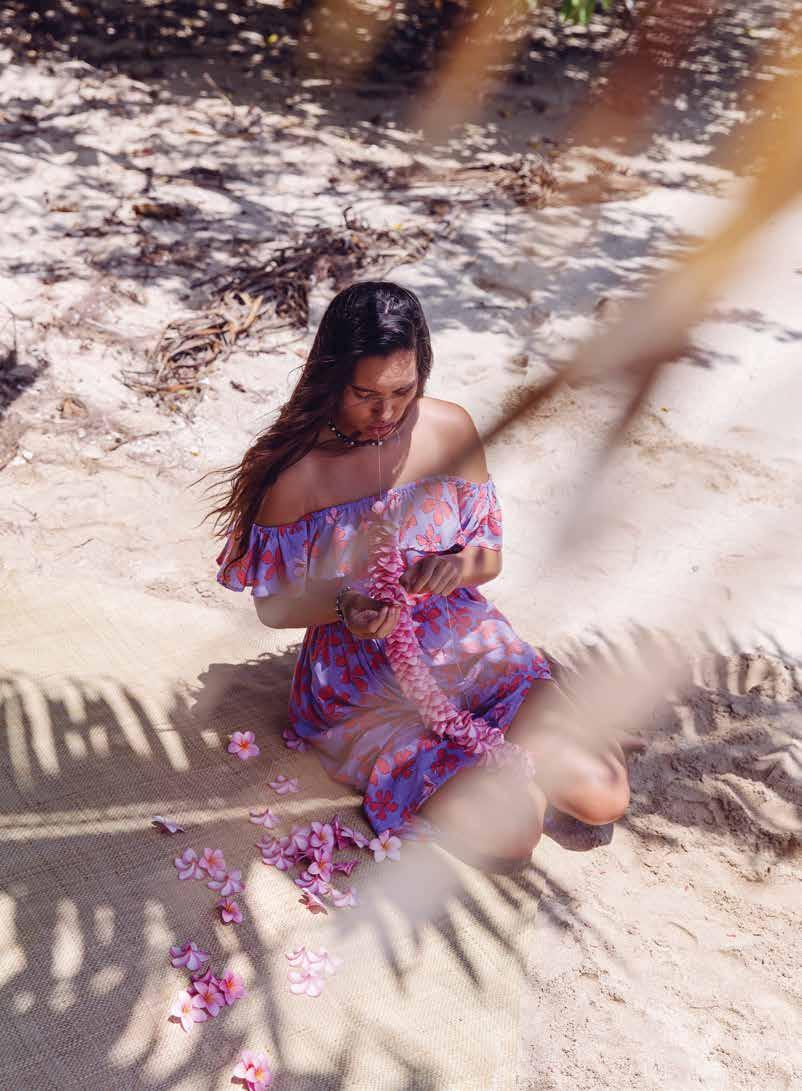

 Mu‘umu‘u by Posh Pua Pareu by Acacia
Mu‘umu‘u by Posh Pua Pareu by Acacia
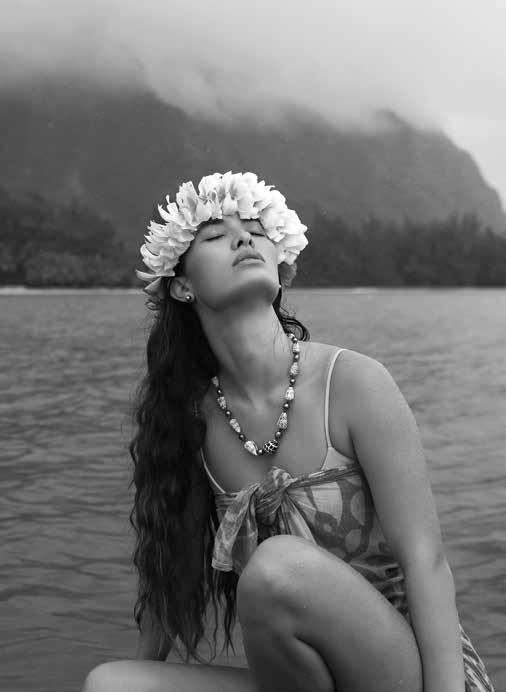 Pareu by Tahiti Art Maohi Jewelry by Kalai Dress by Marina and Co.
Pareu by Tahiti Art Maohi Jewelry by Kalai Dress by Marina and Co.

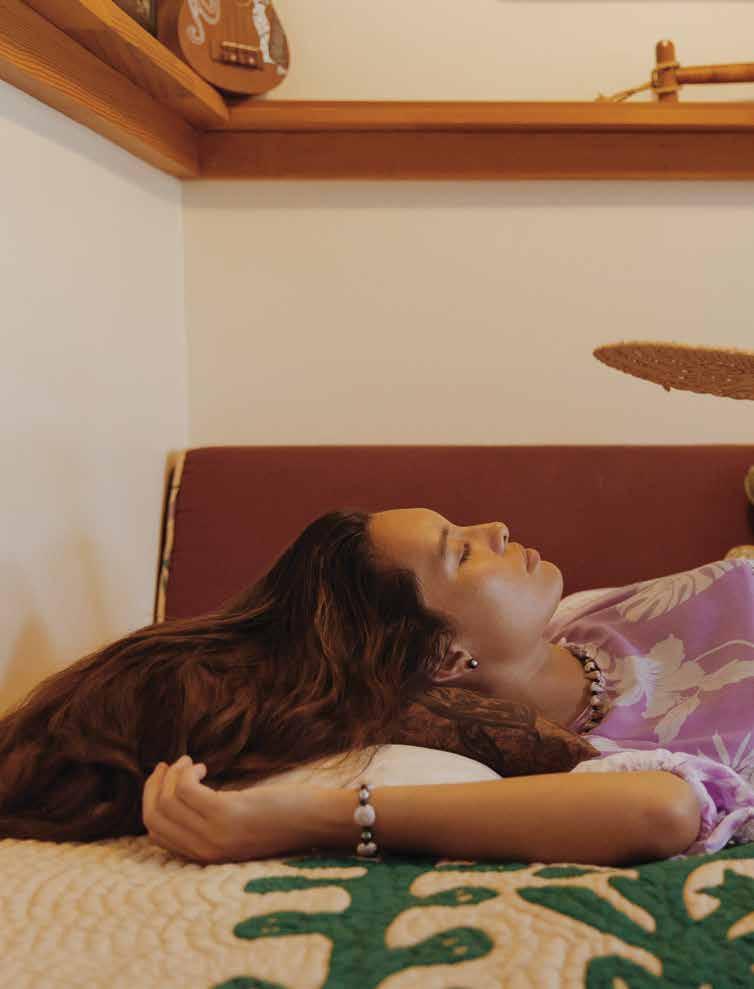

 Mu‘umu‘u by Eimeo Jewelry by Kalai
Mu‘umu‘u by Eimeo Jewelry by Kalai
 Jewelry by Kalai
Pareu by Pacific Island Arts
Lei by Haumea
Jewelry by Kalai
Pareu by Pacific Island Arts
Lei by Haumea



 Pareu by an artisan in Tahiti Mu‘umu‘u by Eimeo
Pāpale by Kumu Keoua Nelsen
Pareu by an artisan in Tahiti Mu‘umu‘u by Eimeo
Pāpale by Kumu Keoua Nelsen
As single-use plastics threaten to smother the planet, artist
Tiare Ribeaux manufactures a living, breathing alternative.
You probably won’t see artist Tiare Ribeaux walking around town in a colorblocked, oddly gummy coat made of agaragar. Not because she hasn’t made one— she has, in appealing shades of strawberry and mango that look good enough to eat, in a surreal Fruit Roll-Ups kind of way. It’s just that in the trademark swelter of Oakland, California, where the Honolulu native has lived for most of the last decade, such a garment would simply disintegrate.
“Bioplastics are at the intersection of being alive and not being alive,” Ribeaux says. A transdisciplinary artist and the founder of new-media gallery and community space B4BEL4B, located in downtown Oakland, she is endlessly fascinated by the potential of bioplastics. Her work with plant-based materials like gelatin, agar-agar, and tapioca starch is both a statement on, and a possible solution to, the environmental enemy that is petrochemical plastics, roughly 40 percent of which are manufactured to be used only once and destined to languish in landfills.
Through bioplastic molded cuffs and dresses cut from the gelatinous, skin-like materials—so skin-like that if they’re
draped over touch screens, hyperlinks will activate—Ribeaux uses fashion as an entry point for her message of environmental sustainability. While a coat can protect you from the weather (other artists and designers are working with chemists to make biotextiles sturdier for everyday use), Ribeaux’s garments and accessories, tinted with natural dyes like hibiscus, turmeric, and volcanic ash, would just plain surrender to it. But maybe that’s the point. “I really think of biotextiles as provocation,” she says.
Ribeaux’s first foray into fashion was in 2009, and in its own whimsical way, was also a form of earthly worship. She designed Fiume, a reclaimed-textile fashion line that took its design cues from the effect of rain on Hawai‘i’s geology. A subsequent stint working as an entrylevel technician at Algenol, a Hawai‘ibased developer of biodiesel from algae, eventually led Ribeaux to the intersection of art and science. Her time with Algenol is clear in another of her ongoing multimedia projects, Cyanovisions, which considers a world in which humans are genetically engineered to have survival traits of the world’s heartiest and most basic organism,
FUTURE
Life
Fabric of
128 | FLUXHAWAII.COM
Text by Leilani Marie Labong Images by Peter Prato

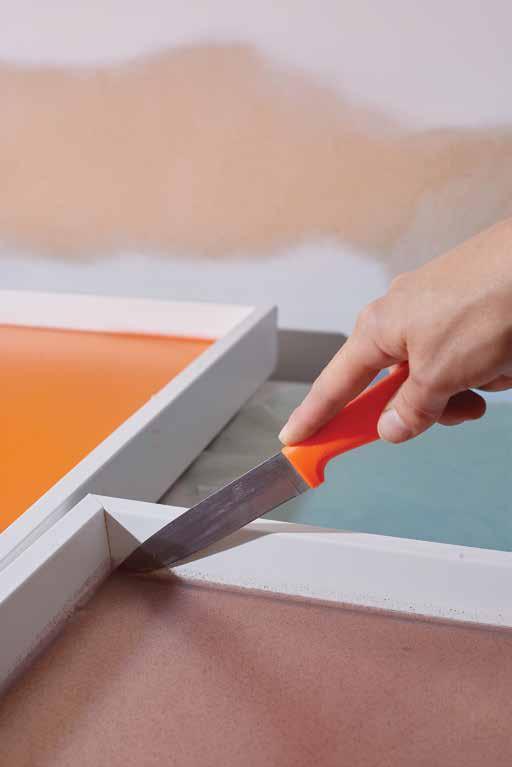
For the artist, fashion becomes an entry point for a message of environmental sustainability.

“Bioplastics are at the intersection of being alive and not being alive,” Ribeaux says.
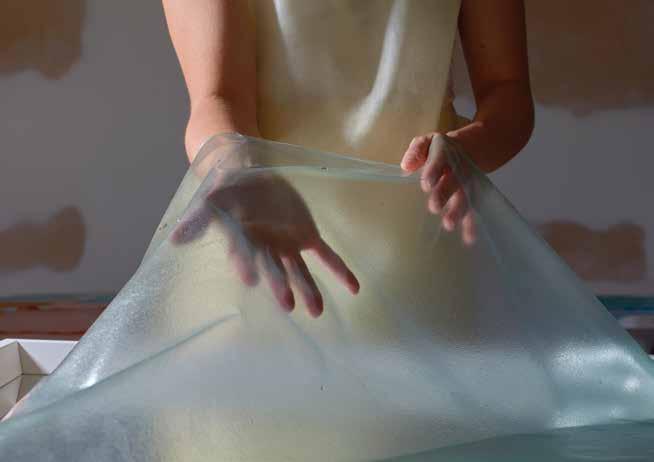
cyanobacteria, also known as bluegreen algae. But it’s the innovation that biotextiles inspire that really resonates with Ribeaux. To spread the gospel of these quasi-living materials and their potential as alternative plastic, she geared her 2019 project, the Bioplastics Cookbook, toward ecominded hobby scientists with only a home kitchen in which to experiment.
The artist’s Native Hawaiian heritage makes her uniquely sensitive to an environment at risk. “I feel like I have a special connection to the kind of nature that is lush and alive,” Ribeaux says. She recalls her grandmother’s anecdotes of Waikīkī in its swampy, pre-tourism glory, when 77 degrees was a perfectly balmy daily high—the mercury has risen as development continues to boom. Ribeaux also waxes mournful about the decline of Hawai‘i’s endemic ‘ōhi‘a tree, caused by a foreign fungal disease, and the large
chunks of plastiglomerate on Hawai‘i Island’s Kamilo Beach, masses of global plastics, sand, and rock melted together from the heat of bonfires.
The artist contemplates the fate of Pele, the volcano-dwelling Hawaiian goddess who reigns over the land.
“What does this plastiglomerate mean for spiritual beings like Pele, and for our native and modern mythologies?” she muses. While the world fawns over Hawai‘i’s headline-making environmental legislation—such as an introduced bill that would ban distribution or provision of single-use plastic bags or beverage containers and prohibit local governments and restaurants from using single-use utensils, stirring sticks, polystyrene to-go containers, and straws—its rich folklore seems less considered. What if, Ribeaux speculates, the unsightly plastic tumors, laden with native sand and volcano rock, were removed? Would that invoke the
wrath of Pele? Legend has it that the deity curses anyone who takes elements of the sacred land beyond its natural boundaries. In this way, Ribeaux’s bioplastics are much more than degradable textile alternatives— they are an attempt at what she calls a “spiritual remaking in a toxic world.”
“This is why I’ve felt compelled to do work that ultimately leads back to the environment,” Ribeaux says.
“I’m really excited about the traction that my bioplastics project has gotten, because it’s going to take a massive shift in perception, as well as a behavioral shift, for things to change in the world.”
132 | FLUXHAWAII.COM

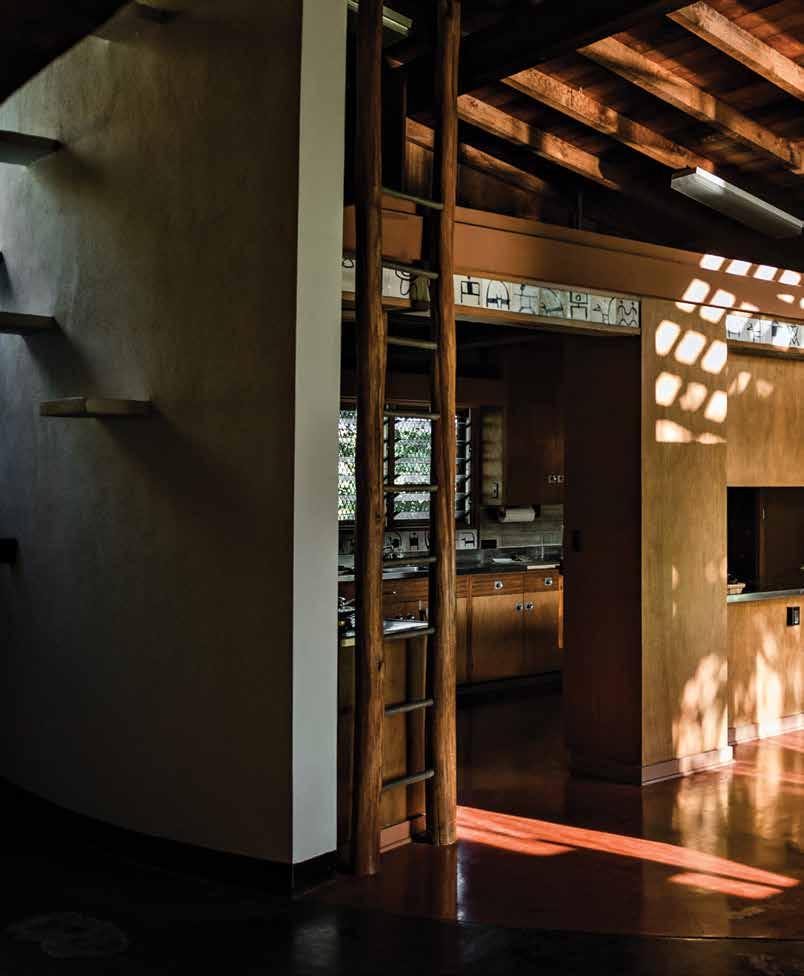 The sun-dappled home of the late Jean Charlot. Image by John Hook.
The sun-dappled home of the late Jean Charlot. Image by John Hook.
LIVING WELL
“Hawai‘i has the key, and that key is aloha.”—Pilahi Paki

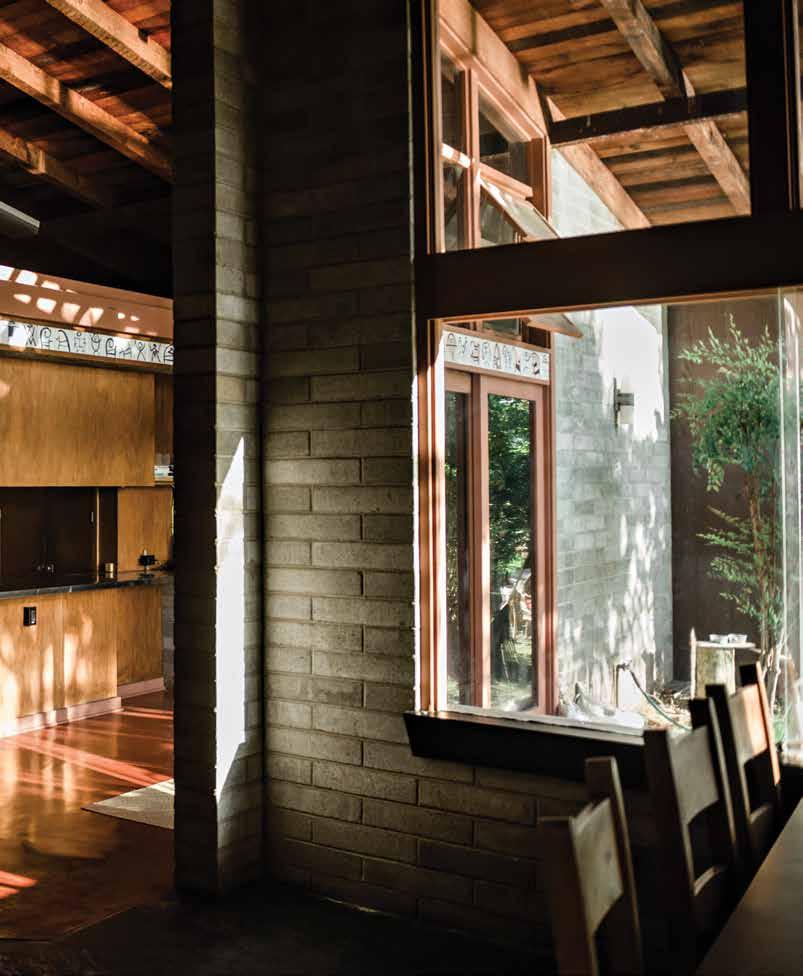
Artist in Residence
In his modernist Kāhala dwelling, the ever-present artist Jean Charlot’s presence cannot be ignored.
TEXT BY EUNICA ESCALANTE
IMAGES BY JOHN HOOK, CHRIS ROHRER & COURTESY OF THE JEAN CHARLOT ESTATE LLC

Remnants of the artist Jean Charlot still haunt the home. Past a series of cantilevered steps within what was once his studio are pinprick indentations along a curved cork wall, which Charlot made when he pinned up drafts of his famed murals. Ambling through the historic property, I stumble upon petroglyph tiles handpainted by Charlot, inlaid in the floors, walls, and beams like Easter eggs of artwork hidden throughout the structure.
Then there is the home’s pièce de résistance: Above a set of sliding glass doors that lead to the lānai is a fresco spanning the length of the living room. Native flora and tropical plants painted in the Aubusson style, a burst of thick foliage in verdant shades of green, fill the scene.
It was completed by Charlot with the assistance of renowned Hawaiʻi artist Juliette May Fraser,
The home is ensconced in the quiet Kāhala suburbs.
136 | FLUXHAWAII.COM
LIVING WELL | DESIGN |
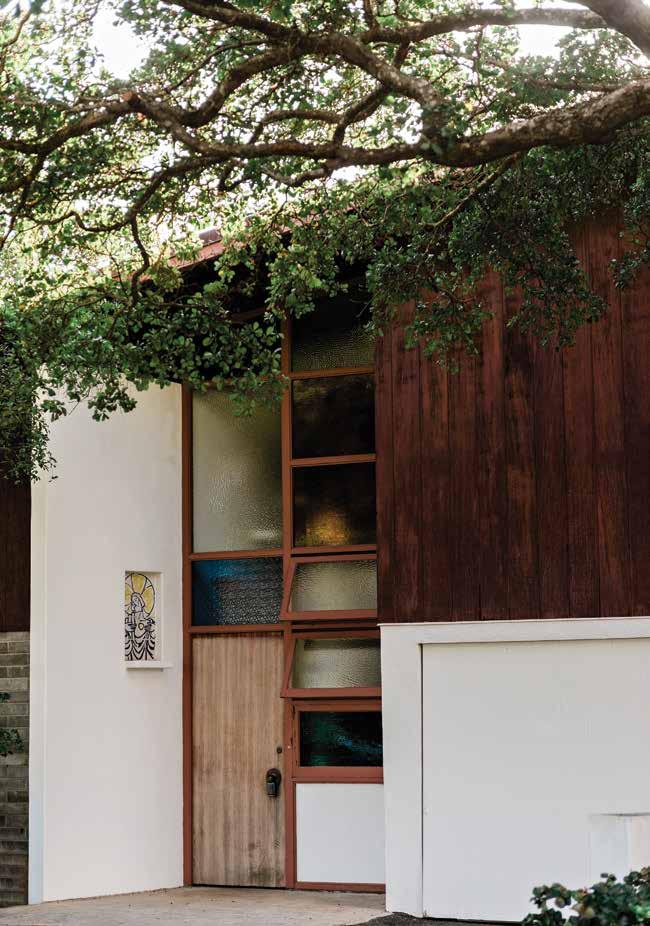
137

making it the first artwork to decorate the home—and the last. In the years since the home’s vacancy, when most of the art and books and personal memorabilia have been emptied out, this is among the final to remain. From its completion in 1958 to Charlot’s death in 1979 this home was where the celebrated artist lived, played, and worked.
Charlot first came to Hawaiʻi in 1949, commissioned by the University of Hawaiʻi at Mānoa to paint a fresco. The project subsequently turned into a fulltime teaching position in the university’s art department. But by 1957, the faculty housing where the Charlots stayed began to feel too cramped for their family of six. They bought a plot in what was then the yet to be developed neighborhood of Kāhala. Noted Hawaiʻi architect George J. “Pete” Wimberly was contracted to design the home. Blueprints drafted in Charlot’s sketchbooks, however, show how involved he was in the design process.
The split-level ranch style home is a blend of Charlot’s French and Mexican backgrounds. Its vertical emphasis evokes the French rural architecture of his childhood.
The brick floors and spacious back courtyard are reminiscent of the Mexican homes that Charlot, who was of Aztec descent, inhabited in his early adulthood.
It was in Mexico where Charlot garnered fame as an artist, working amongst the likes of Diego Rivera and Fernando Leal. In 1922, he completed Massacre in the Templo Mayor, the first mural of a new artistic style that would come to be known as the Mexican Muralist Renaissance. The piece’s use of bright colors and focus on indigenous subjects would become his trademarks. It was also the first time that he utilized the buon fresco technique that would become a quintessential element of his oeuvre.
By the time Charlot got to Hawaiʻi over two decades later, he had received world renown for his part in the founding of
138 | FLUXHAWAII.COM
The home’s aesthetics blur the line between interior and exterior. The indoor-outdoor dining room table was designed by Charlot himself.



The home’s pièce de résistance is the fresco spanning the length of the living room. Charlot designed it to imitate the Aubusson tapestry style of the 18th and 19th centuries.
 Charlot painted the mural in collaboration with Hawai‘i artist Juliette May Fraser.
Charlot painted the mural in collaboration with Hawai‘i artist Juliette May Fraser.
the Mexican Muralist Renaissance. Yet once Charlot arrived in Hawaiʻi, Fraser said, “he felt as though he had ʻcome home’ for the first time.”
“For 30 years, except for brief trips, he never left,” Fraser said in a Star Advertiser interview. “He lived here far longer than any other place in the world. When Jean found us, he became one with us—completely.”
This was evident in how the home, despite its foreign influences, was still uniquely of the Hawaiian Islands. There is the wrap-around lānai, a quintessential Hawaiʻi design. Natural materials, many of them native, texturize the home, such as the slab wall separating the dining and living rooms which is made entirely of hāpuʻu, the Hawaiian tree fern. It seems like an ordinary wall until a sliver of sunlight streams in, illuminating the countless sprigs crisscrossing its surface. It reflected the sense of place that Charlot so often emphasized in his work.
“Charlot’s interest in Hawaiian culture was
Charlot’s sketchbooks show how involved he was in the home’s design.
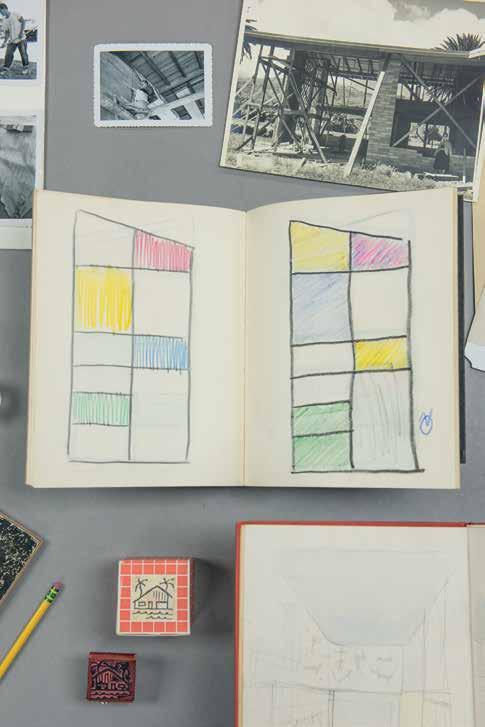
142 | FLUXHAWAII.COM
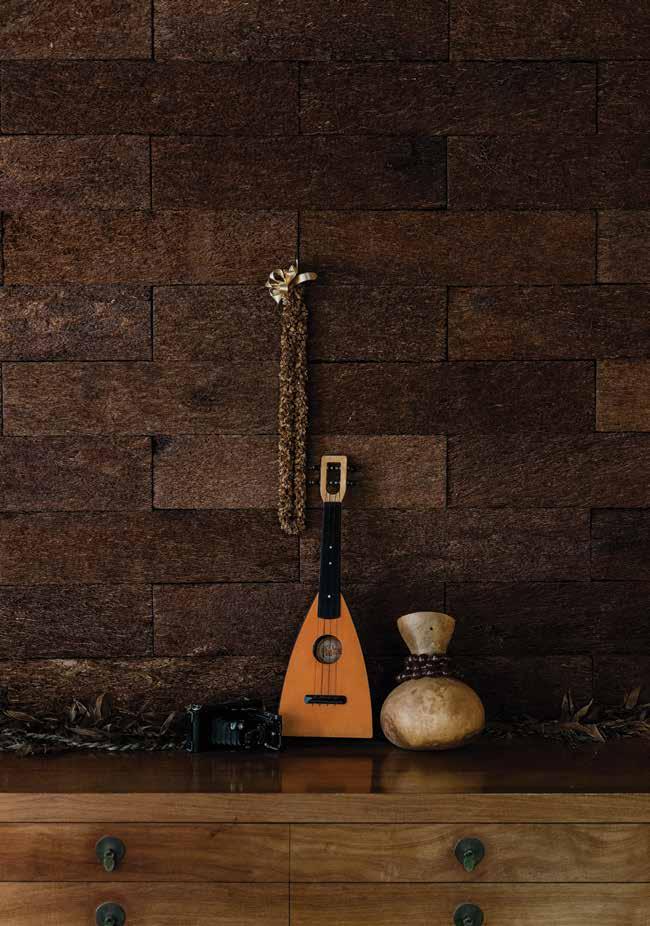
FLUXHAWAII.COM | 143
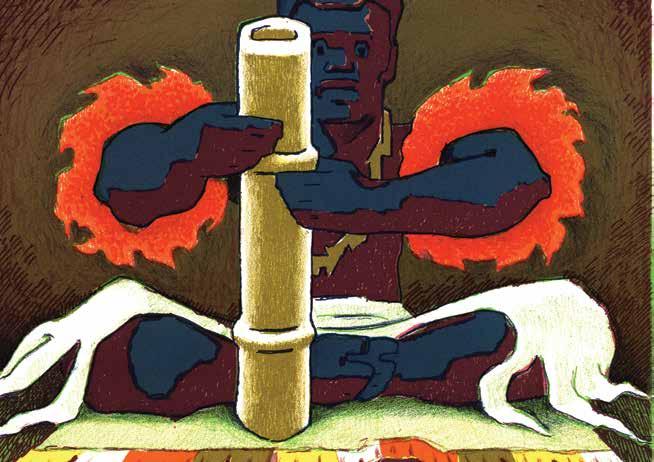
unusual at the time,” his son, John Charlot, wrote in an essay examining his father’s relationship to Hawaiian culture. Charlot arrived in Hawaiʻi amidst a burgeoning tourism industry. Mainstream depictions in art and in film promoted a romanticized, exotic image of the islands. Charlot detested this.
While most artists had “restricted themselves to picturesque visions of Paradise with lissome Polynesian temptresses,” John wrote, Charlot immersed himself in the culture so that he may give it justice within his art. He took Hawaiian language lessons with linguist Samuel H. Elbert. He consulted cultural experts in the accuracy of his Hawaiʻi focused murals. He catered his house parties with Helena’s Hawaiian Food.
Charlot’s Hawaiʻi phase was stirred by the verdant landscape that surrounded him and inspired by the way Native Hawaiian art symbolically merged man and nature. “Hawaiʻi focused on an all-encompassing nature,” writes John. “Rather than the environment and the human community
being separate, in Charlot’s mural they form a coherent whole, all bathed in the beautiful local light.”
This coherence of nature and man is evident throughout the home’s design, which blurs the interior and exterior. Floor-to-ceiling glass doors create the illusion of a home with no walls, while natural materials like hāpuʻu and ʻōhiʻa wood bring the outdoors in.
The dining table is the paragon of this philosophy. Designed by Charlot himself, the table branches out from the exterior wall, one half in and the other out, the delineation made by sliding glass windows that meet on top of the table’s middle. During the many soirées held by the Charlots, which were frequented by many in Hawaiʻi’s intellectual circles (evidenced by the home’s guestbook), the windows were slid open, the congregation transcending the home’s physical barriers. Walking through the home, feeling my feet atop the hardwood floors where Charlot walked, it is hard to shake the feeling that the artist is still there. After
144 | FLUXHAWAII.COM
Above, detail of Bamboo Player by Jean Charlot. Courtesy of Jean Charlot Estate LLC. Right, a page from the Charlots’ guest book, signed by artist Juliette May Fraser.


over two decades living in the home, this was where he spent the last of his days in March 1979. Six months earlier, he completed his last mural, for Maryknoll Elementary School, part of the many public art works he did for the state.
“Charlot pops into people’s lives in so many different ways—be it through a mural at their old school or a print they’ve discovered,” says Bronwen Solyom, erstwhile curator of UH Mānoa’s Charlot Collection.
“It’s inspiring to know he’s touched so many people.”
SEEKING CHARLOT
Though his home, currently under the ownership of UH Mānoa’s School of Architecture, is not open to the public, except by appointment, Charlot’s artistry is on display in various Honolulu sites.
“United Public Workers Mural”
This six-panel mural spanning the length of the United Public Workers Building took six years to complete. It was a collaboration between Charlot
and ceramicist Isami Enomoto. It depicts scenes of union members at work and in action. Charlot insisted that the two panels bookending the piece should be of union member demonstrations to establish balance and show workers’ strength.
Henry B. Epstein Building, 1426 N. School Street
“Early Contacts of Hawaiʻi with Outer World”
This mural replaced one of the same name when the building was being demolished in 1966. The original 1952 mural, which was over 60-feet long, was cut up into approximately 70 easel sized pieces. This piece inside the First Hawaiian Bank, then named First National Bank, is an almost exact replica of the original.
First Hawaiian Bank in Waikīkī, 2181 Kalakaua Avenue
“Relation of Man and Nature in Old Hawaiʻi”
This was the first piece commissioned of Charlot by the university and was
what first brought him to Hawaiʻi. Charlot delved into extensive research to ensure the accuracy of the work, speaking with Hawaiian scholars and visiting places like the Bishop Museum. It was done in Charlot’s typical buon fresco technique and depicts a Hawaiian feast just before the fateful arrival of Captain Cook.
University of Hawaiʻi at Mānoa, Bachman Hall 1st Floor, 2444 Dole Street
The Charlot Courtyard featuring “Chief’s Canoe,” “Conch Players,” “Hawaiian Drummers,” and more A five-piece collection once part of two murals originally installed in a café at the Hilton Hawaiian Village, then named Kaiser Hawaiian Village Hotel. When the hotel was remodeled in 1986, the murals had to be cut out of their concrete walls. One mural was so fragile that it was disassembled into smaller vignettes.
Hawaiʻi Convention Center, 5th Floor, 1801 Kalakaua Avenue
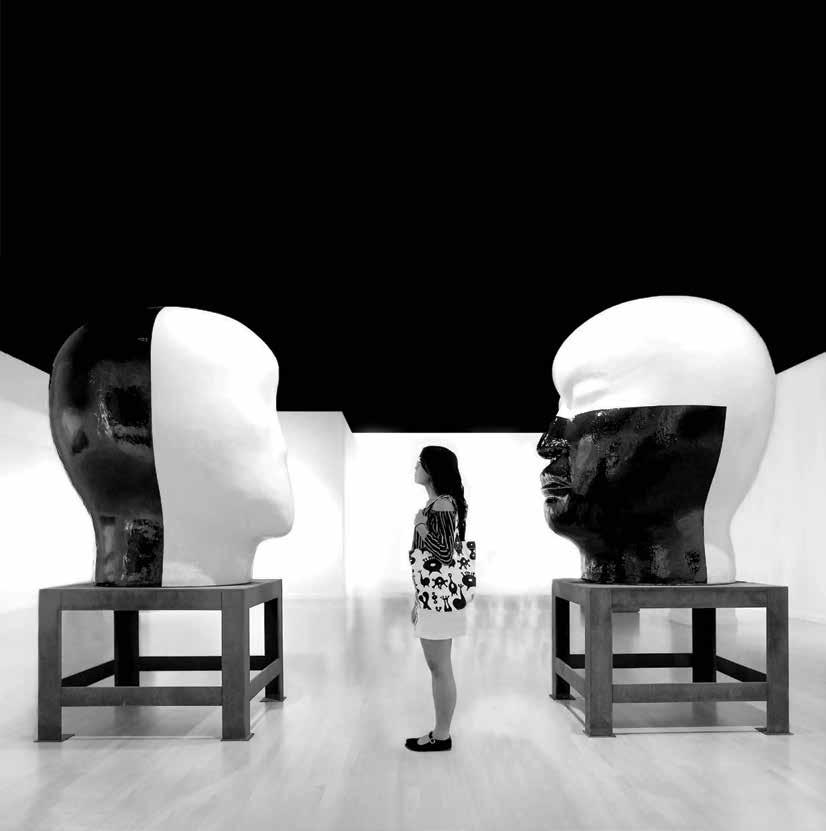
146 | FLUXHAWAII.COM
HAWAI‘I STATE ART MUSEUM
250 South Hotel Street
Monday–Saturday: 10am–4pm (First Fridays: 6pm–9pm Valet parking on Richards St.)
HiSAM HEAD TO
Thank you, Luxury Row and Art Explorium for the continued focus on the importance of the visual arts for Hawaii’s community.



Friends of HiSAM friendsofhisam.org Jun Kaneko ‘Untitled’ 1995, glazed ceramic sculptures, 65” x 49.5” x 58” FREE ADMISSION
Top Pick Choice: Procession
1981
By Reiko Brandon
linen, silk, copper wire, wool
65”
x 56.5”
vote for your favorite pick at friendsofhisam.org. You will be entered in a monthly drawing for an original work from one of the living Top Artists. Voting ends on December 31, 2019.
Photographed by Frank Sojka
Temple Valley
In the uplands of Kalihi, a unique dojo melds the mind and the body through a revolutionary school of Zen teachings.
TEXT BY TIMOTHY A. SCHULER
IMAGES BY JOSIAH PATTERSON

The wind is loud as it whips a veil of rain off the mountains and tosses it onto Kalihi Valley. Michael Hodge and I are standing on a small hillock near the center of Chozen-ji temple. We’re exposed. The rain is light but hardened by velocity, and each tiny drop feels as solid as the stone in front of us, which is inscribed with a large white circle, an enso , which in Japanese Buddhism represents both emptiness and enlightenment. Hodge, who is tall and bearded and definitely not Japanese but who nonetheless is Chozenji’s resident priest, is recounting the temple’s unlikely history. Chozenji was established in 1972 as a Zen dojo in the Rinzai tradition, a sect of Japanese Buddhism that emphasizes kōans , riddle-like statements used in meditation. From the beginning it was a temple of iconoclasts. Its
In 1979, Chozen-ji was the first and only daihonzan in the United States.
148 | FLUXHAWAII.COM
LIVING WELL | RINZAI |
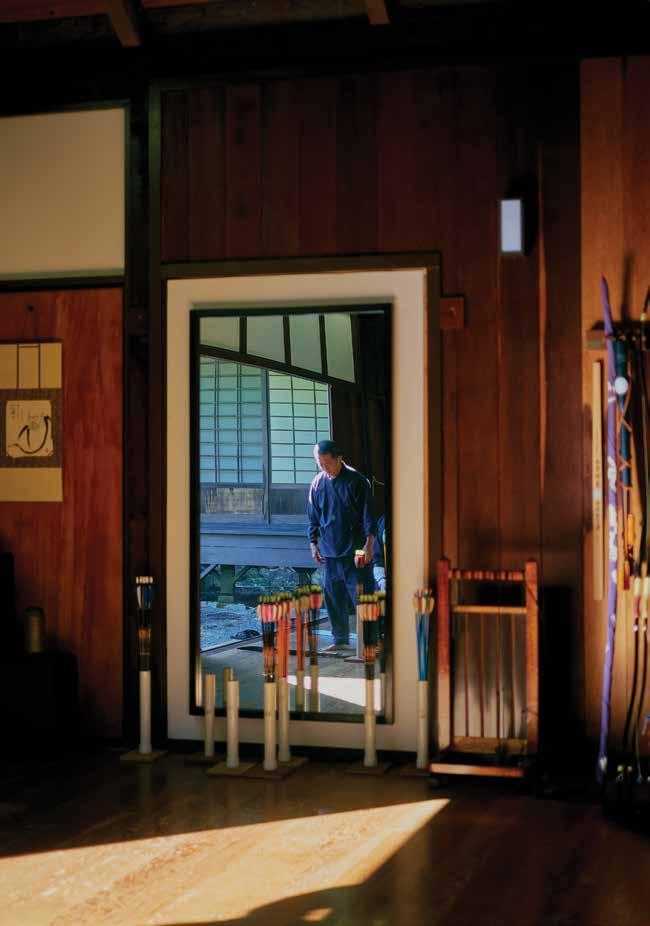

founders—Omori Sogen, an internationally known Zen master from Japan, and Stanley Tanouye, known to most as Tanouye Roshi, a martial arts prodigy who for his day job taught band at Farrington High School— had come to Zen by way of martial arts. As a result, Chozen-ji places an unusual emphasis on physical training. In addition to practicing zazen, a form of seated meditation that is done for an extended period of time, students also learn a martial art such as kendo (the way of the sword) or kyudo (the way of the bow).
By entering Zen through both the body and the mind, Sogen and Tanouye believed a person could transcend even Zen. (The name Chozen-ji literally means, “The Temple of Zen Transcending Zen.”) In 1979, Sogen designated Chozen-ji as a daihonzan, or a main temple, of a new line of Zen Buddhism. This gave it the power to selfgovern, and produce its own Zen masters. In a handwritten document that formalized the decision—which also made Chozen-ji the first and only daihonzan in the United States—Sogen addressed the Rinzai elders
in Japan: “Open your eyes to this, and together let us send it out to the world.”
Since then, hundreds of individuals have found meaning in Chozen-ji’s radical Zen Buddhism, which is quite possibly not Buddhist, nor, for that matter, Zen. Hodge prefers not to use labels. Whatever it is, the temple has attracted peoples from all walks of life, from some of Honolulu’s most powerful individuals, including Colbert Matsumoto, the executive chairman of Island Insurance and the vice chairman of the Japanese Cultural Center, to its most nefarious, like Royale Kamahoahoa, a “selfadmitted hitman,” Hodge says. Its aim is to help individuals, Buddhist or not, grapple with the deepest questions of existence. Chozen-ji has welcomed Catholics, atheists, agnostics, existentialists. Hodge borrows the analogy a Google engineer once used: Buddhism is a type of software. The hardware is the body. At Chozen-ji, what’s being refined, through zazen and other practices, is the hardware. “We’re working at that deeper level,” Hodge says. “You can run the
Tucked into Kalihi Valley, the temple is an oasis of tranquility.





150 | FLUXHAWAII.COM



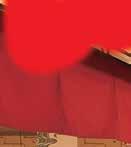

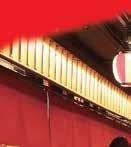
























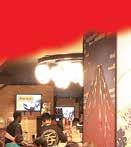







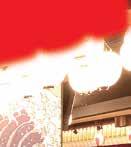

































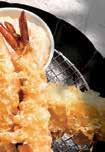














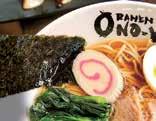






































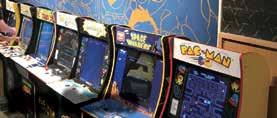




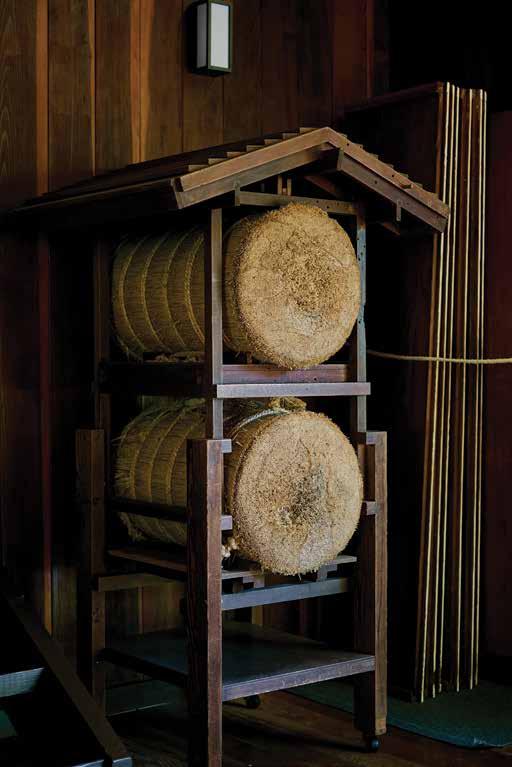 One of its founders, Tanouye Roshi, came to Buddhism by way of martial arts. As a result, Chozen-ji places an unusual emphasis on physical training.
One of its founders, Tanouye Roshi, came to Buddhism by way of martial arts. As a result, Chozen-ji places an unusual emphasis on physical training.

Chozen-ji welcomes people of all faith—Catholics, atheists, agnostics, and existentialists—in an effort to help individuals grapple with the deepest questions of existence.
software of Christianity. You can run the software of a chef. You can run the software of a band teacher.”
Indeed, a number of Hawaiian spiritual teachers have spent time at Chozenji, including Pilahi Paki, who according to Hodge once said the temple was one of four “spiritual mountains” on O‘ahu. He tells me this as we survey the temple grounds from the hill. “You stand up here, and there’s this feeling that you’re in the center of something,” Hodge says. After a beat, he adds, “At the same time, there’s a guy who raises chickens to fight over there.” The moment is illustrative of the tone at Chozen-ji. It may be rigorous, but it’s not humorless.
The question is whether it is still valuable. Even as mindfulness has become a buzzword and a billiondollar industry, Zen temples like Chozen-ji have shed members in recent years, in part due to high barriers to entry. New students to the Hawai‘i daihonzan were long required to attend a separate meditation class for six weeks before joining the rest of the community.
Recently, Chozen-ji has become more accessible to the public.

154 | FLUXHAWAII.COM



“The idea was, if you want to be here, you’re gonna have to go through some gates. That doesn’t work very well, especially with millennials,” Hodge says, chuckling.
In the past year, Chozenji has become more open, with public meditation classes held daily, except for on Sundays. In summer 2017, the temple retooled its website and created an Instagram account, hoping to expand its digital presence. It may be working. Hodge says he’s seen more new faces lately. Of course, about half of the people who show up for a weekend meditation class never come back, Hodge says. “What we’re doing is hard. It’s not fun.”
But it is meaningful, at least for some. “Chozen-ji, to me, exists as one of the last places people can go that takes on the whole person,” Hodge says. “We’ve got kōans for your mind, we’ve got athletics for your body, we’ve got religion for your spirit.”
Hundreds have found meaning in Chozen-ji’s radical Zen Buddhism.
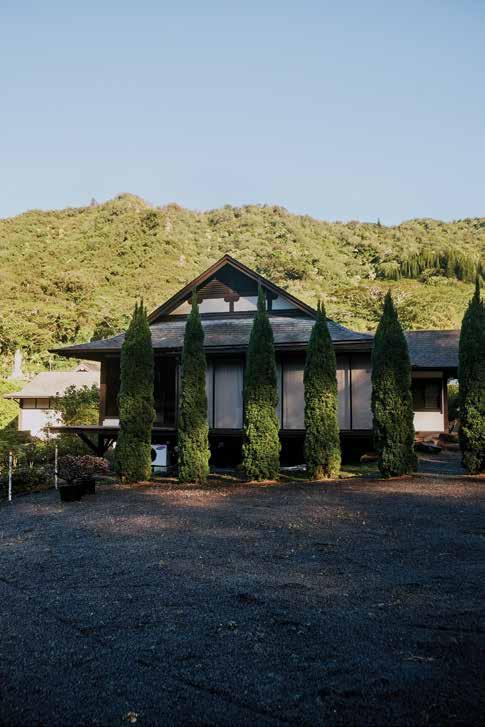
158 | FLUXHAWAII.COM

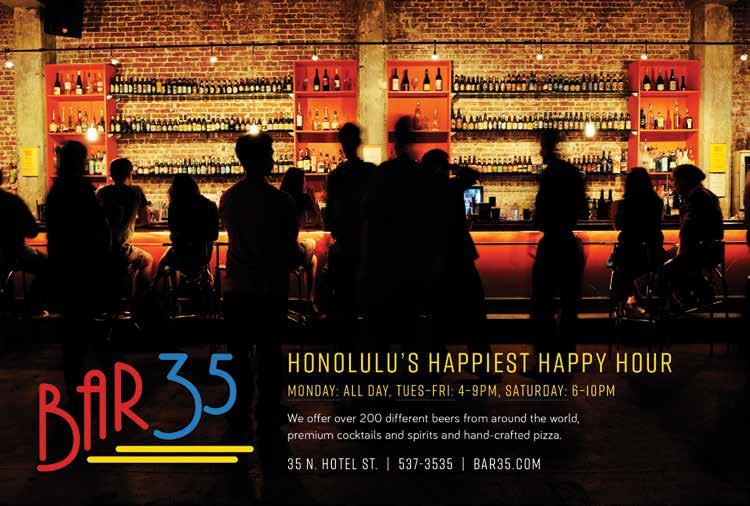
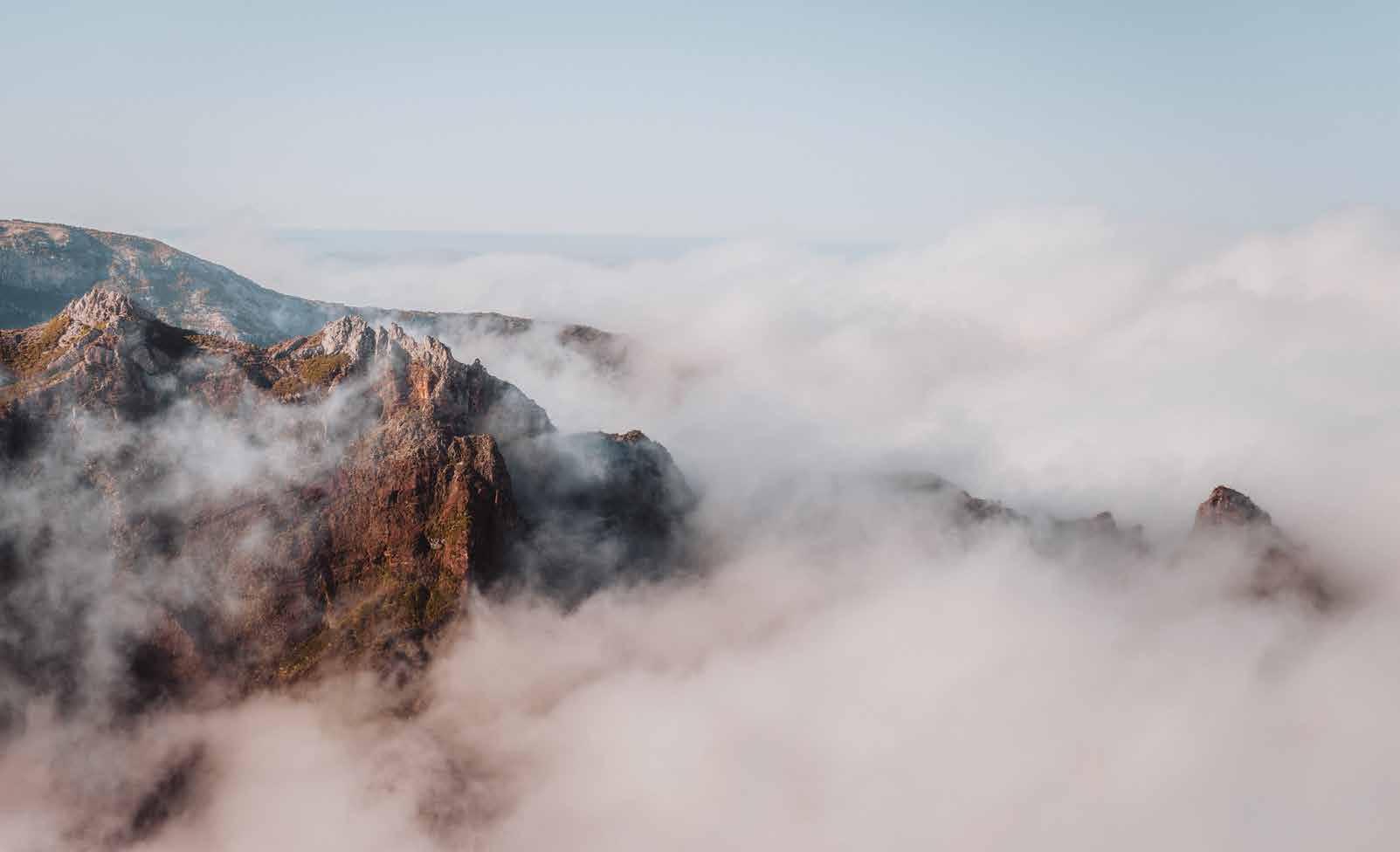 The cliffs of Madeira. Image by Lili Kovac.
The cliffs of Madeira. Image by Lili Kovac.
EXPLORE
“As any true bargain-hunter knows in their heart, the perfect deal is fundamentally unfindable.”—Natalie Schack

A Coastal Communion
In its volcanic terrain and endemic wildlife, a writer from Hawai‘i finds home away from home in Madeira.
TEXT BY SHANNON WIANECKI
When I first heard Madeira called “the Hawai‘i of Europe,” I shrugged. I figured the small island chain 600 miles off the coast of Portugal had a few sunny beaches and a surf break or two. End of story. But after spending two weeks there last summer, I can confirm the existence of a Hawaiian doppelgänger in the Atlantic: a volcanic archipelago with subtropical forests, black-sand beaches, and waterfalls that pour straight onto cliff-hugging coastal highways.
Reaching the seaside capital of the region, Funchal, required ricocheting down a steep hill into a labyrinth of mostly one-way cobblestone streets. Downtown Funchal was a confusion of terracotta rooftops, whitewashed
terraces, and picturesque lines of laundry hung out to dry. So far, so European. At an outdoor restaurant, I ordered the special: grilled sardines with sweet potato. Simple and perfect, it reminded me of my favorite dish in Hawai‘i: pan-fried ‘ōpelu at Manago Hotel.
Next I drove north, through the forested heart of the Madeira Island, the largest and most populated of the archipelago. When Portuguese sailors discovered Madeira Island in 1419, the 286-squaremile extinct volcano was inhabited only by birds, lizards, and insects. Endemic laurel trees covered the mountainous terrain crowned by jagged peaks more than 6,000 feet tall. The first settlers cut down the forest and carved terraces in the
The first Portuguese immigrants came to Hawai‘i in the 1800s to work on the islands’ sugarcane fields. Image by Alex Bykov.
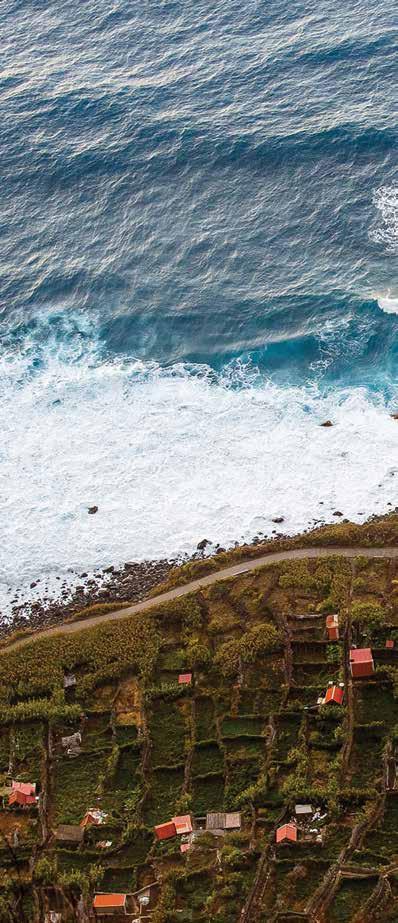
162 | FLUXHAWAII.COM
EXPLORE |
MADEIRA |

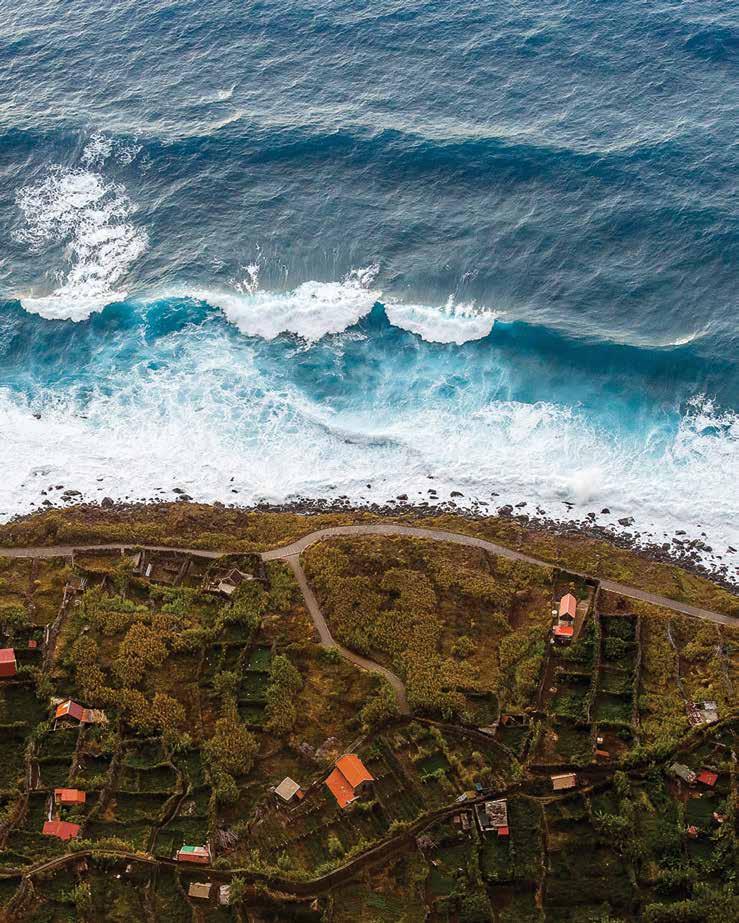
163

steep hillsides to grow wine grapes and sugarcane. Farmers and enslaved Africans dug levadas —aqueducts—to channel water from the wet, windward forests to the dry, leeward farms.
In the 1800s, a fungal blight wasted Madeira’s vineyards, devastating livelihoods and leading to widespread famine. William Hillebrand, the renowned botanist who had moved to Madeira Island from O‘ahu, suggested that suffering islanders find work in Hawai‘i’s sugar plantations and helped broker their immigration. Ships sailed between the two island chains from 1878 to 1911, delivering around 16,000 Portuguese men, women, and children to the Pacific. Most came from Madeira or the Azores, another archipelago 600 miles north of Madeira; a few families came from Northern Portugal.
To Hawai‘i’s cultural melting pot, the Portuguese contributed sweet bread, malasadas, and bean stew, but the most enduring gift was the ‘ukulele. The toysized Hawaiian guitar is a derivation of two Madeiran instruments: the mâchete and
the rajão . While most Hawai‘i residents vaguely know that the ‘ukulele originated in Portugal, few Madeirans remember their claim to the ‘ukulele’s fame.
When I mentioned the ‘ukulele’s roots to Tomé Mendes and Joaquina Freitas, they expressed surprise. The young couple owns Jaca Hostel, a lovingly converted old family home in Porto da Cruz, which was my home base for the few days I spent exploring the small coastal village. Porto da Cruz occupies a dramatic, rain-chiseled valley that strongly reminded me of Kahakuloa Valley on Maui. Forested sea cliffs loomed over two rocky black-sand beaches separated by a small promontory. Each morning, I scampered up to the point to watch the sunrise spill golden light onto the foaming surf. As predicted, Madeira has surf breaks, some of which are good enough to attract international attention. Jaca Hostel caters to visiting surfers, as well as to hikers who meander along the levadas and scale the island’s scenic peaks. Freitas recommended I try caramujos , her favorite local dish. The bowl of black
Though its cobblestone streets are European, Madeira’s forests and beaches are reminiscent of Hawai‘i. Above, image by Isabel Clever. Right, image by Anthony Dean.
164 | FLUXHAWAII.COM
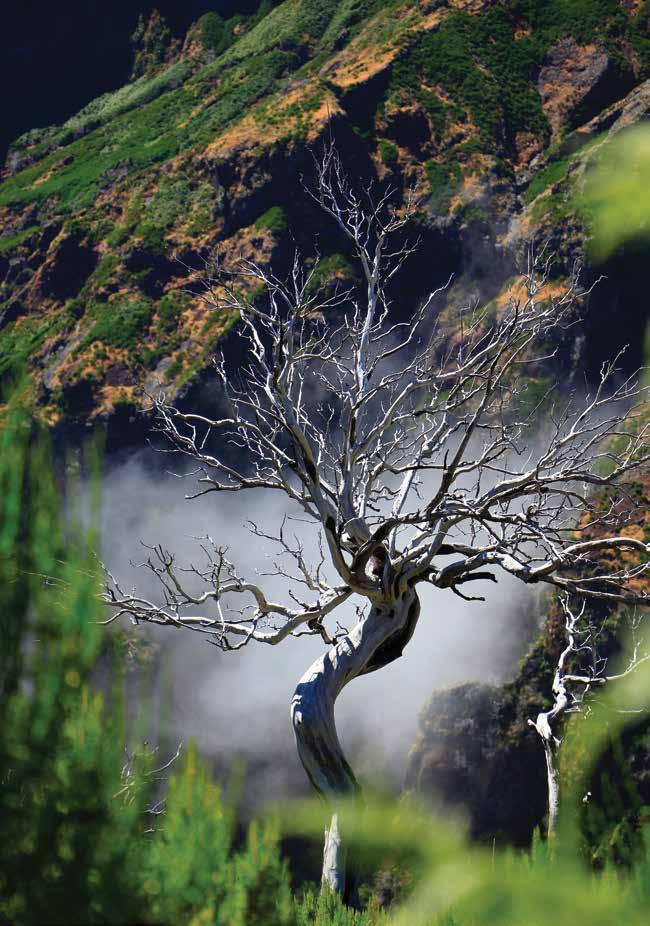
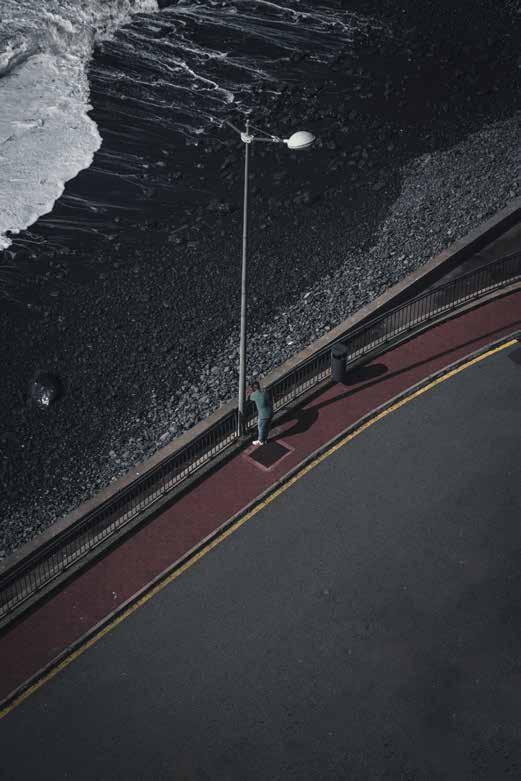 Image by Simon Marsault.
Image by Simon Marsault.
 Image by Said Karlsson.
Image by Said Karlsson.
sea snails—the splitting image of Hawaiian pipipi— came to the table with a pin for digging the tiny, chewy creatures from their shells. I sopped up the garlicky juice with another Madeiran specialty, bolo do caco . The flat, round bread is cooked on a caco , or heated stone. It looks and tastes like a giant English muffin and is scrumptious slathered in garlic butter. I regret not trying the lapas , which looked like a delicious pile of ‘opihi.
From Porto da Cruz, I cruised along the north shore. The coastal highway crested dizzying cliffs, disappeared into tunnels, and passed cascading waterfalls. I returned to Funchal via Pico do Arieiro, Madeira’s third-highest peak. From the windswept summit, I gazed into the deep-green accordion folds of the island’s mountainous wilderness.
This is where the similarities between Hawai‘i and Madeira got downright bizarre. Pico do Arieiro is home to several endemic species,
The greatest similarity between the islands is their wilderness. Images by Jonas Vandermeiren.
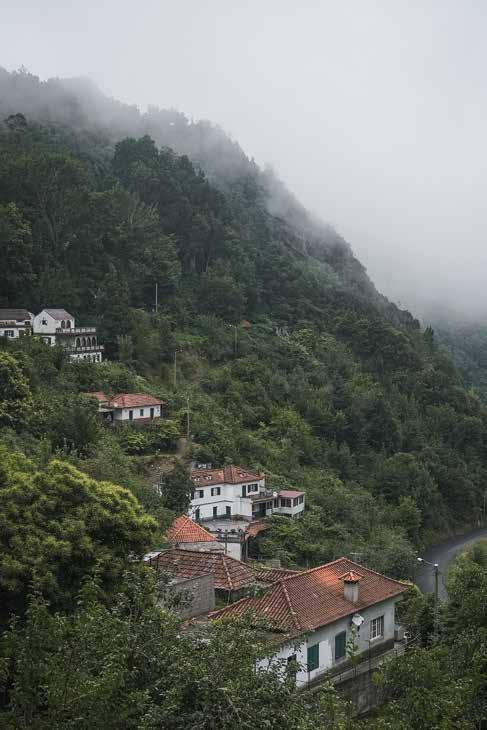
168 | FLUXHAWAII.COM
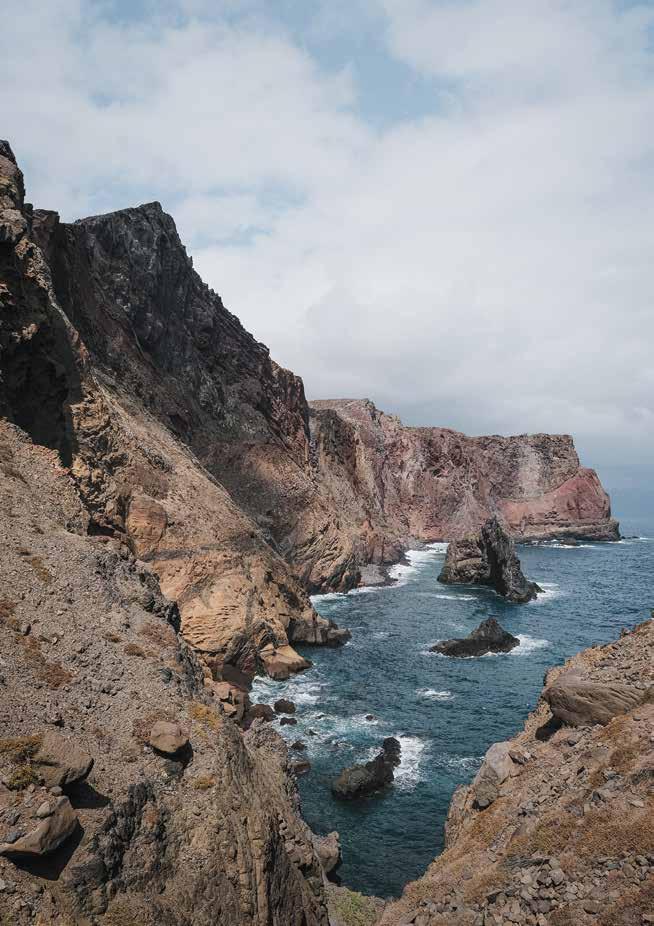
 Image by Chris Slupski.
Image by Chris Slupski.


including a short-eared owl, a groundnesting petrel, and multiple flightless insects. The summits of Haleakalā on Maui and Maunakea on Hawai‘i Island have Hawaiian versions of these creatures: the pueo, ‘ua‘u, and wēkiu bug. Even more uncanny? Madeira and Hawai‘i each claim just two native mammals, a bat and a monk seal. Madeirans call their seal lobo marinho , meaning sea-wolf, while Hawaiians named theirs ‘īlioholoikauaua, meaning the dog that runs in rough seas.
Following these discoveries, I began to fixate on Madeira’s differences: the lilting music of spoken Portuguese, the pretty grey and white cobblestones, the aweinspiring architecture. After French pirates sacked Funchal in 1566, the survivors built a wall around the city. Remnants of it remain, along with a few stone forts complete with drawbridges and several gorgeous medieval churches.
Madeira is famous for its sweet wine, served chilled before dinner or sipped as an aperitif. When Madeirans relocated to Hawai‘i, they must have missed their
grapevines most of all. We know they missed their bakeries; they built fornos (brick ovens) wherever they landed in which they baked soft, doughy loaves of Portuguese sweet bread. For reasons unknown, they did not bring along bolo do caco, nor the delectable custard tart known as pastel de nata—a tragedy that ought to be remedied. This brief, tantalizing taste of Madeira made it clear to me that regular communion between the two archipelagos needs to be reestablished. Long separated families could reunite. Madeirans would likely enjoy exposure to Hawaiian music and surfing. And we need their recipes.
The cultural exchange between Portugal and Hawai‘i has left longlasting influences. Image by Arnaud Steckle.
172 | FLUXHAWAII.COM


The perfect spot to enjoy East Hawaii From daybreak to moonrise, the Hilo Hawaiian Hotel will refresh and fulfill you. (808) 935-9361 www.HiloHawaiianHotel.com 71 Banyan Drive Hilo, Hawaii 96720 Email: reservations@castleresorts.com Toll-Free (U.S., Canada, & Saipan): +1-800-367-5004 With close to 40 hotels and resorts, our stylish hotels and spacious condominium resorts are located in some of Hawaii’s most desirable locations. Dreamy? Definitely. Reality? Yes. Vacation better. Become an A-List member. Join the A-List and receive access to exclusive discounts and perks. No points, no hassles - just rewards. AquaAston.com/a-list | 855.945.4077 YOU’VE DREAMED OF A VACATION, NOW IT’S TIME TO MAKE IT HAPPEN.
Oahu Maui Kauai Hawaii Island Orlando Costa Rica
Stadium Scour
With only $20 in hand, a writer browses the eclectic bargains of the Aloha Stadium Swap Meet. She finds everything she didn’t know she needed.
TEXT BY NATALIE SCHACK
IMAGES BY JOHN HOOK
Before me are racks of kitsch: surfboard-shaped keychains, rainbow-plush rabbits, T-shirts printed to make it look like wearers are sporting coconut bras. I am surrounded by dizzyingly low-priced tchotchkes for which neither I, nor any of my loved ones, have any use. It’s a hoarder’s heaven, and I am, it turns out,

my hoarding mother’s daughter. “We should buy all our gifts here!” I exclaim, eyes aglow with a slight twinge of mania.
My husband surveys the scene warily. “For people we … like?” he ventures, unconvinced, stooping to survey a tiny sculpture of turtles made of shells. It looks exactly like something my grandma would have in a cupboard stuffed with figurines, all arranged on ancient, yellowed doilies, collecting dust in a too-cluttered, toodark house.
A glimpse into my future? Or my past? Have I been here before?
The answer is yes, because—existential questions about whether I’m doomed to follow the path of my pack-ratting female ancestors aside— we’re at the Aloha Stadium Swap Meet, that chaotic hodgepodge of a bazaar that’s been selling our mothers odds and ends since 1979. Like any local, suburban kid, I’ve spent many a weekend here braving the blazing sun to trail after my mom past booths of secondhand surfboards pulled from someone’s garage, no doubt, and tables stacked with homemade li hing mui everything, from dried pineapple to watermelon gummy candies
The Aloha Stadium Swap Meet happens every weekend at the stadium parking lot in ‘Aiea.
174 | FLUXHAWAII.COM
EXPLORE | SWAP MEET |
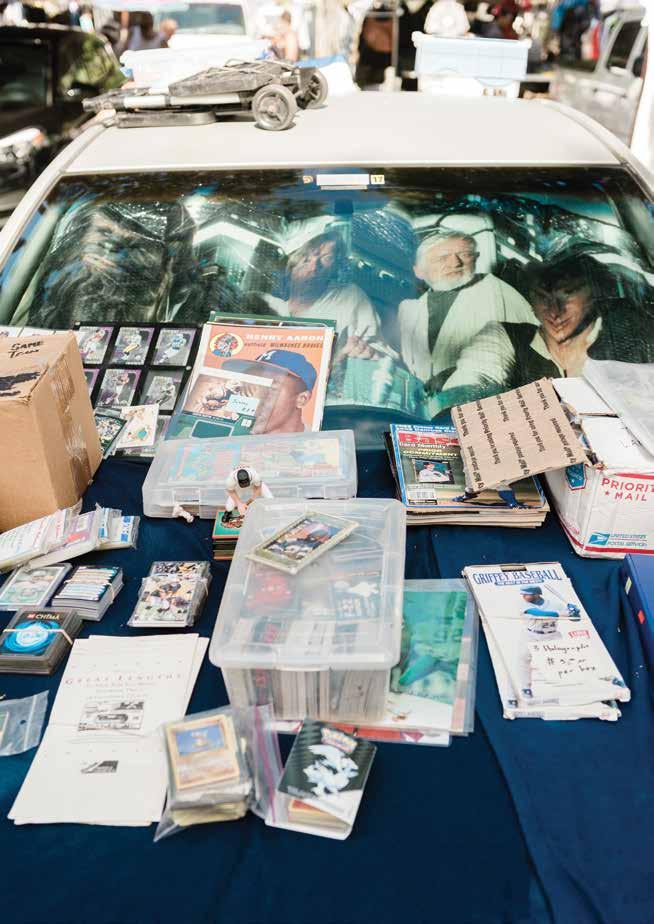
175
We threaded our way among the war-nostalgiaenthusiast sellers, with their collectible patches and push our way through the fellow aunties keeping a sharp eye out for dirtcheap fashion finds. There were the carnivallike salesmen, with their booming voices (“Adorable plush bunnies! Refunds if you find a cuter bunny anywhere!”) and stocks of actual merchandise, but then also booths composed of half-assed assemblages of tossed out household goods, someone’s on-the-go yard sale hastily collected the night before. A market fit for a medieval village.
For my mom’s part, she was hunting for that ever-elusive “perfect” deal. As any true bargain-hunter knows in their heart, the perfect deal is fundamentally unfindable. Like so many religious roadmaps to enlightenment, it’s a vehicle, a means to an end,
a lifetime commitment to the pursuit itself. There will never be a perfect deal, just as my mother will never stop going to swap meets. So it goes.
Except today. Today, we will find the perfect deal.
The challenge is that today we’re tasked with finding it for under $20. That puts us at a serious disadvantage. It means right off the bat we can’t even consider the $300 authentic porthole or that collection of longboards. It means the $75 globe made of, like, mosaiced marble, is out. (“At least for this challenge,” I point out. “We can still get it for ourselves.” I tell my husband to look for an ATM, to his dismay.)
It also means that my marriage is about to be tested. While my husband won’t stop harping on the benefits of getting a giant S-hook for the closet (could you be more boring, sir?) or a wooden fan for “when
The Aloha Stadium Swap Meet is a collection of kitschy tchotchkes and homemade li hing mui everything.
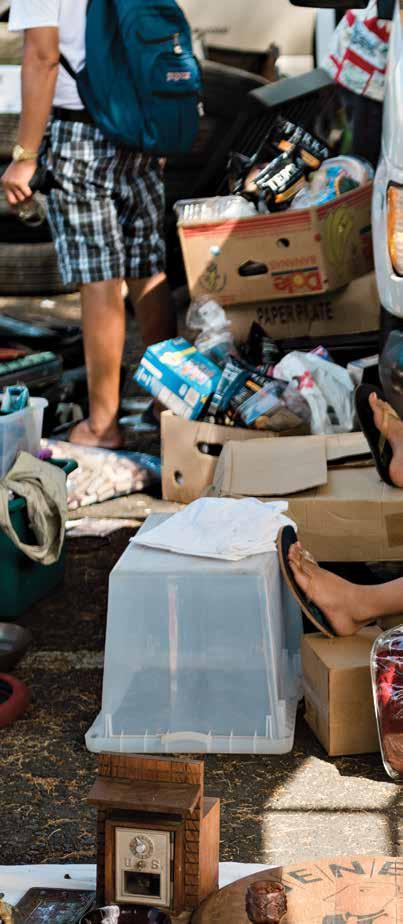
176 | FLUXHAWAII.COM


177
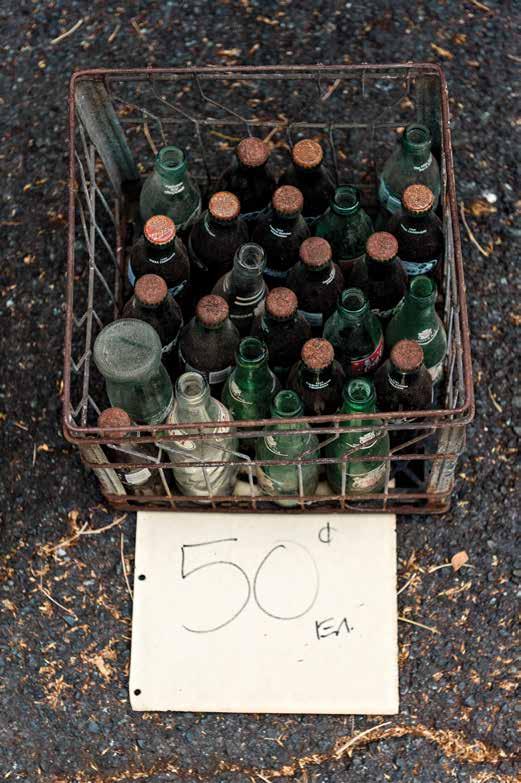
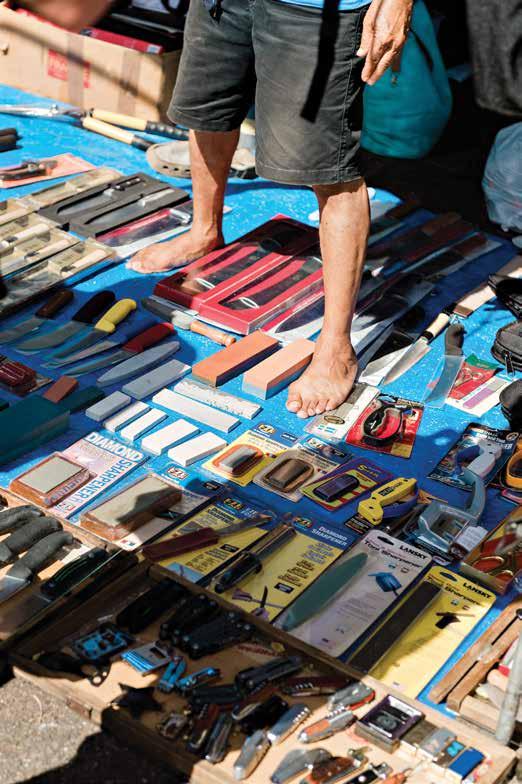

you start whining about getting heat stroke in 10 minutes,” I’m hemming and hawing over a hanging blowfish ornament made out of a shell and sporting a tiny straw hat, and a collection of vintage hatpins. (“You don’t own any hats,” protests my husband helplessly. I’m honestly wondering why I brought him at this point.)
Because the thing about the swap meet that pragmatists don’t understand is that it’s not about what we need. Why would I show up to a sweltering desert of a parking lot to hunt through a hodgepodge of tents with a shopping list of household essentials? That’s what Target is for. The swap meet is about possibilities; the possibility of The Perfect Deal, a Rare Gem, a Blast to the Past. Two decades ago, I walked these hallowed concrete aisles eating ice-cold overripe plums, digging through piles of footwear until I found the coolest embroidered clogs in the style du jour of 1997. I scoured these booths for the perfect, doll-sized, red aloha-print shirt for my Ken doll—and found it! I got a custom,
airbrushed rainbow T-shirt that I wore into the ground.
The swap meet doesn’t peddle essentials. It peddles the building blocks of stories, collaborative fantasies, the potential in the banal for the extraordinary and fantastical.
“No, Natalie. Those are just playing cards.” ($5)
Are they, husband? Or are these vintage Pan Am and RCA decks reminders of a dreamy ’60s past? Or is it more personal: Are they reminders of a dear friend of mine, now lost, who used to collect vintage joker cards? Perhaps I will see him again one day and give him the jokers from these.
“Those are just some old military markers.” ($10)
Are they? Or are they ominous relics of a narrative of violence? A miniature timeline showing the development of history, how we’ve grown and how we haven’t, what we’ve learned and what we haven’t? Does classic rock, now half a century old, play when I put my ear to them, or am I imagining it?
The possibility of scoring the perfect deal is what makes swap meets so enticing.
180 | FLUXHAWAII.COM
We
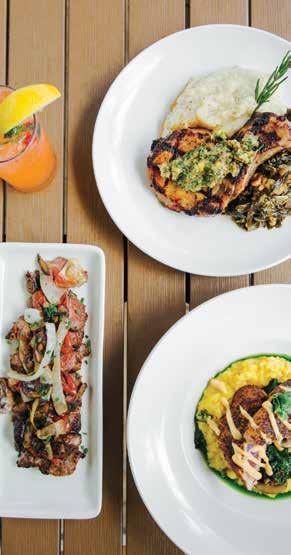
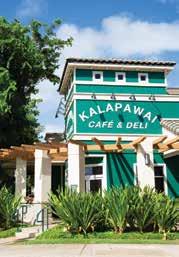

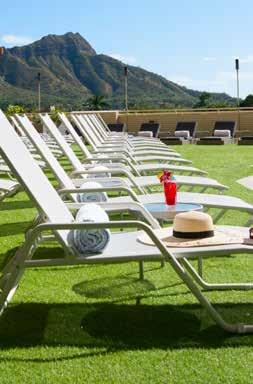
We kept all the best things. Our spectacular views of Diamond Head. A legacy of art and tradition. Cocktails at twilight. Aloha everywhere. Things that age well, and things that don’t age at all.
Everything else is brand shiny new.
So if you’re planning that staycation, there’s no better place than the newly renovated Queen Kapi‘olani Hotel.
Experience bistro-style comfort food for a healthy lifestyle.
(Left) Dragon Berry Lemonday, (Right) Old School Fashioned
Located in Kailua Beach 808 262 4359 Kailua Town 808 262 3354 Kapolei 808 674 1700 Visit us on social media and at kalapawaimarket.com.
Dragon Berry Lemonade; Fire-roasted Golden BBQ Sauce Double-cut Pork Chop; Auction Fresh Fish (lemongrass risotto); New York Steak.
pride ourselves on craftsmanship and quality local ingredients. BOOK NOW THE CHAIRS ARE NEW. THE VIEW, TIMELESS.
Where Diamond Head Meets Waikīkī 150 Kapahulu Avenue, Honolulu, Hawai‘i Call: 808-922-1941 QueenKapiolani.com
“Ok, well, that’s just a mountain apple tree.” ($3)
Our future orchard, you mean. Our future fruitbearing, mountain-applegiving family member. The tree that will give us shade; the tree that will teach our children about growing food, about the magic of summer fruit season, about the importance of watering your garden.
“Natalie, seriously. That really is just a stupid blowfish ornament.” ($2) OK, you’re right there. But how can you resist that adorable little straw hat?
Swap meets are a place where the banal can become fantastical.

182 | FLUXHAWAII.COM


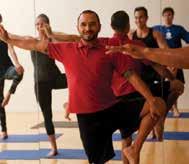


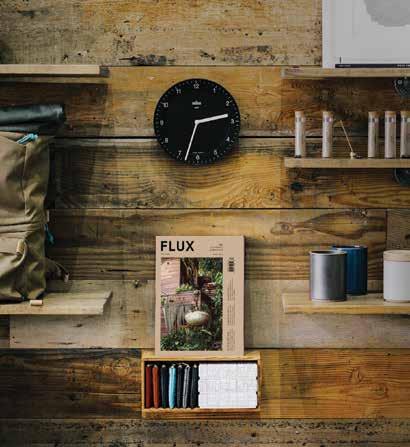
Our stories, in-store. Pick up a copy at any of these local locations. Find at your nearest store: fluxhawaii.com/stockists DA SHOP @dashophnl FISHCAKE @fishcakehawaii HOUND & QUAIL @houndandquail HUNTER GATHERER @huntergathererkauai KEALOPIKO @the_kealopikoshop KONA FRAME SHOP @konaframeshop MILO @milohawaii MŌNO HAWAII @monohawaii MORI ART & FLEA @mori_hawaii THE PUBLIC PET @thepublicpet OLIVE BOUTIQUE @olive_boutique SALVAGE PUBLIC @salvagepublic Honolulu Club 932 Ward Avenue Honolulu, HI 96814 808 585 9626 Members enjoy 65,000 square feet of fitness excellence with the latest equipment, personal training, studio pilates, racquet sports, wellequipped locker rooms, over 100 fitness classes to choose from every week, outdoor pool deck, a therapeutic spa, an in-house bar and dining room and much more. Visit HonoluluClub.com for more information and to start your complimentary trial. NOW OPEN Introducing our brand new indoor climbing wall on our 5th floor gym level.
In the Wai
When teenagers feel uplifted, it’s a magical experience to witness them develop.
TEXT BY SONNY GANADEN
ILLUSTRATION BY SHAR TUIASOA
‘Ōlelo Hawai‘i, the Hawaiian language, has a way of doubling a word to produce another with a multitude of meanings. Waiwai, the Hawaiian word for wealth, has its roots in the abundance of wai, or water—access to streams and the sea in the Pacific has long been a source of power. Wai, the common term for freshwater, is even incorporated into the word for law, kānāwai. Waiwai, meaning wealth, can describe a person, a community, or a relationship.
I spent the summer reckoning with the relativity of wealth—the opportunities it can deliver or deny young people, how it can be defined beyond money. In Kalihi, I taught a civics course to high school students in Waiwai Health Fellowship program, which contextualizes the health of its youth fellows within the health of their families and the community. The program was developed by nonprofit Kokua Kalihi Valley, informed by writings of educators Paulo Freire and Michael D. James, to empower youth to advance their health by developing tools needed for the lives and professions of their choice. What my role meant in practice was teaching writing and storytelling workshops, sitting on a mat with the kids or working through assignments. Most of the students were from immigrant, minority, and Pacific Islander families that fall below the federal poverty line, whose public schools do not center their identities or experiences. We discussed mental health, nourishing eating habits, self-care, and self-respect.
As an adult, it’s easy to forget how wretched it was being a teenager, how even the popular kids cope with changing bodies and notions of self in a world
that renders them powerless. Over the duration of the program, courses modeled sustainability, food and land sovereignty, and how to deconstruct cultural amnesia, which youth fellows did daily in “healing circles,” sharing their names, their homes, and ancestors they were bringing to the conversation. The circles were often awkward as hell for the kids.
But, when kids feel comfortable, it’s an almost magical experience to witness them develop. A girl who only spoke to her sister at the program’s start was reciting poetry at graduation. A boy who moved from the Philippine province of Ilocos Norte and could barely speak English a year ago finished the summer knowing the lyrics to songs on the radio. Most of the kids returned to school with loose ideas of what kind of lives they might lead if they work hard and get a bit of luck. I learned a new role, a version of an older brother—a “kuya” in Tagalog—more of a family guide than teacher. The kids showed me dance moves from video games and YouTube and helped me remember that nobody chooses the circumstances of their childhood. Yet, despite age or income, ability or illness, life is still made of innumerable choices. Like the land made fertile with streams, stories are the basis of wealth, overflowing with infinite possibilities.

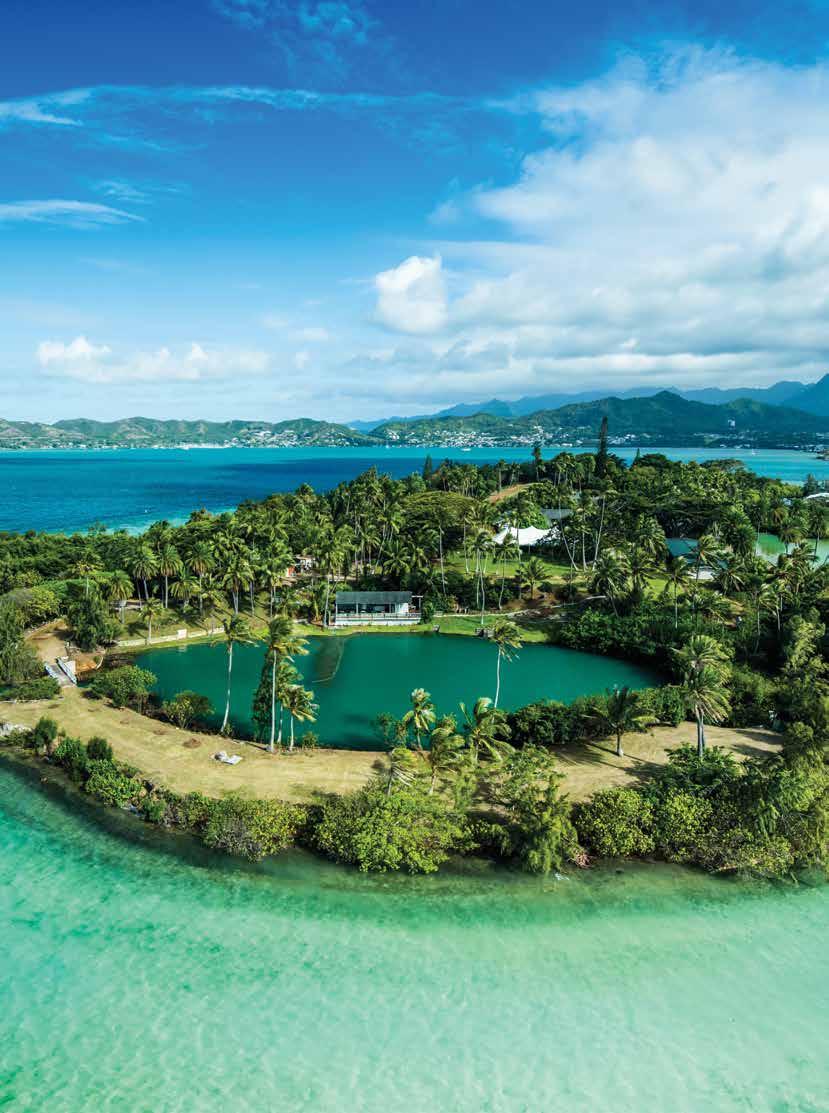
| A HUI HOU | 184 | FLUXHAWAII.COM

ALWAYS STRESS FREE WHEN YOU P.A.C. IT cameronbrooksart.com HNL NON-STOP LAX B747-400 All Cargo Ships Six Days/Week Next Day Service VIP Pet Service Oversize Items From Aston Martins and Outsize Cartons, to Polo Ponies and Man’s Best Friend. PACIFICAIRCARGO.COM 808-834-7977





























































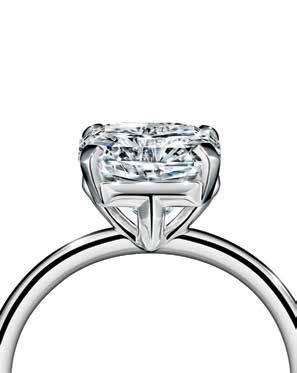




 KEIRA KNIGHTLEY WEARS A COCO CRUSH RING AND BRACELETS IN 18K WHITE GOLD* WITH DIAMONDS AND 18K BEIGE GOLD.
ALA MOANA CENTER LUXURY ROW ©2019 CHANEL ,® Inc.
*White gold plated with thin layer of Rhodium for color.
KEIRA KNIGHTLEY WEARS A COCO CRUSH RING AND BRACELETS IN 18K WHITE GOLD* WITH DIAMONDS AND 18K BEIGE GOLD.
ALA MOANA CENTER LUXURY ROW ©2019 CHANEL ,® Inc.
*White gold plated with thin layer of Rhodium for color.

























 Travis Hancock
Travis Hancock










 A window looking out to a field of sugarcane.
A window looking out to a field of sugarcane.
 Relaxing by the stream.
Relaxing by the stream.






















































































































 FLUX FEATURE
FLUX FEATURE










 The only existing portrait of George Gilley, a Native Hawaiian whaler, in 1887. Photograph by Herbert L. Aldrich. Courtesy of the New Bedford Whaling Museum.
The only existing portrait of George Gilley, a Native Hawaiian whaler, in 1887. Photograph by Herbert L. Aldrich. Courtesy of the New Bedford Whaling Museum.

















 Images by Nani Welch Keli‘iho‘omalu.
Images by Nani Welch Keli‘iho‘omalu.

















 Kia‘i are answering the call of their lāhui. Above, protector Tee Seminavage. Image by Michelle Mishina.
Kia‘i are answering the call of their lāhui. Above, protector Tee Seminavage. Image by Michelle Mishina.
















 Model and muse Haumea. Image by Cheyne Kalai.
Model and muse Haumea. Image by Cheyne Kalai.


Image by Cheyne Kalai.
Image by Cheyne Kalai.







 Swimsuit by Mikoh Lei by Haumea
Swimsuit by Mikoh Lei by Haumea

 Mu‘umu‘u by Posh Pua Pareu by Acacia
Mu‘umu‘u by Posh Pua Pareu by Acacia
 Pareu by Tahiti Art Maohi Jewelry by Kalai Dress by Marina and Co.
Pareu by Tahiti Art Maohi Jewelry by Kalai Dress by Marina and Co.


 Mu‘umu‘u by Eimeo Jewelry by Kalai
Mu‘umu‘u by Eimeo Jewelry by Kalai
 Jewelry by Kalai
Pareu by Pacific Island Arts
Lei by Haumea
Jewelry by Kalai
Pareu by Pacific Island Arts
Lei by Haumea


 Pareu by an artisan in Tahiti Mu‘umu‘u by Eimeo
Pāpale by Kumu Keoua Nelsen
Pareu by an artisan in Tahiti Mu‘umu‘u by Eimeo
Pāpale by Kumu Keoua Nelsen





 The sun-dappled home of the late Jean Charlot. Image by John Hook.
The sun-dappled home of the late Jean Charlot. Image by John Hook.







 Charlot painted the mural in collaboration with Hawai‘i artist Juliette May Fraser.
Charlot painted the mural in collaboration with Hawai‘i artist Juliette May Fraser.



















































 One of its founders, Tanouye Roshi, came to Buddhism by way of martial arts. As a result, Chozen-ji places an unusual emphasis on physical training.
One of its founders, Tanouye Roshi, came to Buddhism by way of martial arts. As a result, Chozen-ji places an unusual emphasis on physical training.







 The cliffs of Madeira. Image by Lili Kovac.
The cliffs of Madeira. Image by Lili Kovac.




 Image by Simon Marsault.
Image by Simon Marsault.
 Image by Said Karlsson.
Image by Said Karlsson.


 Image by Chris Slupski.
Image by Chris Slupski.
























